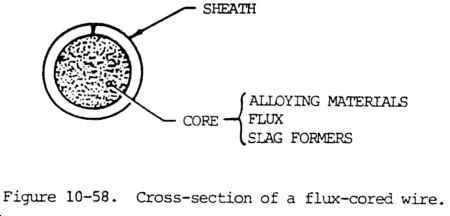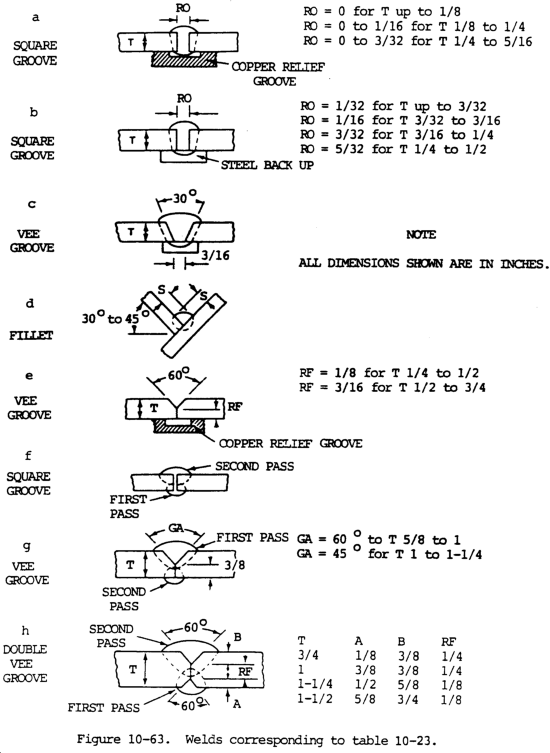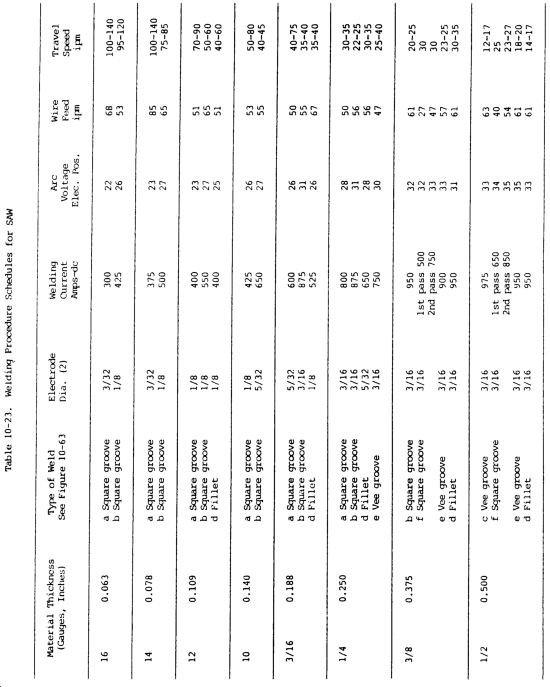CHAPTER 10
ARC WELDING AND CUTTING PROCESS
Section I. GENERAL
10-1. DEFINITION OF ARC WELDING
a. Definition. In the arc welding process, the weld is produced by the extreme heat of an electric arc drawn between an electrode and the workpiece, or in some cases, between two electrodes. Welds are made with or without the application of pressure and with or without filler metals. Arc welding processes may be divided into two classes based on the type of electrode used: metal electrodes and carbon electrodes. Detailed descriptions of the various processes may be found in chapter 6, paragraph 6-2.
(1) Metal electrodes. Arc welding processes that fall into this category include bare metal-arc welding, stud welding, gas shielded stud welding, submerged arc welding, gas tungsten arc welding, gas metal-arc welding, shielded metal-arc welding, atomic hydrogen welding, arc spot welding, and arc seam welding.
(2) Carbon electrodes. Arc welding processes that fall into this category include carbon-arc welding, twin carbon-arc welding, gas carbon-arc welding, and shielded carbon-arc welding.
b. Weld Metal Deposition.
(1) General. In metal-arc welding, a number of separate forces are responsible for the transfer of molten filler metal and molten slag to the base metal. These forces are described in (2) through (7) below.
(2) Vaporization and condensation. A small part of the metal passing through the arc, especially the metal in the intense heat at the end of the electrode, is vaporized. Some of this vaporized metal escapes as spatter, but most of it is condensed in the weld crater, which is at a much lower temperature. This occurs with all types of electrodes and in all welding positions.
(3) Gravity. Gravity affects the transfer of metal in flat position welding. In other positions, small electrodes must be used to avoid excessive loss of weld metal, as the surface tension is unable to retain a large amount of molten metal in the weld crater.
(4) Pinch effect. The high current passing through the molten metal at the tip of the electrode sets up a radial compressive magnetic force that tends to pinch the molten globule and detach it from the electrode.
(5) Surface tension. This force holds filler metal and the slag globules in contact with the molten base or weld metal in the crater. It has little to do with the transfer of metal across the arc, but is an important factor in retaining the molten weld metal in place and in the shaping of weld contours.
(6) Gas stream from electrode coatings. Gases are produced by the burning and volatilization of the electrode covering and are expanded by the heat of the boiling electrode tip. The velocity and movement of this gas stream give the small particles in the arc a movement away from the electrode tip and into the molten crater on the work.
(7) Carbon monoxide evolution from electrode. According to this theory of metal movement in the welding arc, carbon monoxide is evolved within the molten metal at the electrode tip, causing miniature explosions which expel molten metal away from the electrode and toward the work. This theory is substantiated by the fact that bare wire electrodes made of high purity iron or "killed steel" (i.e., steel that has been almost completely deoxidized in casting) cannot he used successfully in the overhead position. The metal transfer from electrode to the work, the spatter, and the crater formation are, in this theory, caused by the decarburizing action in molten steel.
c. Arc Crater. Arc craters are formed by the pressure of expanding gases from the electrode tip (arc blast), forcing the liquid metal towards the edges of the crater. The higher temperature of the center, as compared with that of the sides of the crater, causes the edges to cool first. Metal is thus drawn from the center to the edges, forming a low spot.
10-2. WELDING WITH CONSTANT CURRENT
The power source is the heart of all arc welding process. Two basic types of power sources are expressed by their voltage-ampere output characteristics. The constant current machine is considered in this paragraph. The other power source, the constant voltage machine, is discussed in paragraph 10-3. The static output characteristic curve produced by both sources is shown in figure 10-1. The characteristic curve of a welding machine is obtained by measuring and plotting the output voltage and the output current while statically loading the machine.
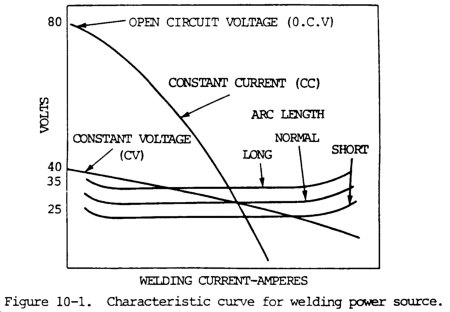
a. The conventional machine is known as the constant current (CC) machine, or the variable voltage type. The CC machine has the characteristic drooping volt-ampere curve, (fig. 10-1), and has been used for many years for the shielded metal arc welding process. A constant-current arc-welding machine is one which has means for adjusting the arc current. It also has a static volt-ampere curve that tends to produce a relatively constant output current. The arc voltage, at a given welding current, is responsive to the rate at which a consumable electrode is fed into the arc. When a nonconsumable electrode is used, the arc voltage is responsive to the electrode-to-work distance. A constant-current arc-welding machine is usually used with welding processes which use manually held electrodes, continuously fed consumable electrodes, or nonconsumable electrodes. If the arc length varies because of external influences, and slight changes in the arc voltage result, the welding current remains constant.
b. The conventional or constant current (CC) type power source may have direct current or alternating current output. It is used for the shielded metal-arc welding process, carbon arc welding and gouging, gas tungsten arc welding, and plasma arc welding. It is used for stud welding and can be used for the continuous wire processes when relatively large electrode wires are used.
c. There are two control systems for constant current welding machines: the single-control machine and the dual-control machine.
(1) The single-control machine has one adjustment which changes the current output from minimum to maximum, which is usually greater than the rated output of the machine. The characteristic volt-ampere curve is shown by figure 10-2. The shaded area is the normal arc voltage range. By adjusting the current control, a large number of output curves can be obtained. The dotted lines show intermediate adjustments of the machine. With tap or plug-in machines, the number of covers will correspond to the number of taps or plug-in combinations available. Most transformer and transformer-rectifier machines are single-control welding machines.
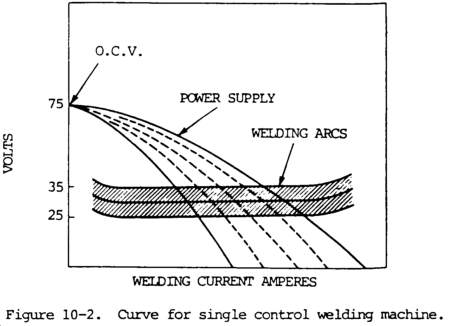
(2) Dual control machines have both current and voltage controls. They have two adjustments, one for coarse-current control and the other for fine-current control, which also acts as an open-circuit voltage adjustment. Generator welding machines usually have dual controls. They offer the welder the most flexibility for different welding requirements. These machines inherently have slope control. The slope of the characteristic curve can be changed from a shallow to a steep slope according to welding requirements. Figure 10-3 shows some of the different curves that can be obtained. Other curves are obtained with intermediate open-circuit voltage settings. The slope is changed by changing the open-circuit voltage with the fine-current control adjustment knob. The coarse adjustment sets the current output of the machine in steps from the minimum to the maximum current. The fine-current control will change the open-circuit voltage from approximately 55 volts to 85 volts. However, when welding, this adjustment does not change arc voltage. Arc voltage is controlled by the welder by changing the length of the welding arc. The open-circuit voltage affects the ability to strike an arc. If the open-circuit voltage is much below 60 volts, it is difficult to strike an arc.
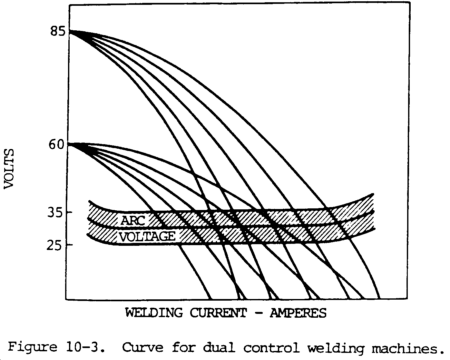
(a) The different slopes possible with a dual-control machine have an important effect on the welding characteristic of the arc. The arc length can vary, depending on the welding technique. A short arc has lower voltage and the long arc has higher voltage. With a short arc (lower voltage), the power source produces more current, and with a longer arc (higher voltage), the power source provides less welding current. This is illustrated by figure 10-4, which shows three curves of arcs and two characteristic curves of a dual-control welding machine. The three arc curves are for a long arc, a normal arc, and the lower curve is for a short arc. The intersection of a curve of an arc and a characteristic curve of a welding machine is known as an operating point. The operating point changes continuously during welding. While welding, and without changing the control on the machine, the welder can lengthen or shorten the arc and change the arc voltage from 35 to 25 volts. With the same machine setting, the short arc (lower voltage) is a high-current arc. Conversely, the long arc (high voltage) is a lower current arc. This allows the welder to control the size of the molten puddle while welding. When the welder purposely and briefly lengthens the arc, the current is reduced, the arc spreads out, and the puddle freezes quicker. The amount of molten metal is reduced, which provides the control needed for out-of-position work. This type of control is built into conventional constant current type of machine, single-or dual-control, ac or dc.
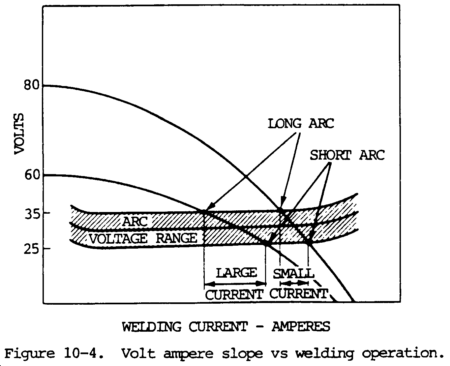
(b) With the dual-control machine, the welder can adjust the machine for more or less change of current for a given change of arc voltage. Both curves in figure 10-4 are obtained on a dual-control machine by adjusting the fine control knob. The top curve shows an 80-volt open-circuit voltage and the bottom curve shows a 60-volt open-circuit voltage. With either adjustment, the voltage and current relationship will stay on the same curve or line. Consider first the 80-volt open-circuit curve which produces the steeper slope. When the arc is long with 35 volts and is shortened to 25 volts, the current increases. This is done without touching the machine control. The welder manipulates the arc. With the flatter, 60-volt open-circuit curve, when the arc is shortened from 35 volts to 25 volts, the welding current will increase almost twice as much as it did when following the 80-volt open-circuit curve. The flatter slope curve provides a digging arc where an equal change in arc voltage produces a greater change in arc current. The steeper slope curve has less current change for the same change in arc length and provides a softer arc. There are many characteristic curves between the 80 and 60 open circuit voltage curves, and each allows a different current change for the same arc voltage change. This is the advantage of a dual-control welding machine over a single-control type, since the slope of the curve through the arc voltage range is adjustable only on a dual-control machine. The dual-control generator welding machine is the most flexible of all types of welding power sources, since it allows the welder to change to a higher-current arc for deep penetration or to a lower-current, less penetrating arc by changing the arc length. This ability to control the current in the arc over a fairly wide range is extremely useful for making pipe welds.
d. The rectifier welding machine, technically known as the transformer-rectifier, produces direct current for welding. These machines are essentially single-control machines and have a static volt ampere output characteristic curve similar to that shown in figure 10-4 above. These machines, though not as flexible as the dual-control motor generator, can be used for all types of shielded metal arc welding where direct current is required. The slope of the volt-ampere curve through the welding range is generally midway between the maximum and minimum of a dual-control machine.
e. Alternating current for welding is usually produced by a transformer type welding machine, although engine-driven alternating current generator welding machines are available for portable use. The static volt ampere characteristic curve of an alternating current power source the same as that shown in figure 10-4 above. Some transformer welding power sources have fine and coarse adjustment knobs, but these are not dual control machines unless the open-circuit voltage is changed appreciably. The difference between alternating and direct current welding is that the voltage and current pass through zero 100 or 120 times per second, according to line frequency or at each current reversal. Reactance designed into the machine causes a phase shift between the voltage and current so that they both do not go through zero at the same instant. When the current goes through zero, the arc is extinguished, but because of the phase difference, there is voltage present which helps to re-establish the arc quickly. The degree of ionization in the arc stream affects the voltage required to re-establish the arc and the overall stability of the arc. Arc stabilizers (ionizers) are included in the coatings of electrodes designed for ac welding to provide a stable arc.
f. The constant-current type welding machine can be used for some automatic welding processes. The wire feeder and control must duplicate the motions of the welder to start and maintain an arc. This requires a complex system with feedback from the arc voltage to compensate for changes in the arc length. The constant-current power supplies are rarely used for very small electrode wire welding processes.
g. Arc welding machines have been developed with true constant-current volt-ampere static characteristics, within the arc voltage range, as shown by figure 10-5. A welder using this type of machine has little or no control over welding current by shortening or lengthening the arc, since the welding current remains the same whether the arc is short or long. This is a great advantage for gas tungsten current by shortening or lengthening the arc, since the welding current remains the same whether the arc is short or long. This is a great advantage for gas tungsten arc welding, since the working arc length of the tungsten arc is limited. In shield metal-arc welding, to obtain weld puddle control, it is necessary to be able to change the current level while welding. This is done by the machine, which can be programmed to change from a high current (HC) to a low current (LC) on a repetitive basis, known as pulsed welding. In pulsed current welding there are two current levels, the high current and low current, sometimes called background current. By programming a control circuit, the output of the machine continuously switches from the high to the low current as shown in figure 10-6. The level of both high and low current is adjustable. In addition, the length of time for the high and low current pulses is adjustable. This gives the welder the necessary control over the arc and weld puddle. Pulsed current welding is useful for shielded metal-arc welding of pipe when using certain types of electrodes. Pulsed arc is very useful when welding with the gas tungsten arc welding process.
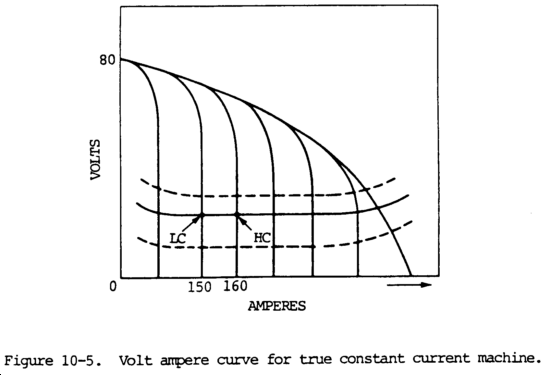
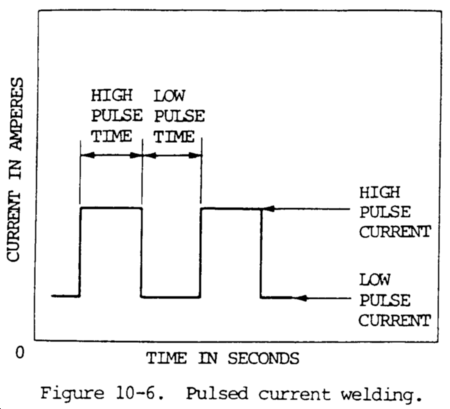
10-3. WELDING WITH CONSTANT VOLTAGE
The second type of power source is the constant voltage (CV) machine or the constant potential (CP) machine. It has a relatively flat volt-ampere characteristic curve.
a. The static output characteristic curve produced by both the CV and CC machine is shown by figure 10-1 above. The characteristic curve of a welding machine is obtained by measuring and plotting the output voltage and the output current while statically loading the machine. The constant voltage (CV) characteristic curve is essentially flat but with a slight droop. The curve may be adjusted up and down to change the voltage; however, it will never rise to as high an open-circuit voltage as a constant current (CC) machine. This is one reason that the constant voltage (CV) machine is not used for manual shielded metal arc welding with covered electrodes. It is only used for continuous electrode wire welding. The circuit consists of a pure resistance load which is varied from the minimum or no load to the maximum or short circuit. The constant current (CC) curve shows that the machine produces maximum output voltage with no load, and as the load increases, the output voltage decreases. The no-load or open-circuit voltage is usually about 80 volts.
b. The CV electrical system is the basis of operation of the entire commercial electric power system. The electric power delivered to homes and available at every receptacle has a constant voltage. The same voltage is maintained continuously at each outlet whether a small light bulb, with a very low wattage rating, or a heavy-duty electric heater with a high wattage rating, is connected. The current that flows through each of these circuits will be different based on the resistance of the particular item or appliance in accordance with Ohm�s law. For example, the small light bulb will draw less than 0.01 amperes of current while the electric heater may draw over 10 amperes. The voltage throughout the system remains constant, but the current flowing through each appliance depends on its resistance or electrical load. The same principle is utilized by the CV welding system.
c. When a higher current is used when welding, the electrode is melted off more rapidly. With low current, the electrode melts off slower. This relationship between melt-off rate and welding current applies to all of the arc welding processes that use a continuously fed electrode. This is a physical relationship that depends upon the size of the electrode, the metal composition, the atmosphere that surrounds the arc, and welding current. Figure 10-7 shows the melt-off rate curves for different sizes of steel electrode wires in a C02 atmosphere. Note that these curves are nearly linear, at least in the upper portion of the curve. Similar curves are available for all sizes of electrode wires of different compositions and in different shielding atmospheres. This relationship is definite and fixed, but some variations can occur. This relationship is the basis of the simplified control for wire feeding using constant voltage. Instead of regulating the electrode wire feed rate to maintain the constant arc length, as is done when using a constant current power source, the electrode wire is fed into the arc at a fixed speed. The power source is designed to provide the necessary current to melt off the electrode wire at this same rate. This concept prompted the development of the constant voltage welding power source.

d. The volt-ampere characteristics of the constant voltage power source shown by figure 10-8, was designed to produce substantially the same voltage at no load and at rated or full load. It has characteristics similar to a standard commercial electric power generator. If the load in the circuit changes, the power source automatically adjusts its current output to satisfy this requirement, and maintains essentially the same voltage across the output terminals. This ensures a self-regulating voltage power source.
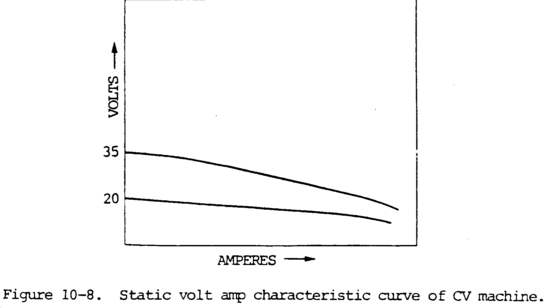
e. Resistances or voltage drops occur in the welding arc and in the welding cables and connectors, in the welding gun, and in the electrode length beyond the current pickup tip. These voltage drops add up to the output voltage of the welding machine, and represent the electrical resistance load on the welding power source. When the resistance of any component in the external circuit changes, the voltage balance will be achieved by changing the welding current in the system. The greatest voltage drop occurs across the welding arc. The other voltage drops in the welding cables and connections are relatively small and constant. The volt-age drop across the welding arc is directly dependent upon the arc length. A small change in arc volts results in a relatively large change in welding current. Figure 10-9 shows that if the arc length shortens slightly, the welding current increases by approximately 100 amperes. This change in arc length greatly increases the melt-off rate and quickly brings the arc length back to normal.
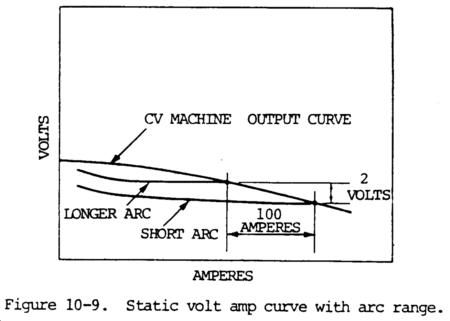
f. The constant voltage power source is continually changing its current output in order to maintain the voltage drop in the external portion of the welding circuit. Changes in wire feed speed which might occur when the welder moves the gun toward or away from the work are compensated for by changing the current and the melt-off rate briefly until equilibrium is re-established. The same corrective action occurs if the wire feeder has a temporary reduction in speed. The CV power source and fixed wire feed speed system is self-regulating. Movement of the cable assembly often changes the drag or feed rate of the electrode wire. The CV welding power source provides the proper current so that the malt-off is equal to the wire feed rate. The arc length is controlled by setting the voltage on the power source. The welding current is controlled by adjusting the wire feed speed.
g. The characteristics of the welding power source must be designed to provide a stable arc when gas metal arc welding with different electrode sizes and metals and in different atmospheres. Most constant voltage power sources have taps or a means of adjusting the slope of the volt-ampere curve. A curve having a slope of 1-1/2 to 2 volts per hundred amperes is best for gas metal arc welding with nonferrous electrodes in inert gas, for submerged arc welding, and for flux-cored arc welding with larger-diameter electrode wires. A curve having a medium slope of 2 to 3 volts per hundred amperes is preferred for CO2 gas shielded metal arc welding and for small flux-cored electrode wires. A steeper slope of 3 to 4 volts per hundred amperes is recommended for short circuiting arc transfer. These three slopes are shown in figure 10-10. The flatter the curve, the more the current changes for an equal change in arc voltage.
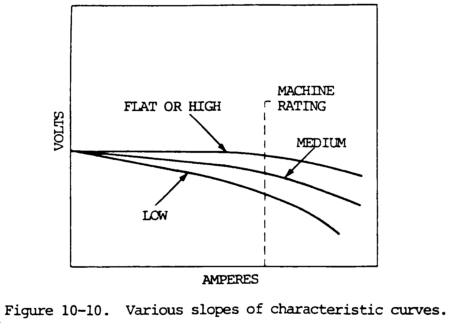
h. The dynamic characteristics of the power source must be carefully engineered. Refer again to figure 10-9. If the voltage changes abruptly with a short circuit, the current will tend to increase quickly to a very high value. This is an advantage in starting the arc but will create unwanted spatter if not controlled. It is controlled by adding reactance or inductance in the circuit. This changes the time factor or response time and provides for a stable arc. In most machines, a different amount of inductance is included in the circuit for the different slopes.
i. The constant voltage welding power system has its greatest advantage when the current density of the electrode wire is high. The current density (amperes/sq in.) relationship for different electrode wire sizes and different currents is shown by figure 10-11. There is a vast difference between the current density employed for gas metal arc welding with a fine electrode wire compared with conventional shielded metal arc welding with a covered electrode.
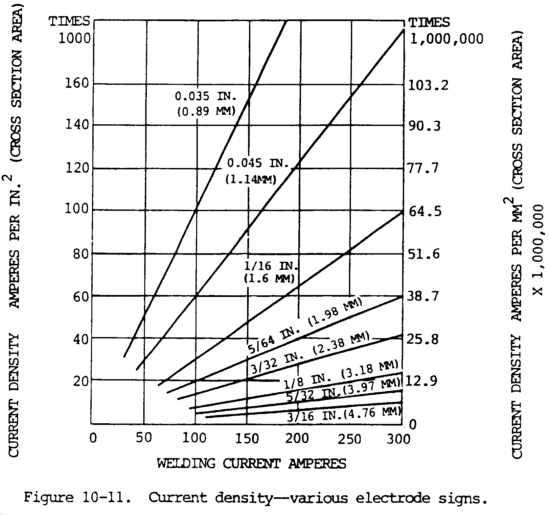
j. Direct current electrode positive (DCEP) is used for gas metal arc welding. When dc electrode negative (DCEN) is used, the arc is erratic and produces an inferior weld. Direct current electrode negative (DCEN) can be used for submerged arc welding and flux-cored arc welding.
k. Constant voltage welding with alternating current is normally not used. It can be used for submerged arc welding and for electroslag welding.
l. The constant voltage power system should not be used for shielded metal-arc welding. It may overload and damage the power source by drawing too much current too long. It can be used for carbon arc cutting and gouging with small electrodes and the arc welding processes.
10-4. DC STRAIGHT AND REVERSE POLARITY WELDING
a. General. The electrical arc welding circuit is the same as any electrical circuit. In the simplest electrical circuits, there are three factors: current, or the flow of electricity; pressure, or the force required to cause the current to flow; and resistance, or the force required to regulate the flow of current.
(1) Current is a rate of flow and is measured by the amount of electricity that flows through a wire in one second. The term ampere denotes the amount of current per second that flows in a circuit. The letter I is used to designate current amperes.
(2) Pressure is the force that causes a current to flow. The measure of electrical pressure is the volt. The voltage between two points in an electrical circuit is called the difference in potential. This force or potential is called electromotive force or EMF. The difference of potential or voltage causes current to flow in an electrical circuit. The letter E is used to designate voltage or EMF.
(3) Resistance is the restriction to current flow in an electrical circuit. Every component in the circuit, including the conductor, has some resistance to current flow. Current flows easier through some conductors than others; that is, the resistance of some conductors is less than others. Resistance depends on the material, the cross-sectional area, and the temperature of the conductor. The unit of electrical resistance is the ohm. It is designated by the letter R.
b. Electrical circuits. A simple electrical circuit is shown by figure 10-12. This circuit includes two meters for electrical measurement: a voltmeter, and an ammeter. It also shows a symbol for a battery. The longer line of the symbol represents the positive terminal. Outside of a device that sets up the EMF, such as a generator or a battery, the current flows from the negative (-) to the positive (+). The arrow shows the direction of current flow. The ammeter is a low resistance meter shown by the round circle and arrow adjacent to the letter I. The pressure or voltage across the battery can be measured by a voltmeter. The voltmeter is a high resistance meter shown by the round circle and arrow adjacent to the letter E. The resistance in the circuit is shown by a zigzag symbol. The resistance of a resistor can be measured by an ohmmeter. An ohmmeter must never be used to measure resistance in a circuit when current is flowing.
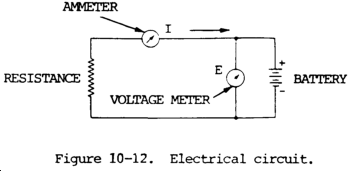
c. Arc Welding Circuit. A few changes to the circuit shown by figure 10-12, above, can be made to represent an arc welding circuit. Replace the battery with a welding generator, since they are both a source of EMF (or voltage), and replace the resistor with a welding arc which is also a resistance to current flow. The arc welding circuit is shown by figure 10-13. The current will flow from the negative terminal through the resistance of the arc to the positive terminal.
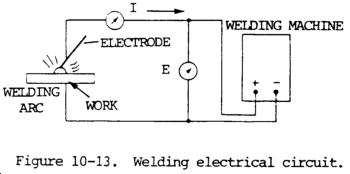
d. Reverse and Straight Polarity. In the early days of arc welding, when welding was done with bare metal electrodes on steel, it was normal to connect the positive side of the generator to the work and the negative side to the electrode. This provided 65 to 75 percent of the heat to the work side of the circuit to increase penetration. When welding with the electrode negative, the polarity of the welding current was termed straight. When conditions such as welding cast iron or nonferrous metals made it advisable to minimize the heat in the base metal, the work was made negative and the electrode positive, and the welding current polarity was said to be reverse. In order to change the polarity of the welding current, it was necessary to remove the cables from the machine terminals and replace them in the reverse position. The early coated electrodes for welding steel gave best results with the electrode positive or reverse polarity; however, bare electrodes were still used. It was necessary to change polarity frequently when using both bare and covered electrodes. Welding machines were equipped with switches that changed the polarity of the terminals and with dual reading meters. The welder could quickly change the polarity of the welding current. In marking welding machines and polarity switches, these old terms were used and indicated the polarity as straight when the electrode was negative, and reverse when the electrode was positive. Thus, electrode negative (DCEN) is the same as straight polarity (dcsp), and electrode positive (DCEP) is the same as reverse polarity (dcrp).
e. The ammeter used in a welding circuit is a millivoltmeter calibrated in amperes connected across a high current shunt in the welding circuit. The shunt is a calibrated, very low resistance conductor. The voltmeter shown in figure 10-12 will measure the welding machine output and the voltage across the arc, which are essentially the same. Before the arc is struck or if the arc is broken, the voltmeter will read the voltage across the machine with no current flowing in the circuit. This is known as the open circuit voltage, and is higher than the arc voltage or voltage across the machine when current is flowing.
f. Another unit in an electrical circuit is the unit of power. The rate of producing or using energy is called power, and is measured in watts. Power in circuit is the product of the current in amperes multiplied by the pressure in volts. Power is measured by a wattmeter, which is a combination of an ammeter and a voltmeter.
g. In addition to power, it is necessary to know the amount of work involved. Electrical work or energy is the product of power multiplied by time, and is expressed as watt seconds, joules, or kilowatt hours.
10-5. WELDING ARCS
a. General. The arc is used as a concentrated source of high temperature heat that can be moved and manipulated to melt the base metal and filler metal to produce welds.
b. Types of Welding Arcs. There are two basic types of welding arcs. One uses the nonconsumable electrode and the other uses the consumable electrode.
(1) The nonconsumable electrode does not melt in the arc and filler metal is not carried across the arc stream. The welding processes that use the nonconsumable electrode arc are carbon arc welding, gas tungsten arc welding, and plasma arc welding.
(2) The consumable electrode melts in the arc and is carried across the arc in a stream to become the deposited filler metal. The welding processes that use the consumable electrode arc are shielded metal arc welding, gas metal arc welding, flux-cored arc welding, and submerged arc welding.
c. Function of the Welding Arc.
(1) The main function of the arc is to produce heat. At the same time, it produces a bright light, noise, and, in a special case, bombardment that removes surface films from the base metal.
(2) A welding arc is a sustained electrical discharge through a high conducting plasma. It produces sufficient thermal energy which is useful for joining metals by fusion. The welding arc is a steady-state condition maintained at the gap between an electrode and workpiece that can carry current ranging from as low as 5 amperes to as high as 2000 amperes and a voltage as low as 10 volts to the highest voltages used on large plasma units. The welding arc is somewhat different from other electrical arcs since it has a point-to-plane geometric configuration, the point being the arcing end of the electrode and the plane being the arcing area of the workpiece. Whether the electrode is positive or negative, the arc is restricted at the electrode and spreads out toward the workpiece.
(3) The length of the arc is proportional to the voltage across the arc. If the arc length is increased beyond a certain point, the arc will suddenly go out. This means that there is a certain current necessary to sustain an arc of different lengths. If a higher current is used, a longer arc can be maintained.
(4) The arc column is normally round in cross section and is made up of an inner core of plasma and an outer flame. The plasma carries most of the current. The plasma of a high-current arc can reach a temperature of 5000 to 50,000° Kelvin. The outer flame of the arc is much cooler and tends to keep the plasma in the center. The temperature and the diameter of the central plasma depend on the amount of current passing through the arc, the shielding atmosphere, and the electrode size and type.
(5) The curve of an arc, shown by figure 10-14, takes on a nonlinear form which in one area has a negative slope. The arc voltage increases slightly as the current increases. This is true except for the very low-current arc which has a higher arc voltage. This is because the low-current plasma has a fairly small cross-sectional area, and as the current increases the cross section of the plasma increases and the resistance is reduced. The conductivity of the arc increases at a greater rate than simple proportionality to current.
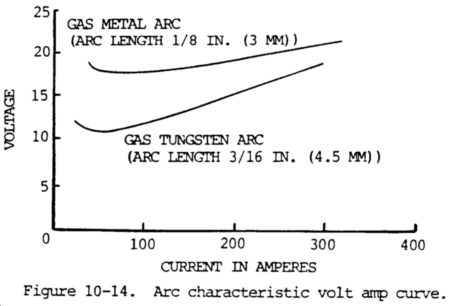
(6) The arc is maintained when electrons are emitted or evaporated from the surface of the negative pole (cathode) and flow across a region of hot electrically charged gas to the positive pole (anode), where they are absorbed. Cathode and anode are electrical terms for the negative and positive poles.
(7) Arc action can best be explained by considering the dc tungsten electrode arc in an inert gas atmosphere as shown by figure 10-15. On the left, the tungsten arc is connected for direct current electrode negative (DCEN). When the arc is started, the electrode becomes hot and emits electrons. The emitted electrons are attracted to the positive pole, travel through the arc gap, and raise the temperature of the argon shielding gas atoms by colliding with them. The collisions of electrons with atoms and molecules produce thermal ionization of some of the atoms of the shielding gas. The positively charged gaseous atoms are attracted to the negative electrode where their kinetic (motion) energy is converted to heat. This heat keeps the tungsten electrode hot enough for electron emission. Emission of electrons from the surface of the tungsten cathode is known as thermionic emission. Positive ions also cross the arc. They travel from the positive pole, or the work, to the negative pole, or the electrode. Positive ions are much heavier than the electrons, but help carry the current flow of the relatively low voltage welding arc. The largest portion of the current flow, approximately 99 percent, is via electron flow rather than through the flow of positive ions. The continuous feeding of electrons into the welding circuit from the power source accounts for the continuing balance between electrons and ions in the arc. The electrons colliding with the work create the intense localized heat which provides melting and deep penetration of the base metals.
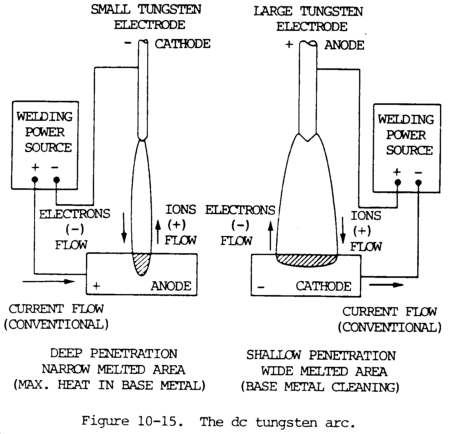
(8) In the dc tungsten to base metal arc in an inert gas atmosphere, the maximum heat occurs at the positive pole (anode). When the electrode is positive (anode) and the work is negative (cathode), as shown by figure 10-15, the electrons flow from the work to the electrode where they create intense heat. The electrode tends to overheat. A larger electrode with more heat-absorbing capacity is used for DCEP (dcsp) than for DCEN (dcrp) for the same welding current. In addition, since less heat is generated at the work, the penetration is not so great. One result of DCEP welding is the cleaning effect on the base metal adjacent to the arc area. This appears as an etched surface and is known as catholic etching. It results from positive ion bombardment. This positive ion bombardment also occurs during the reverse polarity half-cycle when using alternating current for welding.
(9) Constriction occurs in a plasma arc torch by making the arc pass through a small hole in a water-cooled copper nozzle. It is a characteristic of the arc that the more it is cooled the hotter it gets; however, it requires a higher voltage. By flowing additional gas through the small hole, the arc is further constricted and a high velocity, high temperature gas jet or plasma emerges. This plasma is used for welding, cutting, and metal spraying.
(10) The arc length or gap between the electrode and the work can be divided into three regions: a central region, a region adjacent to the electrode, and a region adjacent to the work. At the end regions, the cooling effect of the electrode and the work causes a rapid drop in potential. These two regions are known as the anode and cathode drop, according to the direction of current flow. The length of the central region or arc column represents 99 percent of the arc length and is linear with respect to arc voltage. Figure 10-16 shows the distribution of heat in the arc, which varies in these three regions. In the central region, a circular magnetic field surrounds the arc. This field, produced by the current flow, tends to constrict the plasma and is known as the magnetic pinch effect. The constriction causes high pressures in the arc plasma and extremely high velocities. This, in turn, produces a plasma jet. The speed of the plasma jet approaches sonic speed.
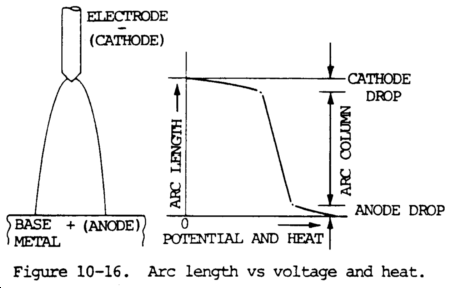
(11) The cathode drop is the electrical connection between the arc column and the negative pole (cathode). There is a relatively large temperature and potential drop at this point. The electrons are emitted by the cathode and given to the arc column at this point. The stability of an arc depends on the smoothness of the flow of electrons at this point. Tungsten and carbon provide thermic emissions, since both are good emitters of electrons. They have high melting temperatures, are practically nonconsumable, and are therefore used for welding electrodes. Since tungsten has the highest melting point of any metal, it is preferred.
(12) The anode drop occurs at the other end of the arc and is the electrical connection between the positive pole (anode) and the arc column. The temperature changes from that of the arc column to that of the anode, which is considerably lower. The reduction in temperature occurs because there are fewer ions in this region. The heat liberated at the anode and at the cathode is greater than that from the arc column.
d. Carbon Arc. In the carbon arc, a stable dc arc is obtained when the carbon is negative. In this condition, about 1/3 of the heat occurs at the negative pole (cathode), or the electrode, and about 2/3 of the heat occurs at the positive pole (anode), or the workpiece.
e. Consumable Electrode Arc. In the consumable electrode welding arc, the electrode is melted and molten metal is carried across the arc. A uniform arc length is maintained between the electrode and the base metal by feeding the electrode into the arc as fast as it melts. The arc atmosphere has a great effect on the polarity of maximum heat. In shielded metal arc welding, the arc atmosphere depends on the composition of the coating on the electrode. Usually the maximum heat occurs at the negative pole (cathode). When straight polarity welding with an E6012 electrode, the electrode is the negative pole (DCEN) and the melt-off rate is high. Penetration is minimum. When reverse polarity welding with an E6010 electrode (DCEP), the maximum heat still occurs at the negative pole (cathode), but this is now the base metal, which provides deep penetration. This is shown by figure 10-17. With a bare steel electrode on steel, the polarity of maximum heat is the positive pole (anode). Bare electrodes are operated on straight polarity (DCEN) so that maximum heat is at the base metal (anode) to ensure enough penetration. When coated electrodes are operated on ac, the same amount of heat is produced on each polarity of the arc.
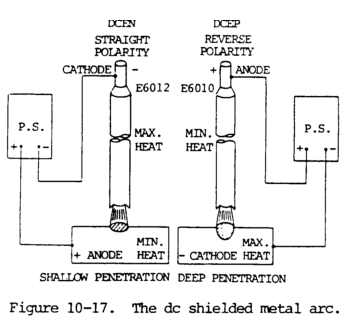
f. Consumable Electrode Arc.
(1) The forces that cause metal to transfer across the arc are similar for all the consumable electrode arc welding processes. The type of metal transfer dictates the usefulness of the welding process. It affects the welding position that can be used, the depth of weld penetration, the stability of the welding pool, the surface contour of the weld, and the amount of spatter loss. The metal being transferred ranges from small droplets, smaller than the diameter of the electrode, to droplets larger in diameter than the electrode. The type of transfer depends on the current density, the polarity of the electrode, the arc atmosphere, the electrode size, and the electrode composition.
(2) Several forces affect the transfer of liquid metal across an arc. These are surface tension, the plasma jet, gravity in flat position welding, and electromagnetic force.
(a) Surface tension of a liquid causes the surface of the liquid to contract to the smallest possible area. This tension tends to hold the liquid drops on the end of a melting electrode without regard to welding position. This force works against the transfer of metal across the arc and helps keep molten metal in the weld pool when welding in the overhead position.
(b) The welding arc is constricted at the electrode and spreads or flares out at the workpiece. The current density and the arc temperature are the highest where the arc is most constricted, at the end of the electrode. An arc operating in a gaseous atmosphere contains a plasma jet which flows along the center of the arc column between the electrode and the base metal. Molten metal drops in the process of detachment from the end of the electrode, or in flight, are accelerated towards the work piece by the plasma jet.
(c) Earth gravity detaches the liquid drop when the electrode is pointed downward and is a restraining force when the electrode is pointing upward. Gravity has a noticeable effect only at low currents. The difference between the mass of the molten metal droplet and the mass of the workpiece has a gravitational effect which tends to pull the droplet to the workpiece. An arc between two electrodes will not deposit metal on either.
(d) Electromagnetic force also helps transfer metal across the arc. When the welding current flows through the electrode, a magnetic field is set up around it. The electromagnetic force acts on the liquid metal drop when it is about to detach from the electrode. As the metal melts, the cross-sectional area of the electrode changes at the molten tip. The electromagnetic force depends upon whether the cross section is increasing or decreasing. There are two ways in which the electromagnetic force acts to detach a drop at the tip of the electrode. When a drop is larger in diameter than the electrode and the electrode is positive (DCEP), the magnetic force tends to detach the drop. When there is a constriction or necking down which occurs when the drop is about to detach, the magnetic force acts away from the point of constriction in both directions. The drop that has started to separate will be given a push which increases the rate of separation. Figure 10-18 illustrates these two points. Magnetic force also sets up a pressure within the liquid drop. The maximum pressure is radial to the axis of the electrode and at high currents causes the drop to lengthen. It gives the drop stiffness and causes it to project in line with the electrode regardless of the welding position.
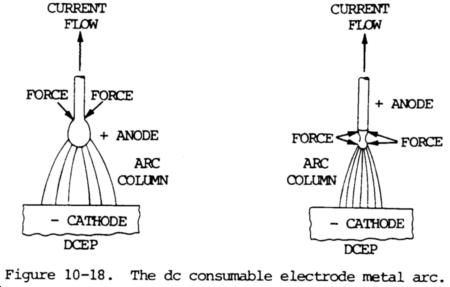
10-6. AC WELDING
a. General. Alternating current is an electrical current which flows back and forth at regular intervals in a circuit. When the current rises from zero to a maximum, returns to zero, increases to a maximum in the opposite direction, and finally returns to zero again, it is said to have completed one cycle.
(1) A cycle is divided into 360 degrees. Figure 10-19 is a graphical representation of a cycle and is called a sine wave. It is generated by one revolution of a single loop coil armature in a two-pole alternating current generator. The maximum value in one direction is reached at the 90° position, and in the other direction at the 270° position.
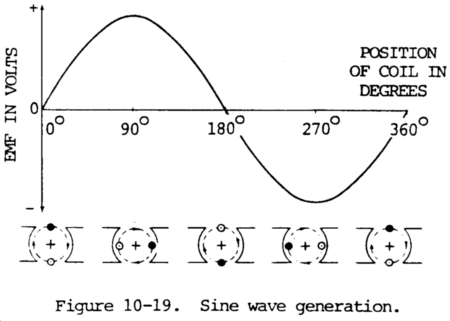
(2) The number of times this cycle is repeated in one second is called the frequency, measured in hertz.
b. Alternating current for arc welding normally has the same frequency as the line current. The voltage and current in the ac welding arc follow the sine wave and return to zero twice each cycle. The frequency is so fast that the arc appears continuous and steady. The sine wave is the simplest form of alternating current.
c. Alternating current and voltage are measured with ac meters. An ac voltmeter measures the value of both the positive and negative parts of the sine wave. It reads the effective, or root-mean-square (RMS) voltage. The effective direct current value of an alternating current or voltage is the product of 0.707 multiplied by the maximum value.
d. An alternating current has no unit of its own, but is measured in terms of direct current, the ampere. The ampere is defined as a steady rate of flow, but an alternating current is not a steady current. An alternating current is said to be equivalent to a direct current when it produces the same average heating effect under exactly similar conditions. This is used since the heating effect of a negative current is the same as that of a positive current. Therefore, an ac ammeter will measure a value, called the effective value, of an alternating current which is shown in amperes. All ac meters, unless otherwise marked, read effective values of current and voltage.
e. Electrical power for arc welding is obtained in two different ways. It is either generated at the point of use or converted from available power from the utility line. There are two variations of electrical power conversion.
(1) In the first variation, a transformer converts the relatively high voltages from the utility line to a liner voltage for ac welding.
(2) The second variation is similar in that it includes the transformer to lower the voltage, but it is followed by a rectifier which changes alternating current to direct current for dc welding.
f. With an alternating flow of current, the arc is extinguished during each half-cycle as the current reduces to zero, requiring reignition as the voltage rises again. After reignition, it passes, with increasing current, through the usual falling volts-amperes characteristic. As the current decreases again, the arc potential is lower because the temperature and degree of ionization of the arc path correspond to the heated condition of the plasma, anode, and cathode during the time of increasing current.
g. The greater the arc length, the less the arc gas will be heated by the hot electrode terminals, and a higher reignition potential will be required. Depending upon the thermal inertia of the hot electrode terminals and plasma, the cathode emitter may cool enough during the fall of the current to zero to stop the arc completely. When the electrode and welding work have different thermal inertia ability to emit electrons, the current will flow by different amounts during each half-cycle. This causes rectification to a lesser or greater degree. Complete rectification has been experienced in arcs with a hot tungsten electrode and a cold copper opposing terminal. Partial rectification of one half-cycle is common when using the TIG welding process with ac power.
10-7. MULTILAYER WELDING
a. Multiple layer welding is used when maximum ductility of a steel weld is desired or several layers are required in welding thick metal. Multiple layer welding is accomplished by depositing filler metal in successive passes along the joint until it is filled (fig. 10-20). Since the area covered with each pass is small, the weld puddle is reduced in size. This procedure enables the welder to obtain complete joint penetration without excessive penetration and overheating while the first few passes are being deposited. The smaller puddle is more easily controlled, and the welder can avoid oxides, slag inclusions, and incomplete fusion with the base metal.
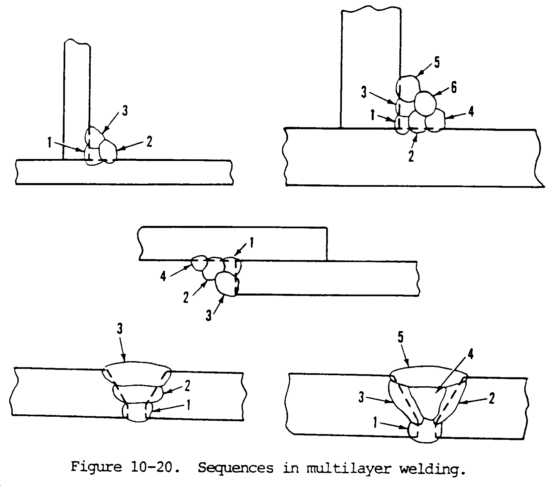
b. The multilayer method allows the welder to concentrate on getting good penetration at the root of the V in the first pass or layer. The final layer is easily controlled to obtain a good smooth surface.
c. This method permits the metal deposited in a given layer to be partly or wholly refined by the succeeding layers, and therefore improved in ductility. The lower layer of weld metal, after cooling, is reheated by the upper layer and then cooled again. In effect, the weld area is being heat treated. In work where this added quality is desired in the top layer of the welded joint, an excess of weld metal is deposited on the finished weld and then machined off. The purpose of this last layer is simply to provide welding heat to refine layer of weld metal.
Section II. ARC PROCESSES
10-8. SHIELDED METAL-ARC WELDING (SMAW)
a. General. This is the most widely used method for general welding applications. It is also refereed to as metallic arc, manual metal-arc, or stick-electrode welding. It is an arc welding process in which the joining of metals is produced by heat from an electric arc that is maintained between the tip of a covered electrode and the base metal surface of the joint being welded.
b. Advantages. The SMAW process can be used for welding most structural and alloy steels. These include low-carbon or mild steels; low-alloy, heat-treatable steels; and high-alloy steels such as stainless steels. SMAW is used for joining common nickel alloys and can be used for copper and aluminum alloys. This welding process can be used in all positions--flat, vertical, horizontal, or overhead--and requires only the simplest equipment. Thus, SMAW lends itself very well to field work (fig. 10-21).
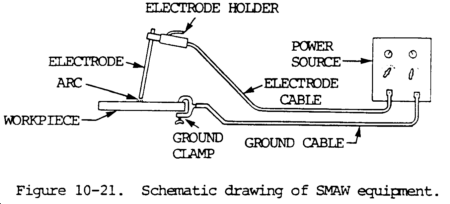
c. Disadvantages. Slag removal, unused electrode stubs, and spatter add to the cost of SMAW. Unused electrode stubs and spatter account for about 44 percent of the consumed electrodes. Another cost is the entrapment of slag in the form of inclusions, which may have to be removed.
d. Processes.
(1) The core of the covered electrode consists of either a solid metal rod of drawn or cast material, or one fabricated by encasing metal powders in a metallic sheath. The core rod conducts the electric current to the arc and provides filler metal for the joint. The electrode covering shields the molten metal from the atmosphere as it is transferred across the arc and improves the smoothness or stability of the arc.
(2) Arc shielding is obtained from gases which form as a result of the decomposition of certain ingredients in the covering. The shielding ingredients vary according to the type of electrode. The shielding and other ingredients in the covering and core wire control the mechanical properties, chemical composition, and metallurgical structure of the weld metal, as well as arc characteristics of the electrode.
(3) Shielded metal arc welding employs the heat of the arc to melt the base metal and the tip of a consumable covered electrode. The electrode and the work are part of an electric circuit known as the welding circuit, as shown in figure 10-22. This circuit begins with the electric power source and includes the welding cables, an electrode holder, a ground clamp, the work, and an arc welding electrode. One of the two cables from the power source is attached to the work. The other is attached to the electrode holder.
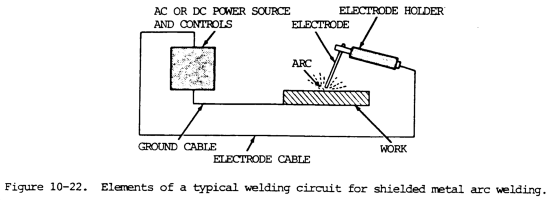
(4) Welding begins when an electric arc is struck between the tip of the electrode and the work. The intense heat of the arc melts the tip of the electrode and the surface of the work beneath the arc. Tiny globules of molten metal rapidly form on the tip of the electrode, then transfer through the arc stream into the molten weld pool. In this manner, filler metal is deposited as the electrode is progressively consumed. The arc is moved over the work at an appropriate arc length and travel speed, melting and fusing a portion of the base metal and adding filler metal as the arc progresses. Since the arc is one of the hottest of the commercial sources of heat (temperatures above 9000°F (5000°C) have been measured at its center), melting takes place almost instantaneously as the arc contacts the metal. If welds are made in either the flat or the horizontal position, metal transfer is induced by the force of gravity, gas expansion, electric and electromagnetic forces, and surface tension. For welds in other positions, gravity works against the other forces.
(a) Gravity. Gravity is the principal force which accounts for the transfer of filler metal in flat position welding. In other positions, the surface tension is unable to retain much molten metal and slag in the crater. Therefore, smaller electrodes must be used to avoid excessive loss of weld metal and slag. See figure 10-23.

(b) Gas expansion. Gases are produced by the burning and volatilization of the electrode coating, and are expanded by the heat of the boiling electrode tip. The coating extending beyond the metal tip of the electrode controls the direction of the rapid gas expansion and directs the molten metal globule into the weld metal pool formed in the base metal.
(c) Electromagnetic forces. The electrode tip is an electrical conductor, as is the molten metal globule at the tip. Therefore, the globule is affected by magnetic forces acting at 90 degrees to the direction of the current flow. These forces produce a pinching effect on the metal globules and speed up the separation of the molten metal from the end of the electrode. This is particularly helpful in transferring metal in horizontal, vertical, and overhead position welding.
(d) Electrical forces. The force produced by the voltage across the arc pulls the small, pinched-off globule of metal, regardless of the position of welding. This force is especially helpful when using direct-current, straight-polarity, mineral-coated electrodes, which do not produce large volumes of gas.
(e) Surface tension. The force which keeps the filler metal and slag globules in contact with molten base or weld metal in the crater is known as surface tension. It helps to retain the molten metal in horizontal, vertical, and overhead welding, and to determine the shape of weld contours.
e. Equipment. The equipment needed for shielded metal-arc welding is much less complex than that needed for other arc welding processes. Manual welding equipment includes a power source (transformer, dc generator, or dc rectifier), electrode holder, cables, connectors, chipping hammer, wire brush, and electrodes.
f. Welding Parameters.
(1) Welding voltage, current, and travel speed are very important to the quality of the deposited SMAW bead. Figures 10-24 thru 10-30 show the travel speed limits for the electrodes listed in table 10-1 below. Table 10-1 shows voltage limits for some SMAW electrodes.

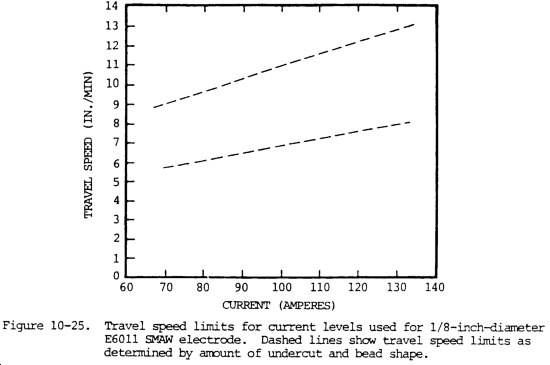
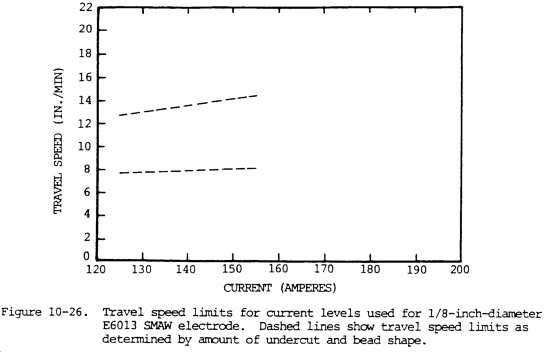
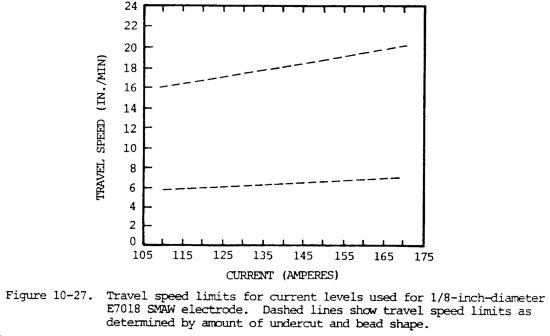
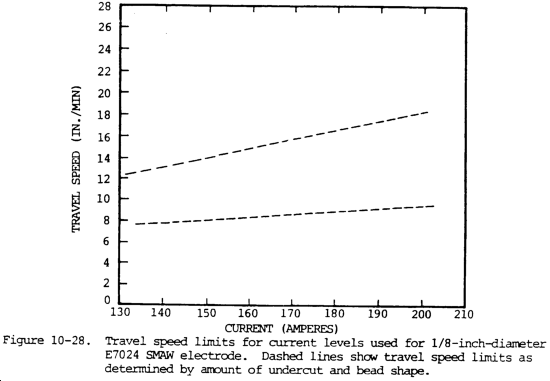
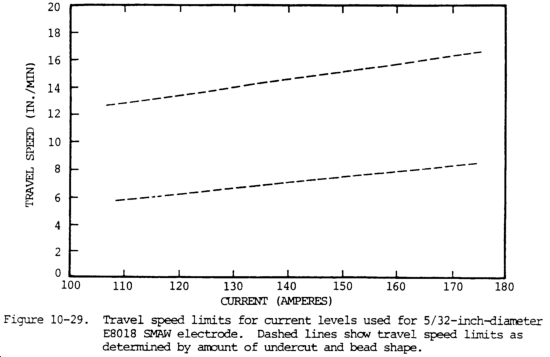
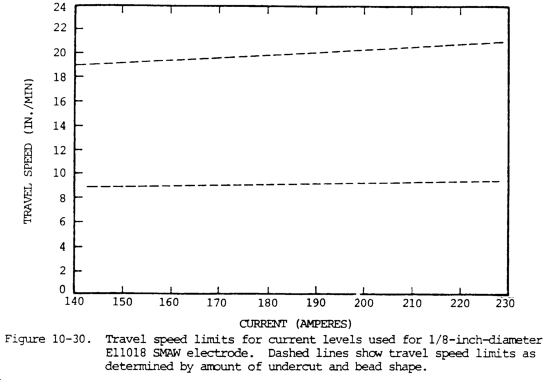
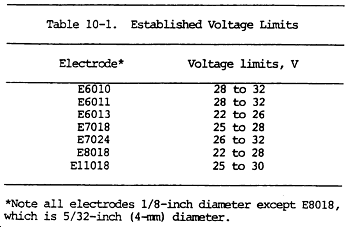
(2) The process requires sufficient electric current to melt both the electrode and a proper amount of base metal, and an appropriate gap between the tip of the electrode and base metal or molten weld pool. These requirements are necessary for coalescence. The sizes and types of electrodes for shielded metal arc welding define the arc voltage requirements (within the overall range of 16 to 40 V) and the amperage requirements (within the overall range of 20 to 550 A). The current may be either alternating or direct, but the power source must be able to control the current level in order to respond to the complex variables of the welding process itself.
g. Covered Electrodes. In addition to establishing the arc and supplying filler metal for the weld deposit, the electrode introduces other materials into or around the arc. Depending upon the type of electrode being used, the covering performs one or more of the following functions:
(1) Provides a gas to shield the arc and prevent excessive atmospheric contamination of the molten filler metal as it travels across the arc.
(2) Provides scavengers, deoxidizers, and fluxing agents to cleanse the weld and prevent excessive grain growth in the weld metal.
(3) Establishes the electrical characteristics of the electrode.
(4) Provides a slag blanket to protect the hot weld metal from the air and enhance the mechanical properties, bead shape, and surface cleanliness of the weld metal.
(5) Provides a means of adding alloying elements to change the mechanical properties of the weld metal.
Functions 1 and 4 prevent the pick-up of oxygen and nitrogen from the air by the molten filler metal in the arc stream and by the weld metal as it solidifies and cools.
The covering on shielded metal arc electrodes is applied by either the extrusion or the dipping process. Extrusion is much more widely used. The dipping process is used primarily for cast and some fabricated core rods. In either case, the covering contains most of the shielding, scavenging, and deoxidizing materials. Most SMAW electrodes have a solid metal core. Some are made with a fabricated or composite core consisting of metal powders encased in a metallic sheath. In this latter case, the purpose of some or even all of the metal powders is to produce an alloy weld deposit.
In addition to improving the mechanical properties of the weld metal, the covering on the electrode can be designed for welding with alternating current. With ac, the welding arc goes out and is reestablished each time the current reverses its direction. For good arc stability, it is necessary to have a gas in the arc stream that will remain ionized during each reversal of the current. This ionized gas makes possible the reignition of the arc. Gases that readily ionize are available from a variety of compounds, including those that contain potassium. It is the incorporation of these compounds in the electrode covering that enables the electrode to operate on ac.
To increase the deposition rate, the coverings of some carbon and low alloy steel electrodes contain iron powder. The iron powder is another source of metal available for deposition, in addition to that obtained from the core of the electrode. The presence of iron powder in the covering also makes more efficient use of the arc energy. Metal powders other than iron are frequently used to alter the mechanical properties of the weld metal.
The thick coverings on electrodes with relatively large amounts of iron powder increase the depth of the crucible at the tip of the electrode. This deep crucible helps contain the heat of the arc and maintains a constant arc length by using the "drag" technique. When iron or other metal powders are added in relatively large amounts, the deposition rate and welding speed usually increase. Iron powder electrodes with thick coverings reduce the level of skill needed to weld. The tip of the electrode can be dragged along the surface of the work while maintaining a welding arc. For this reason, heavy iron powder electrodes frequently are called "drag electrodes." Deposition rates are high; but because slag solidification is slow, these electrodes are not suitable for out-of-position use.
h. Electrode Classification System. The SMAW electrode classification code contains an E and three numbers, followed by a dash and either "15" or "16" (EXXX15). The E designates that the material is an electrode and the three digits indicate composition. Sometimes there are letters following the three digits; these letters indicate a modification of the standard composition. The "15" or "16" specifies the type of current with which these electrodes may be used. Both designations indicate that the electrode is usable in all positions: flat, horizontal, vertical and overhead.
(1) The "15" indicates that the covering of this electrode is a lime type, which contains a large proportion of calcium or alkaline earth materials. These electrodes are usable with dc reverse-polarity only.
(2) The designation "16" indicates electrodes that have a lime-or titania-type covering with a large proportion of titanium-bearing minerals. The coverings of these electrodes also contain readily ionizing elements, such as potassium, to stabilize the arc for ac welding.
i. Chemical Requirements. The AWS divides SMAW electrodes into two groups: mild steel and low-alloy steel. The E60XX and E70XX electrodes are in the mild steel specification. The chemical requirements for E70XX electrodes are listed in AWS A5.1 and allow for wide variations of composition of the deposited weld metal. There are no specified chemical requirements for the E60XX electrodes. The low-alloy specification contains electrode classifications E70XX through E120XX. These codes have a suffix indicating the chemical requirements of the class of electrodes (e. g., E7010-A1 or E8018-C1). The composition of low-alloy E70XX electrodes is controlled much more closely than that of mild steel E70XX electrodes. Low-alloy electrodes of the low-hydrogen classification (EXX15, EXX16, EXX18) require special handling to keep the coatings from picking up water. Manufacturers� recommendations about storage and rebaking must be followed for these electrodes. AWS A5.5 provides a specific listing of chemical requirements.
j. Weld Metal Mechanical Properties. The AWS requires the deposited weld metal to have a minimum tensile strength of 60,000 to 100,000 psi (413,700 to 689,500 kPa), with minimum elongations of 20 to 35 percent.
k. Arc Shielding.
(1) The arc shielding action, illustrated in figure 10-31, is essentially the same for the different types of electrodes, but the specific method of shielding and the volume of slag produced vary from type to type. The bulk of the covering materials in some electrodes is converted to gas by the heat of the arc, and only a small amount of slag is produced. This type of electrode depends largely upon a gaseous shield to prevent atmospheric contamination. Weld metal from such electrodes can be identified by the incomplete or light layer of slag which covers the bead.
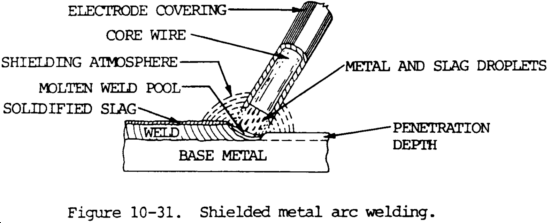
(2) For electrodes at the other extreme, the bulk of the covering is converted to slag by the arc heat, and only a small volume of shielding gas is produced. The tiny globules of metal transferred across the arc are entirely coated with a thin film of molten slag. This slag floats to the weld puddle surface because it is lighter than the metal. It solidifies after the weld metal has solidified. Welds made with these electrodes are identified by the heavy slag deposits that completely cover the weld beads. Between these extremes is a wide variety of electrode types, each with a different combination of gas and slag shielding.
(3) The variations in the amount of slag and gas shielding also influence the welding characteristics of the different types of covered electrodes. Electrodes that have a heavy slag carry high amperage and have high deposition rates. These electrodes are ideal for making large beads in the flat position. Electrodes that develop a gaseous arc shield and have a light layer of slag carry lower amperage and have lower deposition rates. These electrodes produce a smaller weld pool and are better suited for making welds in the vertical and overhead positions. Because of the differences in their welding characteristics, one type of covered electrode will usually be best suited for a given application.
10-9. GAS TUNGSTEN ARC (TIG) WELDING (GTAW)
a. General. Gas tungsten arc welding (TIG welding or GTAW) is a process in which the joining of metals is produced by heating therewith an arc between a tungsten (nonconsumable) electrode and the work. A shielding gas is used, normally argon. TIG welding is normally done with a pure tungsten or tungsten alloy rod, but multiple electrodes are sometimes used. The heated weld zone, molten metal, and tungsten electrode are shielded from the atmosphere by a covering of inert gas fed through the electrode holder. Filler metal may or may not be added. A weld is made by applying the arc so that the touching workpiece and filler metal are melted and joined as the weld metal solidifies. This process is similar to other arc welding processes in that the heat is generated by an arc between a nonconsumable electrode and the workpiece, but the equipment and electrode type distinguish TIG from other arc welding processes. See figure 10-32.
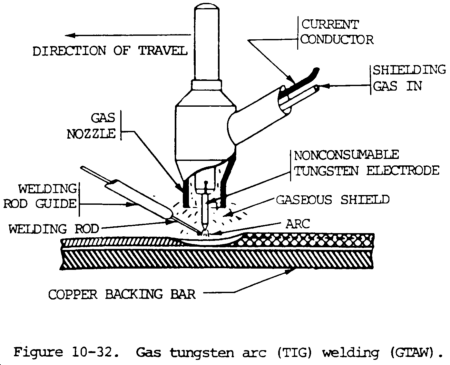
b. Equipment. The basic features of the equipment used in TIG welding are shown in figure 10-33. The major components required for TIG welding are:
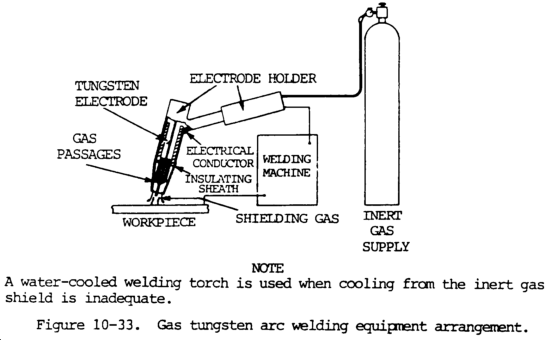
(1) the welding machine, or power source
(2) the welding electrode holder and the tungsten electrode
(3) the shielding gas supply and controls
(4) Several optional accessories are available, which include a foot rheostat to control the current while welding, water circulating systems to cool the electrode holders, and arc timers.
There are ac and dc power units with built-in high frequency generators designed specifically for TIG welding. These automatically control gas and water flow when welding begins and ends. If the electrode holder (torch) is water-cooled, a supply of cooling water is necessary. Electrode holders are made so that electrodes and gas nozzles can readily be changed. Mechanized TIG welding equipment may include devices for checking and adjusting the welding torch level, equipment for work handling, provisions for initiating the arc and controlling gas and water flow, and filler metal feed mechanisms.
c. Advantages. Gas tungsten arc welding is the most popular method for welding aluminum stainless steels, and nickel-base alloys. It produces top quality welds in almost all metals and alloys used by industry. The process provides more precise control of the weld than any other arc welding process, because the arc heat and filler metal are independently controlled. Visibility is excellent because no smoke or fumes are produced during welding, and there is no slag or spatter that must be cleaned between passes or on a completed weld. TIG welding also has reduced distortion in the weld joint because of the concentrated heat source. The gas tungsten arc welding process is very good for joining thin base metals because of excellent control of heat input. As in oxyacetylene welding, the heat source and the addition of filler metal can be separately controlled. Because the electrode is nonconsumable, the process can be used to weld by fusion alone without the addition of filler metal. It can be used on almost all metals, but it is generally not used for the very low melting metals such as solders, or lead, tin, or zinc alloys. It is especially useful for joining aluminum and magnesium which form refractory oxides, and also for the reactive metals like titanium and zirconium, which dissolve oxygen and nitrogen and become embrittled if exposed to air while melting. In very critical service applications or for very expensive metals or parts, the materials should be carefully cleaned of surface dirt, grease, and oxides before welding.
d. Disadvantages. TIG welding is expensive because the arc travel speed and weld metal deposition rates are lower than with some other methods. Some limitations of the gas tungsten arc process are:
(1) The process is slower than consumable electrode arc welding processes.
(2) Transfer of molten tungsten from the electrode to the weld causes contamination. The resulting tungsten inclusion is hard and brittle.
(3) Exposure of the hot filler rod to air using improper welding techniques causes weld metal contamination.
(4) Inert gases for shielding and tungsten electrode costs add to the total cost of welding compared to other processes. Argon and helium used for shielding the arc are relatively expensive.
(5) Equipment costs are greater than that for other processes, such as shielded metal arc welding, which require less precise controls.
For these reasons, the gas tungsten arc welding process is generally not commercially competitive with other processes for welding the heavier gauges of metal if they can be readily welded by the shielded metal arc, submerged arc, or gas metal arc welding processes with adequate quality.
e. Process Principles.
(1) Before welding begins, all oil, grease, paint, rust, dirt, and other contaminants must be removed from the welded areas. This may be accomplished by mechanical means or by the use of vapor or liquid cleaners.
(2) Striking the arc may be done by any of the following methods:
(a) Touching the electrode to the work momentarily and quickly withdrawing it.
(b) Using an apparatus that will cause a spark to jump from the electrode to the work.
(c) Using an apparatus that initiates and maintains a small pilot arc, providing an ionized path for the main arc.
(3) High frequency arc stabilizers are required when alternating current is used. They provide the type of arc starting described in (2)(b) above. High frequency arc initiation occurs when a high frequency, high voltage signal is superimposed on the welding circuit. High voltage (low current) ionizes the shielding gas between the electrode and the workpiece, which makes the gas conductive and initiates the arc. Inert gases are not conductive until ionized. For dc welding, the high frequency voltage is cut off after arc initiation. However, with ac welding, it usually remains on during welding, especially when welding aluminum.
(4) When welding manually, once the arc is started, the torch is held at a travel angle of about 15 degrees. For mechanized welding, the electrode holder is positioned vertically to the surface.
(5) To start manual welding, the arc is moved in a small circle until a pool of molten metal forms. The establishment and maintenance of a suitable weld pool is important and welding must not proceed ahead of the puddle. Once adequate fusion is obtained, a weld is made by gradually moving the electrode along the parts to be welded to melt the adjoining surfaces. Solidification of the molten metal follows progression of the arc along the joint, and completes the welding cycle.
(6) The welding rod and torch must be moved progressively and smoothly so the weld pool, hot welding rod end, and hot solidified weld are not exposed to air that will contaminate the weld metal area or heat-affected zone. A large shielding gas cover will prevent exposure to air. Shielding gas is normally argon.
(7) The welding rod is held at an angle of about 15 degrees to the work surface and slowly fed into the molten pool. During welding, the hot end of the welding rod must not be removed from the inert gas shield. A second method is to press the welding rod against the work, in line with the weld, and melt the rod along with the joint edges. This method is used often in multiple pass welding of V-groove joints. A third method, used frequently in weld surfacing and in making large welds, is to feed filler metal continuously into the molten weld pool by oscillating the welding rod and arc from side to side. The welding rod moves in one direction while the arc moves in the opposite direction, but the welding rod is at all times near the arc and feeding into the molten pool. When filler metal is required in automatic welding, the welding rod (wire) is fed mechanically through a guide into the molten weld pool.
(8) The selection of welding position is determined by the mobility of the weldment, the availability of tooling and fixtures, and the welding cost. The minimum time, and therefore cost, for producing a weld is usually achieved in the flat position. Maximum joint penetration and deposition rate are obtained in this position, because a large volume of molten metal can be supported. Also, an acceptably shaped reinforcement is easily obtained in this position.
(9) Good penetration can be achieved in the vertical-up position, but the rate of welding is slower because of the effect of gravity on the molten weld metal. Penetration in vertical-down welding is poor. The molten weld metal droops, and lack of fusion occurs unless high welding speeds are used to deposit thin layers of weld metal. The welding torch is usually pointed forward at an angle of about 75 degrees from the weld surface in the vertical-up and flat positions. Too great an angle causes aspiration of air into the shielding gas and consequent oxidation of the molten weld metal.
(10) Joints that may be welded by this process include all the standard types, such as square-groove and V-groove joints, T-joints, and lap joints. As a rule, it is not necessary to bevel the edges of base metal that is 1/8 in. (3.2 mm) or less in thickness. Thicker base metal is usually beveled and filler metal is always added.
(11) The gas tungsten arc welding process can be used for continuous welds, intermittent welds, or for spot welds. It can be done manually or automatically by machine.
(12) The major operating variables summarized briefly are:
(a) Welding current, voltage, and power source characteristics.
(b) Electrode composition, current carrying capacity, and shape.
(c) Shielding gas--welding grade argon, helium, or mixtures of both.
(d) Filler metals that are generally similar to the metal being joined and suitable for the intended service.
(13) Welding is stopped by shutting off the current with foot-or-hand-controlled switches that permit the welder to start, adjust, and stop the welding current. They also allow the welder to control the welding current to obtain good fusion and penetration. Welding may also be stopped by withdrawing the electrode from the current quickly, but this can disturb the gas shielding and expose the tungsten and weld pool to oxidation.
f. Filler Metals. The base metal thickness and joint design determine whether or not filler metal needs to be added to the joints. When filler metal is added during manual welding, it is applied by manually feeding the welding rod into the pool of molten metal ahead of the arc, but to one side of the center line. The technique for manual TIG welding is shown in figure 10-34.
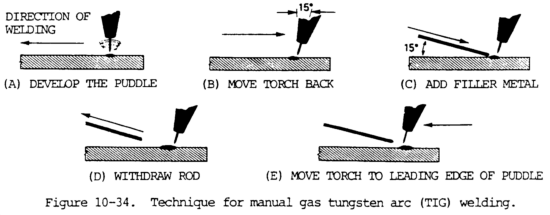
a. General. Plasma arc welding (PAW) is a process in which coalescence, or the joining of metals, is produced by heating with a constricted arc between an electrode and the workpiece (transfer arc) or the electrode and the constricting nozzle (nontransfer arc). Shielding is obtained from the hot ionized gas issuing from the orifice, which may be supplemented by an auxiliary source of shielding gas. Shielding gas may be an inert gas or a mixture of gases. Pressure may or may not be used, and filler metal may or may not be supplied. The PAW process is shown in figure 10-35.
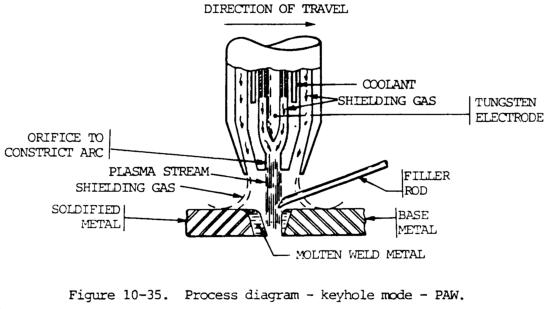
b. Equipment.
(1) Power source. A constant current drooping characteristic power source supplying the dc welding current is recommended; however, ac/dc type power source can be used. It should have an open circuit voltage of 80 volts and have a duty cycle of 60 percent. It is desirable for the power source to have a built-in contactor and provisions for remote control current adjustment. For welding very thin metals, it should have a minimum amperage of 2 amps. A maximum of 300 is adequate for most plasma welding applications.
(2) Welding torch. The welding torch for plasma arc welding is similar in appearance to a gas tungsten arc torch, but more complex.
(a) All plasma torches are water cooled, even the lowest-current range torch. This is because the arc is contained inside a chamber in the torch where it generates considerable heat. If water flow is interrupted briefly, the nozzle may melt. A cross section of a plasma arc torch head is shown by figure 10-36. During the nontransferred period, the arc will be struck between the nozzle or tip with the orifice and the tungsten electrode. Manual plasma arc torches are made in various sizes starting with 100 amps through 300 amperes. Automatic torches for machine operation are also available.
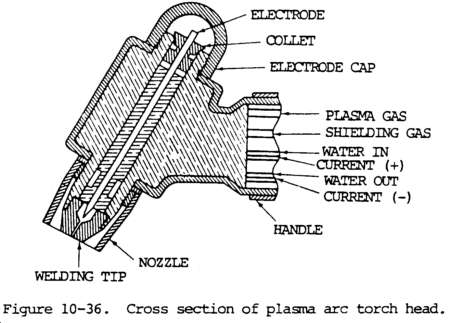
(b) The torch utilizes the 2 percent thoriated tungsten electrode similar to that used for gas tungsten welding. Since the tungsten electrode is located inside the torch, it is almost impossible to contaminate it with base metal.
(3) Control console. A control console is required for plasma arc welding. The plasma arc torches are designed to connect to the control console rather than the power source. The console includes a power source for the pilot arc, delay timing systems for transferring from the pilot arc to the transferred arc, and water and gas valves and separate flow meters for the plasma gas and the shielding gas. The console is usually connected to the power source and may operate the contactor. It will also contain a high-frequency arc starting unit, a nontransferred pilot arc power supply, torch protection circuit, and an ammeter. The high-frequency generator is used to initiate the pilot arc. Torch protective devices include water and plasma gas pressure switches which interlock with the contactor.
(4) Wire feeder. A wire feeder may be used for machine or automatic welding and must be the constant speed type. The wire feeder must have a speed adjustment covering the range of from 10 in. per minute (254 mm per minute) to 125 in. per minute (3.18 m per minute) feed speed.
c. Advantages and Major Uses.
(1) Advantages of plasma arc welding when compared to gas tungsten arc welding stem from the fact that PAW has a higher energy concentration. Its higher temperature, constricted cross-sectional area, and the velocity of the plasma jet create a higher heat content. The other advantage is based on the stiff columnar type of arc or form of the plasma, which doesn�t flare like the gas tungsten arc. These two factors provide the following advantages:
(a) The torch-to-work distance from the plasma arc is less critical than for gas tungsten arc welding. This is important for manual operation, since it gives the welder more freedom to observe and control the weld.
(b) High temperature and high heat concentration of the plasma allow for the keyhole effect, which provides complete penetration single pass welding of many joints. In this operation, the heat affected zone and the form of the weld are more desirable. The heat-affected zone is smaller than with the gas tungsten arc, and the weld tends to have more parallel sides, which reduces angular distortion.
(c) The higher heat concentration and the plasma jet allow for higher travel speeds. The plasma arc is more stable and is not as easily deflected to the closest point of base metal. Greater variation in joint alignment is possible with plasma arc welding. This is important when making root pass welds on pipe and other one-side weld joints. Plasma welding has deeper penetration capabilities and produces a narrower weld. This means that the depth-to-width ratio is more advantageous.
(2) Uses.
(a) Some of the major uses of plasma arc are its application for the manufacture of tubing. Higher production rates based on faster travel speeds result from plasma over gas tungsten arc welding. Tubing made of stainless steel, titanium, and other metals is being produced with the plasma process at higher production rates than previously with gas tungsten arc welding.
(b) Most applications of plasma arc welding are in the low-current range, from 100 amperes or less. The plasma can be operated at extremely low currents to allow the welding of foil thickness material.
(c) Plasma arc welding is also used for making small welds on weldments for instrument manufacturing and other small components made of thin metal. It is used for making butt joints of wall tubing.
(d) This process is also used to do work similar to electron beam welding, but with a much lower equipment cost.
(3) Plasma arc welding is normally applied as a manual welding process, but is also used in automatic and machine applications. Manual application is the most popular. Semiautomatic methods of application are not useful. The normal methods of applying plasma arc welding are manual (MA), machine (ME), and automatic (AU).
(4) The plasma arc welding process is an all-position welding process. Table 10-2 shows the welding position capabilities.
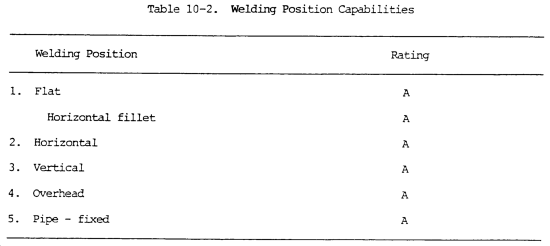
(5) The plasma arc welding process is able to join practically all commercially available metals. It may not be the best selection or the most economical process for welding some metals. The plasma arc welding process will join all metals that the gas tungsten arc process will weld. This is illustrated in table 10-3.
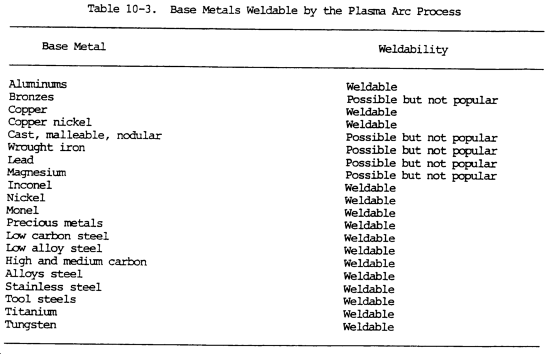
(6) Regarding thickness ranges welded by the plasma process, the keyhole mode of operation can be used only where the plasma jet can penetrate the joint. In this mode, it can be used for welding material from 1/16 in. (1.6 mm) through 1/4 in. (12.0 mm). Thickness ranges vary with different metals. The melt-in mode is used to weld material as thin as 0.002 in. (0.050 mm) up through 1/8 in. (3.2 mm). Using multipass techniques, unlimited thicknesses of metal can be welded. Note that filler rod is used for making welds in thicker material. Refer to table 10-4 for base metal thickness ranges.
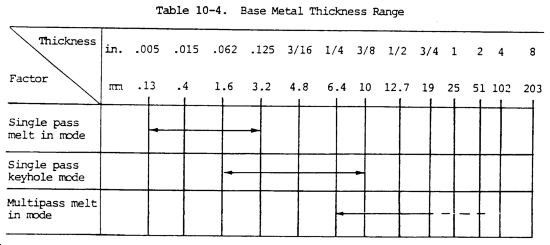
d. Limitations of the Process. The major limitations of the process have to do more with the equipment and apparatus. The torch is more delicate and complex than a gas tungsten arc torch. Even the lowest rated torches must be water cooled. The tip of the tungsten and the alignment of the orifice in the nozzle is extremely important and must be maintained within very close limits. The current level of the torch cannot be exceeded without damaging the tip. The water-cooling passages in the torch are relatively small and for this reason water filters and deionized water are recommended for the lower current or smaller torches. The control console adds another piece of equipment to the system. This extra equipment makes the system more expensive and may require a higher level of maintenance.
e. Principles of Operation.
(1) The plasma arc welding process is normally compared to the gas tungsten arc process. If an electric arc between a tungsten electrode and the work is constricted in a cross-sectional area, its temperature increases because it carries the same amount of current. This constricted arc is called a plasma, or the fourth state of matter.
(2) Two modes of operation are the non-transferred arc and the transferred arc.
(a) In the non-transferred mode, the current flow is from the electrode inside the torch to the nozzle containing the orifice and back to the power supply. It is used for plasma spraying or generating heat in nonmetals.
(b) In transferred arc mode, the current is transferred from the tungsten electrode inside the welding torch through the orifice to the workpiece and back to the power supply.
(c) The difference between these two modes of operation is shown by figure 10-37. The transferred arc mode is used for welding metals. The gas tungsten arc process is shown for comparison.
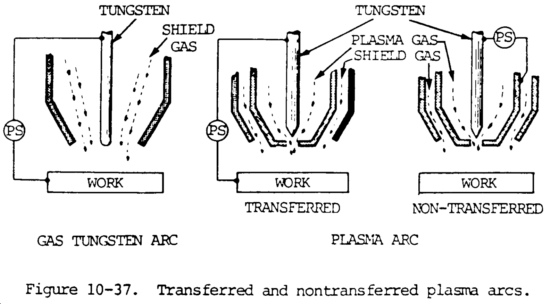
(3) The plasma is generated by constricting the electric arc passing through the orifice of the nozzle. Hot ionized gases are also forced through this opening. The plasma has a stiff columnar form and is parallel sided so that it does not flare out in the same manner as the gas tungsten arc. This high temperature arc, when directed toward the work, will melt the base metal surface and the filler metal that is added to make the weld. In this way, the plasma acts as an extremely high temperature heat source to form a molten weld puddle. This is similar to the gas tungsten arc. The higher-temperature plasma, however, causes this to happen faster, and is known as the melt-in mode of operation. Figure 10-36 shows a cross-sectional view of the plasma arc torch head.
(4) The high temperature of the plasma or constricted arc and the high velocity plasma jet provide an increased heat transfer rate over gas tungsten arc welding when using the same current. This results in faster welding speeds and deeper weld penetration. This method of operation is used for welding extremely thin material. and for welding multipass groove and welds and fillet welds.
(5) Another method of welding with plasma is the keyhole method of welding. The plasma jet penetrates through the workpiece and forms a hole, or keyhole. Surface tension forces the molten base metal to flow around the keyhole to form the weld. The keyhole method can be used only for joints where the plasma can pass through the joint. It is used for base metals 1/16 to 1/2 in. (1.6 to 12.0 mm) in thickness. It is affected by the base metal composition and the welding gases. The keyhole method provides for full penetration single pass welding which may be applied either manually or automatically in all positions.
(6) Joint design.
(a) Joint design is based on the metal thicknesses and determined by the two methods of operation. For the keyhole method, the joint design is restricted to full-penetration types. The preferred joint design is the square groove, with no minimum root opening. For root pass work, particularly on heavy wall pipe, the U groove design is used. The root face should be 1/8 in. (3.2 mm) to allow for full keyhole penetration.
(b) For the melt-in method of operation for welding thin gauge, 0.020 in. (0.500 mm) to 0.100 in. (2.500 mm) metals, the square groove weld should be utilized. For welding foil thickness, 0.005 in. (0.130 mm) to 0.020 in. (0.0500 mm), the edge flange joint should be used. The flanges are melted to provide filler metal for making the weld.
(c) When using the melt-in mode of operation for thick materials, the same general joint detail as used for shielded metal arc welding and gas tungsten arc welding can be employed. It can be used for fillets, flange welds, all types of groove welds, etc., and for lap joints using arc spot welds and arc seam welds. Figure 10-38 shows various joint designs that can be welded by the plasma arc process.

(7) Welding circuit and current. The welding circuit for plasma arc welding is more complex than for gas tungsten arc welding. An extra component is required as the control circuit to aid in starting and stopping the plasma arc. The same power source is used. There are two gas systems, one to supply the plasma gas and the second for the shielding gas. The welding circuit for plasma arc welding is shown by figure 10-39. Direct current of a constant current (CC) type is used. Alternating current is used for only a few applications.
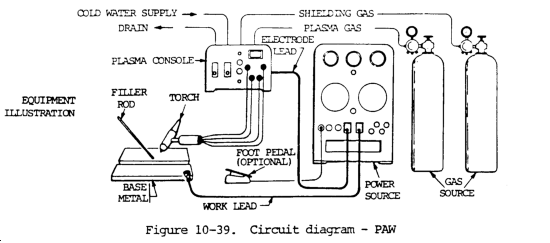
(8) Tips for Using the Process.
(a) The tungsten electrode must be precisely centered and located with respect to the orifice in the nozzle. The pilot arc current must be kept sufficiently low, just high enough to maintain a stable pilot arc. When welding extremely thin materials in the foil range, the pilot arc may be all that is necessary.
(b) When filler metal is used, it is added in the same manner as gas tungsten arc welding. However, with the torch-to-work distance a little greater there is more freedom for adding filler metal. Equipment must be properly adjusting so that the shielding gas and plasma gas are in the right proportions. Proper gases must also be used.
(c) Heat input is important. Plasma gas flow also has an important effect. These factors are shown by figure 10-40.

e. Filler Metal and Other Equipment.
(1) Filler metal is normally used except when welding the thinnest metals. Composition of the filler metal should match the base metal. The filler metal rod size depends on the base metal thickness and welding current. The filler metal is usually added to the puddle manually, but can be added automatically.
(2) Plasma and shielding gas. An inert gas, either argon, helium, or a mixture, is used for shielding the arc area from the atmosphere. Argon is more common because it is heavier and provides better shielding at lower flow rates. For flat and vertical welding, a shielding gas flow of 15 to 30 cu ft per hour (7 to 14 liters per minute) is sufficient. Overhead position welding requires a slightly higher flow rate. Argon is used for plasma gas at the flew rate of 1 cu ft per hour (0.5 liters per minute) up to 5 cu ft per hour (2.4 liters per minute) for welding, depending on torch size and application. Active gases are not recommended for plasma gas. In addition, cooling water is required.
f. Quality, Deposition Rates, and Variables.
(1) The quality of the plasma arc welds is extremely high and usually higher than gas tungsten arc welds because there is little or no possibility of tungsten inclusions in the weld. Deposition rates for plasma arc welding are somewhat higher than for gas tungsten arc welding and are shown by the curve in figure 10-41. Weld schedules for the plasma arc process are shown by the data in table 10-5.

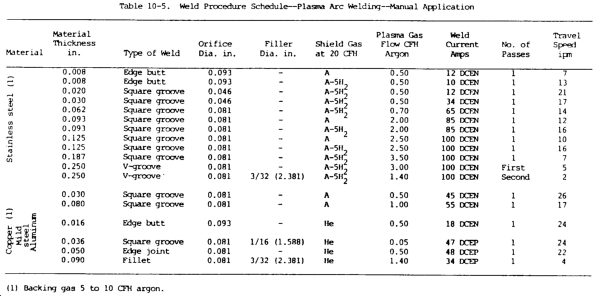
(2) The process variables for plasma arc welding are shown by figure 10-41. Most of the variables shown for plasma arc are similar to the other arc welding processes. There are two exceptions: the plasma gas flow and the orifice diameter in the nozzle. The major variables exert considerable control in the process. The minor variables are generally fixed at optimum conditions for the given application. All variables should appear in the welding procedure. Variables such as the angle and setback of the electrode and electrode type are considered fixed for the application. The plasma arc process does respond differently to these variables than does the gas tungsten arc process. The standoff, or torch-to-work distance, is less sensitive with plasma but the torch angle when welding parts of unequal thicknesses is more important than with gas tungsten arc.
g. Variations of the Process.
(1) The welding current may be pulsed to gain the same advantages pulsing provides for gas tungsten arc welding. A high current pulse is used for maximum penetration but is not on full time to allow for metal solidification. This gives a more easily controlled puddle for out-of-position work. Pulsing can be accomplished by the same apparatus as is used for gas tungsten arc welding.
(2) Programmed welding can also be employed for plasma arc welding in the same manner as it is used for gas tungsten arc welding. The same power source with programming abilities is used and offers advantages for certain types of work. The complexity of the programming depends on the needs of the specific application. In addition to programming the welding current, it is often necessary to program the plasma gas flow. This is particularly important when closing a keyhole which is required to make the root pass of a weld joining two pieces of pipe.
(3) The method of feeding the filler wire with plasma is essentially the same as for gas tungsten arc welding. The "hot wire" concept can be used. This means that low-voltage current is applied to the filler wire to preheat it prior to going into the weld puddle.
10-11. CARBON ARC WELDING (CAW)
a. General. Carbon arc welding is a process in which the joining of metals is produced by heating with an arc between a carbon electrode and the work. No shielding is used. Pressure and/or filler metal may or may not be used.
b. Equipment.
(1) Electrodes. Carbon electrodes range in size from 1/8 to 7/8 in. (3.2 to 22.2 mm) in diameter. Baked carbon electrodes last longer than graphite electrodes. Figure 10-42 shows typical air-cooled carbon electrode holders. Water-cooled holders are available for use with the larger size electrodes, or adapters can be fitted to regular holders to permit accommodation of the larger electrodes.
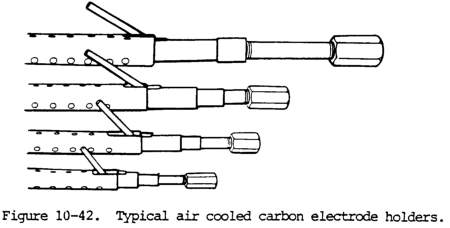
(2) Machines. Direct current welding machines of either the rotating or rectifier type are power sources for the carbon arc welding process.
(3) Welding circuit and welding current.
(a) The welding circuit for carbon arc welding is the same as for shielded metal arc welding. The difference in the apparatus is a special type of electrode holder used only for holding carbon electrodes. This type of holder is used because the carbon electrodes become extremely hot in use, and the conventional electrode holder will not efficiently hold and transmit current to the carbon electrode. The power source is the conventional or constant current type with drooping volt-amp characteristics. Normally, a 60 percent duty cycle power source is utilized. The power source should have a voltage rating of 50 volts, since this voltage is used when welding copper with the carbon arc.
(b) Single electrode carbon arc welding is always used with direct current electrode negative (DCEN), or straight polarity. In the carbon steel arc, the positive pole (anode) is the pole of maximum heat. If the electrode were positive, the carbon electrode would erode very rapidly because of the higher heat, and would cause black carbon smoke and excess carbon, which could be absorbed by the weld metal. Alternating current is not recommended for single-electrode carbon arc welding. The electrode should be adjusted often to compensate for the erosion of carbon. From 3.0 to 5.0 in. (76.2 to 127.0 mm) of the carbon electrode should protrude through the holder towards the arc.
c. Advantages and Major Uses.
(1) The single electrode carbon arc welding process is no longer widely used. It is used for welding copper, since it can be used at high currents to develop the high heat usually required. It is also used for making bronze repairs on cast iron parts. When welding thinner materials, the process is used for making autogenous welds, or welds without added filler metal. Carbon arc welding is also used for joining galvanized steel. In this case, the bronze filler rod is added by placing it between the arc and the base metal.
(2) The carbon arc welding process has been used almost entirely by the manual method of applying. It is an all-position welding process. Carbon arc welding is primarily used as a heat source to generate the weld puddle which can be carried in any position. Table 10-6 shows the normal method of applying carbon-arc welding. Table 10-7 shows the welding position capabilities.

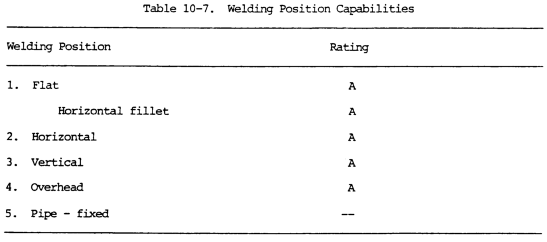
d. Weldable Metals. Since the carbon arc is used primarily as a heat source to generate a welding puddle, it can be used on metals that are not affected by carbon pickup or by the carbon monoxide or carbon dioxide arc atmosphere. It can be used for welding steels and nonferrous metals, and for surfacing.
(1) Steels. The main use of carbon arc welding of steel is making edge welds without the addition of filler metal. This is done mainly in thin gauge sheet metal work, such as tanks, where the edges of the work are fitted closely together and fused using an appropriate flux. Galvanized steel can be braze welded with the carbon arc. A bronze welding rod is used. The arc is directed on the rod so that the galvanizing is not burned off the steel sheet. The arc should be started on the welding rod or a starting block. Low current, a short arc length, and. rapid travel speed should be used. The welding rod should melt and wet the galvanized steel.
(2) Cast iron. Iron castings may be welded with the carbon arc and a cast iron welding rod. The casting should be preheated to about 1200°F (649°C) and slowly cooled if a machinable weld is desired.
(3) Copper. Straight polarity should always be used for carbon arc welding of copper. Reverse polarity will produce carbon deposits on the work that inhibit fusion. The work should be preheated in the range of 300 to 1200°F (149 to 649°C) depending upon the thickness of the parts. If this is impractical, the arc should be used to locally preheat the weld area. The high thermal conductivity of copper causes heat to be conducted away from the point of welding so rapidly that it is difficult to maintain welding heat without preheating. A root opening of 1/8 in. (3.2 mm) is recommended. Best results are obtained at high travel speeds with the arc length directed on the welding rod. A long arc length should be used to permit carbon from the electrode to combine with oxygen to form carbon dioxide, which will provide some shielding of weld metal.
e. Principles of Operation.
(1) Carbon arc welding, as shown in figure 10-43, uses a single electrode with the arc between it and the base metal. It is the oldest arc process, and is not popular today.

(2) In carbon arc welding, the arc heat between the carbon electrode and the work melts the base metal and, when required, also melts the filler rod. As the molten metal solidifies, a weld is produced. The nonconsumable graphite electrode erodes rapidly and, in disintegrating, produces a shielding atmosphere of carbon monoxide and carbon dioxide gas. These gases partially displace air from the arc atmosphere and prohibit the oxygen and nitrogen from coming in contact with molten metal. Filler metal, when used, is of the same composition as the base metal. Bronze filler metal can be used for brazing and braze welding.
(3) The workpieces must be free from grease, oil, scale, paint, and other foreign matter. The two pieces should be clamped tightly together with no root opening. They may be tack welded together.
(4) Carbon electrodes 1/8 to 5/16 in. (3.2 to 7.9 mm) in diameter may be used, depending upon the current required for welding. The end of the electrode should be prepared with a long taper to a point. The diameter of the point should be about half that of the electrode. For steel, the electrode should protrude about 4.0 to 5.0 in. (101.6 to 127.0 mm) from the electrode holder.
(5) A carbon arc may be struck by bringing the tip of the electrode into contact with the work and immediately withdrawing it to the correct length for welding. In general, an arc length between 1/4 and 3/8 in. (6.4 and 9.5 mm) is best. If the arc length is too short, there is likely to be excessive carburization of the molten metal resulting in a brittle weld.
(6) When the arc is broken for any reason, it should not be restarted directly upon the hot weld metal. This could cause a hard spot in the weld at the point of contact. The arc should be started on cold metal to one side of the joint, and then quickly returned to the point where welding is to be resumed.
(7) When the joint requires filler metal, the welding rod is fed into the molten weld pool with one hand while the arc is manipulated with the other. The arc is directed on the surface of the work and gradually moved along the joint, constantly maintaining a molten pool into which the welding rod is added in the same manner as in gas tungsten arc welding. Progress along the weld joint and the addition of a welding rod must be timed to provide the size and shape of weld bead desired. Welding vertically or overhead with the carbon arc is difficult because carbon arc welding is essentially a puddling process. The weld joint should be backed up, especially in the case of thin sheets, to support the molten weld pools and prevent excessive melt-thru.
(8) For outside corner welds in 14 to 18 gauge steel sheet, the carbon arc can be used to weld the two sheets together without a filler metal. Such welds are usually smother and more economical to make than shielded metal arc welds made under similar conditions.
f. Welding schedules. The welding schedule for carbon arc welding galvanized iron using silicon bronze filler metal is given in table 10-8. A short arc should be used to avoid damaging the galvanizing. The arc must be directed on the filler wire which will melt and flow on to the joint. For welding copper, use a high arc voltage and follow the schedule given in table 10-9. Table 10-10 shows the welding current to be used for each size of the two types of carbon electrodes.
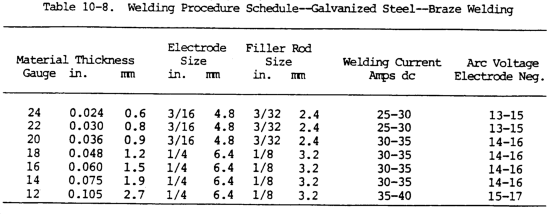
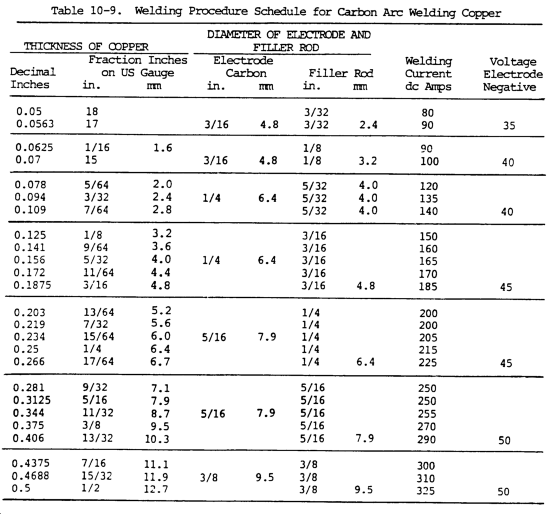
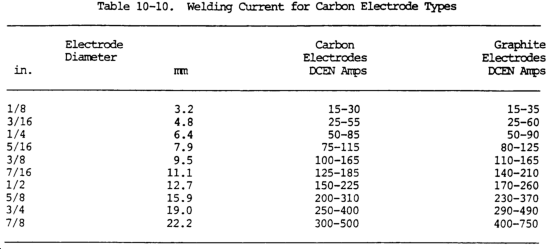
g. Variations of the Process.
(1) There are two important variations of carbon arc welding. One is twin carbon arc welding. The other is carbon arc cutting and gouging.
(2) Twin carbon arc welding is an arc welding process in which the joining of metals is produced, using a special electrode holder, by heating with an electric arc maintained between two carbon electrodes. Filler metal may or may not he used. The process can also be used for brazing.
(a) The twin carbon electrode holder is designed so that one electrode is movable and can be touched against the other to initiate the arc. The carbon electrodes are held in the holder by means of set screws and are adjusted so they protrude equally from the clamping jaws. When the two carbon electrodes are brought together, the arc is struck and established between them. The angle of the electrodes provides an arc that forms in front of the apex angle and fans out as a soft source of concentrated heat or arc flame. It is softer than that of the single carbon arc. The temperature of this arc flame is between 8000 and 9000°F (4427 and 4982°C).
(b) Alternating current is used for the twin carbon welding arc. With alternating current, the electrodes will burn off or disintegrate at equal rates. Direct current power can be used, but when it is, the electrode connected to the positive terminal should be one size larger than the electrode connected to the negative terminal to ensure even disintegration of the carbon electrodes. The arc gap or spacing between the two electrodes most be adjusted more or less continuously to provide the fan shape arc.
(c) The twin carbon arc can be used for many applications in addition to welding, brazing, and soldering. It can be used as a heat source to bend or form metal. The welding current settings or schedules for different size of electrodes is shown in table 10-11.
The twin carbon electrode method is relatively slow and does not have much use as an industrial welding process.

(3) Carbon arc cutting is an arc cutting process in which metals are severed by melting them with the heat of an arc between a carbon electrode and the base metal. The process depends upon the heat input of the carbon arc to melt the metal. Gravity causes the molten metal to fall away to produce the cut. The process is relatively slow, results in a ragged cut, and is used only when other cutting equipment is not available.
10-12. GAS METAL-ARC WELDING (GMAW OR MIG WELDING)
a. General.
(1) Gas metal arc welding ( GMAW or MIG welding) is an electric arc welding process which joins metals by heating them with an arc established between a continuous filler metal (consumable) electrode and the work. Shielding of the arc and molten weld pool is obtained entirely from an externally supplied gas or gas mixture, as shown in figure 10-44. The process is sometimes referred to as MIG or CO2 welding. Recent developments in the process include operation at low current densities and pulsed direct current, application to a broader range of materials, and the use of reactive gases, particularly CO2, or gas mixtures. This latter development has led to the formal acceptance of the term gas metal arc welding (GMAW) for the process because both inert and reactive gases are used. The term MIG welding is still more commonly used.
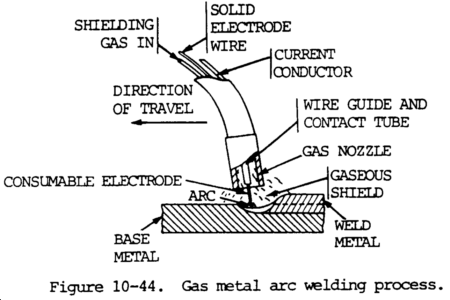
(2) MIG welding is operated in semiautomatic, machine, and automatic modes. It is utilized particularly in high production welding operations. All commercially important metals such as carbon steel, stainless steel, aluminum, and copper can be welded with this process in all positions by choosing the appropriate shielding gas, electrode, and welding conditions.
b. Equipment.
(1) Gas metal arc welding equipment consists of a welding gun, a power supply, a shielding gas supply, and a wire-drive system which pulls the wire electrode from a spool and pushes it through a welding gun. A source of cooling water may be required for the welding gun. In passing through the gun, the wire becomes energized by contact with a copper contact tube, which transfers current from a power source to the arc. While simple in principle, a system of accurate controls is employed to initiate and terminate the shielding gas and cooling water, operate the welding contactor, and control electrode feed speed as required. The basic features of MIG welding equipment are shown in figure 10-45. The MIG process is used for semiautomatic, machine, and automatic welding. Semiautomatic MIG welding is often referred to as manual welding.
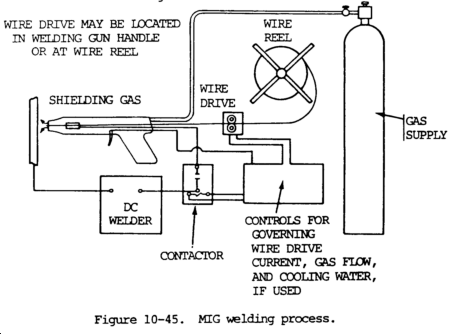
(2) Two types of power sources are used for MIG welding: constant current and constant voltage.
(a) Constant current power supply. With this type, the welding current is established by the appropriate setting on the power supply. Arc length (voltage) is controlled by the automatic adjustment of the electrode feed rate. This type of welding is best suited to large diameter electrodes and machine or automatic welding, where very rapid change of electrode feed rate is not required. Most constant current power sources have a drooping volt-ampere output characteristic. However, true constant current machines are available. Constant current power sources are not normally selected for MIG welding because of the control needed for electrode feed speed. The systems are not self-regulating.
(b) Constant voltage power supply. The arc voltage is established by setting the output voltage on the power supply. The power source will supply the necessary amperage to melt the welding electrode at the rate required to maintain the present voltage or relative arc length. The speed of the electrode drive is used to control the average welding current. This characteristic is generally preferred for the welding of all metals. The use of this type of power supply in conjunction with a constant wire electrode feed results in a self-correcting arc length system.
(3) Motor generator or dc rectifier power sources of either type may be used. With a pulsed direct current power supply, the power source pulses the dc output from a low background value to a high peak value. Because the average power is lower, pulsed welding current can be used to weld thinner sections than those that are practical with steady dc spray transfer.
(4) Welding guns. Welding guns for MIG welding are available for manual manipulation (semiautomatic welding) and for machine or automatic welding. Because the electrode is fed continuously, a welding gun must have a sliding electrical contact to transmit the welding current to the electrode. The gun must also have a gas passage and a nozzle to direct the shielding gas around the arc and the molten weld pool. Cooling is required to remove the heat generated within the gun and radiated from the welding arc and the molten weld metal. Shielding gas, internal circulating water, or both, are used for cooling. An electrical switch is needed to start and stop the welding current, the electrode feed system, and shielding gas flow.
(a) Semiautomatic guns. Semiautomatic, hand-held guns are usually similar to a pistol in shape. Sometimes they are shaped similar to an oxyacetylene torch, with electrode wire fed through the barrel or handle. In some versions of the pistol design, where the most cooling is necessary, water is directed through passages in the gun to cool both the contact tube and the metal shielding gas nozzle. The curved gun uses a curved current-carrying body at the front end, through which the shielding gas is brought to the nozzle. This type of gun is designed for small diameter wires and is flexible and maneuverable. It is suited for welding in tight, hard to reach corners and other confined places. Guns are equipped with metal nozzles of various internal diameters to ensure adequate gas shielding. The orifice usually varies from approximately 3/8 to 7/8 in. (10 to 22 mm), depending upon welding requirements. The nozzles are usually threaded to make replacement easier. The conventional pistol type holder is also used for arc spot welding applications where filler metal is required. The heavy nozzle of the holder is slotted to exhaust the gases away from the spot. The pistol grip handle permits easy manual loading of the holder against the work. The welding control is designed to regulate the flow of cooling water and the supply of shielding gas. It is also designed to prevent the wire freezing to the weld by timing the weld over a preset interval. A typical semiautomatic gas-cooled gun is shown in figure 10-46.
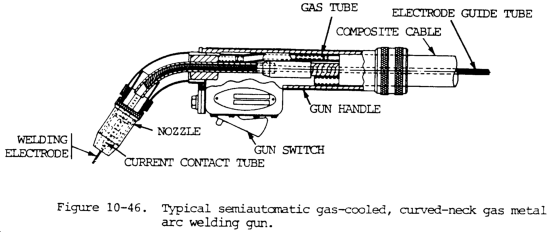
(b) Air cooled guns. Air-cooled guns are available for applications where water is not readily obtainable as a cooling medium. These guns are available for service up to 600 amperes, intermittent duty, with carbon dioxide shielding gas. However, they are usually limited to 200 amperes with argon or helium shielding. The holder is generally pistol-like and its operation is similar to the water-cooled type. Three general types of air-cooled guns are available.
1. A gun that has the electrode wire fed to it through a flexible conduit from a remote wire feeding mechanism. The conduit is generally in the 12 ft (3.7 m) length range due to the wire feeding limitations of a push-type system. Steel wires of 7/20 to 15/16 in. (8.9 to 23.8 mm) diameter and aluminum wires of 3/64 to 1/8 in. (1.19 to 3.18 mm) diameter can be fed with this arrangement.
2. A gun that has a self-contained wire feed mechanism and electrode wire supply. The wire supply is generally in the form of a 4 in. (102 mm) diameter, 1 to 2-1/2 lb (0.45 to 1.1 kg) spool. This type of gun employs a pull-type wire feed system, and it is not limited by a 12 ft (3.7 m) flexible conduit. Wire diameters of 3/10 to 15/32 in. (7.6 to 11.9 mm) are normally used with this type of gun.
3. A pull-type gun that has the electrode wire fed to it through a flexible conduit from a remote spool. This incorporates a self-contained wire feeding mechanism. It can also be used in a push-pull type feeding system. The system permits the use of flexible conduits in lengths up to 50 ft (15 m) or more from the remote wire feeder. Aluminum and steel electrodes with diameters of 3/10 to 5/8 in. (7.6 to 15.9 mm) can be used with these types of feed mechanisms.
(c) Water-cooled guns for manual MIG welding similar to gas-cooled types with the addition of water cooling ducts. The ducts circulate water around the contact tube and the gas nozzle. Water cooling permits the gun to operate continuously at rated capacity and at lower temperatures. Water-coded guns are used for applications requiring 200 to 750 amperes. The water in and out lines to the gun add weight and reduce maneuverability of the gun for welding.
(d) The selection of air- or water-cooled guns is based on the type of shielding gas, welding current range, materials, weld joint design, and existing shop practice. Air-cooled guns are heavier than water-cooled guns of the same welding current capacity. However, air-cooled guns are easier to manipulate to weld out-of-position and in confined areas.
c. Advantages.
(1) The major advantage of gas metal-arc welding is that high quality welds can be produced much faster than with SMAW or TIG welding.
(2) Since a flux is not used, there is no chance for the entrapment of slag in the weld metal.
(3) The gas shield protects the arc so that there is very little loss of alloying elements as the metal transfers across the arc. Only minor weld spatter is produced, and it is easily removed.
(4) This process is versatile and can be used with a wide variety of metals and alloys, including aluminum, copper, magnesium, nickel, and many of their alloys, as well as iron and most of its alloys. The process can be operated in several ways, including semi- and fully automatic. MIG welding is widely used by many industries for welding a broad variety of materials, parts, and structures.
d. Disadvantages.
(1) The major disadvantage of this process is that it cannot be used in the vertical or overhead welding positions due to the high heat input and the fluidity of the weld puddle.
(2) The equipment is complex compared to equipment used for the shielded metal-arc welding process.
e. Process Principles.
(1) Arc power and polarity.
(a) The vast majority of MIG welding applications require the use of direct current reverse polarity (electrode positive). This type of electrical connection yields a stable arc, smooth metal transfer, relatively low spatter loss, and good weld bead characteristics for the entire range of welding currents used. Direct current straight polarity (electrode negative) is seldom used, since the arc can become unstable and erratic even though the electrode melting rate is higher than that achieved with dcrp (electrode positive). When employed, dcsp (electrode negative) is used in conjunction with a "buried" arc or short circuiting metal transfer. Penetration is lower with straight polarity than with reverse polarity direct current.
(b) Alternating current has found no commercial acceptance with the MIG welding process for two reasons: the arc is extinguished during each half cycle as the current reduces to zero, and it may not reignite if the cathode cools sufficiently; and rectification of the reverse polarity cycle promotes the erratic arc operation.
(2) Metal transfer.
(a) Filler metal can be transferred from the electrode to the work in two ways: when the electrode contacts the molten weld pool, thereby establishing a short circuit, which is known as short circuiting transfer (short circuiting arc welding); and when discrete drops are moved across the arc gap under the influence of gravity or electromagnetic forces. Drop transfer can be either globular or spray type.
(b) Shape, size, direction of drops (axial or nonaxial), and type of transfer are determined by a number of factors. The factors having the most influence are:
1. Magnitude and type of welding current.
2. Current density.
3. Electrode composition.
4. Electrode extension.
5. Shielding gas.
6. Power supply characteristics.
(c) Axially directed transfer refers to the movement of drops along a line that is a continuation of the longitudinal axis of the electrode. Nonaxially directed transfer refers to movement in any other direction.
(3) Short circuiting transfer.
(a) Short circuiting arc welding uses the lowest range of welding currents and electrode diameters associated with MIG welding. This type of transfer produces a small, fast-freezing weld pool that is generally suited for the joining of thin sections, out-of-position welding, and filling of large root openings. When weld heat input is extremely low, plate distortion is small. Metal is transferred from the electrode to the work only during a period when the electrode is in contact with the weld pool. There is no metal transfer across the arc gap.
(b) The electrode contacts the molten weld pool at a steady rate in a range of 20 to over 200 times each second. As the wire touches the weld metal, the current increases. It would continue to increase if an arc did not form. The rate of current increase must be high enough to maintain a molten electrode tip until filler metal is transferred. It should not occur so fast that it causes spatter by disintegration of the transferring drop of filler metal. The rate of current increase is controlled by adjustment of the inductance in the power source. The value of inductance required depends on both the electrical resistance of the welding circuit and the temperature range of electrode melting. The open circuit voltage of the power source must be low enough so that an arc cannot continue under the existing welding conditions. A portion of the energy for arc maintenance is provided by the inductive storage of energy during the period of short circuiting.
(c) As metal transfer only occurs during short circuiting, shielding gas has very little effect on this type of transfer. Spatter can occur. It is usually caused either by gas evolution or electromagnetic forces on the molten tip of the electrode.
(4) Globular transfer.
(a) With a positive electrode (dcrp), globular transfer takes place when the current density is relatively low, regardless of the type of shielding gas. However, carbon dioxide (CO2) shielding yields this type of transfer at all usable welding currents. Globular transfer is characterized by a drop size of greater diameter than that of the electrode.
(b) Globular, axially directed transfer can be achieved in a substantially inert gas shield without spatter. The arc length must be long enough to assure detachment of the drop before it contacts the molten metal. However, the resulting weld is likely to be unacceptable because of lack of fusion, insufficient penetration, and excessive reinforcement.
(c) Carbon dioxide shielding always yields nonaxially directed globular transfer. This is due to an electromagnetic repulsive force acting upon the bottom of the molten drops. Flow of electric current through the electrode generates several forces that act on the molten tip. The most important of these are pinch force and anode reaction force. The magnitude of the pinch force is a direct function of welding current and wire diameter, and is usually responsible for drop detachment. With CO2 shielding, the wire electrode is melted by the arc heat conducted through the molten drop. The electrode tip is not enveloped by the arc plasma. The molten drop grows until it detaches by short circuiting or gravity.
(5) Spray transfer.
(a) In a gas shield of at least 80 percent argon or helium, filler metal transfer changes from globular to spray type as welding current increases for a given size electrode. For all metals, the change takes place at a current value called the globular-to-spray transition current.
(b) Spray type transfer has a typical fine arc column and pointed wire tip associated with it. Molten filler metal transfers across the arc as fine droplets. The droplet diameter is equal to or less than the electrode diameter. The metal spray is axially directed. The reduction in droplet size is also accompanied by an increase in the rate of droplet detachment, as illustrated in figure 10-47. Metal transfer rate may range from less than 100 to several hundred droplets per second as the electrode feed rate increases from approximately 100 to 800 in./min (42 to 339 mm/s).
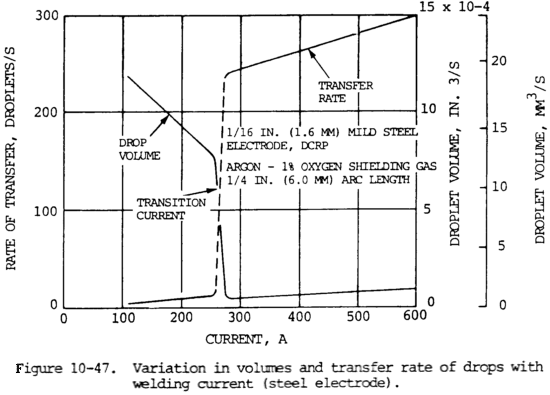
(6) Free flight transfer.
(a) In free-flight transfer, the liquid drops that form at the tip of the consumable electrode are detached and travel freely across the space between the electrode and work piece before plunging into the weld pool. When the transfer is gravitational, the drops are detached by gravity alone and fall slowly through the arc column. In the projected type of transfer, other forces give the drop an initial acceleration and project it independently of gravity toward the weld pool. During repelled transfer, forces act on the liquid drop and give it an initial velocity directly away from the weld pool. The gravitational and projected ties of free-flight metal transfer may occur in the gas metal-arc welding of steel, nickel alloys, or aluminum alloys using a direct current, electrode-positive (reverse polarity) arc and properly selected types of shielding gases.
(b) At low currents, wires of these alloys melt slowly. A large spherical drop forms at the tip and is detached when the force due to gravity exceeds that of surface tension. As the current increases, the electromagnetic force becomes significant and the total. separating force increases. The rate at which drops are formed and detached also increases. At a certain current, a change occurs in the character of the arc and metal transfer. The arc column, previously bell-shaped or spherical and having relatively low brightness, becomes narrower and more conical and has a bright central core. The droplets that form at the wire tip become elongated due to magnetic pressure and are detached at a much higher rate. When carbon dioxide is used as the shielding gas, the type of metal transfer is much different. At low and medium reversed-polarity currents, the drop appears to be repelled from the work electrode and is eventually detached while moving away from the workpiece and weld pool. This causes an excessive amount of spatter. At higher currents, the transfer is less irregular because other forces, primarily electrical, overcame the repelling forces. Direct current reversed-polarity is recommended for the MIG welding process. Straight polarity and alternating current can be used, but require precautions such as a special coating on the electrode wire or special shield gas mixtures.
(c) The filler wire passes through a copper contact tube in the gun, where it picks up the welding current. Some manual welding guns contain the wire-driving mechanism within the gun itself. Other guns require that the wire-feeding mechanism be located at the spool of wire, which is some distance from the gun. In this case, the wire is driven through a flexible conduit to the welding gun. Another manual gun design combines feed mechanisms within the gun and at the wire supply itself. Argon is the shielding gas used most often. Small amounts of oxygen (2 to 5 percent) frequently are added to the shielding gas when steel is welded. This stabilizes the arc and promotes a better wetting action, producing a more uniform weld bead and reducing undercut. Carbon dioxide is also used as a shielding gas because it is cheaper than argon and argon-oxygen mixtures. Electrodes designed to be used with carbon dioxide shielding gas require extra deoxidizers in their formulation because in the heat of the arc, the carbon dioxide dissociates to carbon monoxide and oxygen, which can cause oxidation of the weld metal.
(7) Welding parameters. Figures 10-48 through 10-54 show the relationship between the voltage and the current levels, and the type of transfer across the arcs.
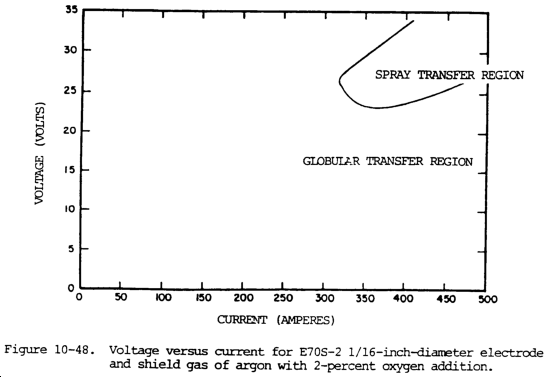
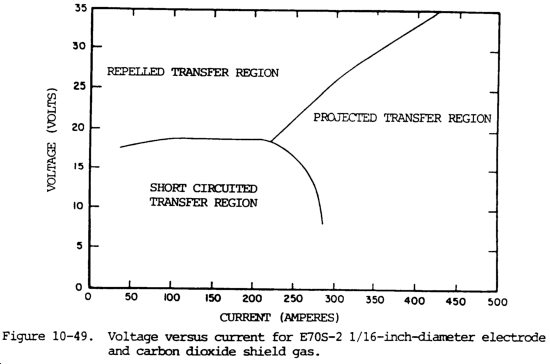
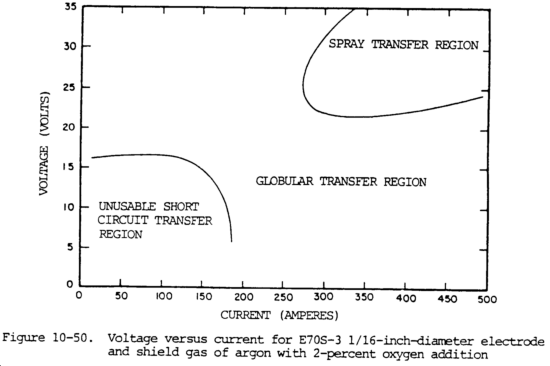
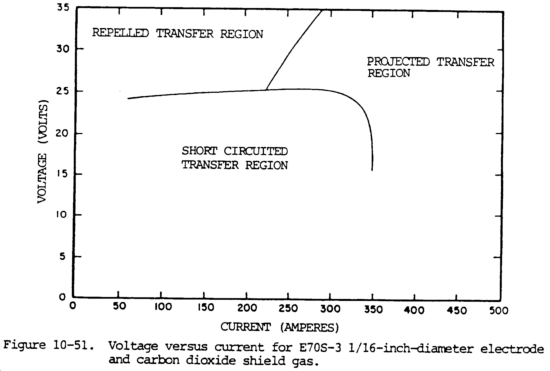

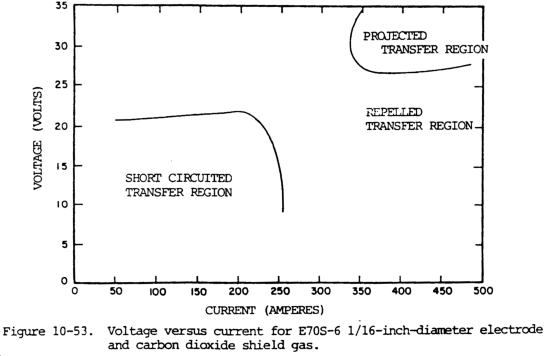
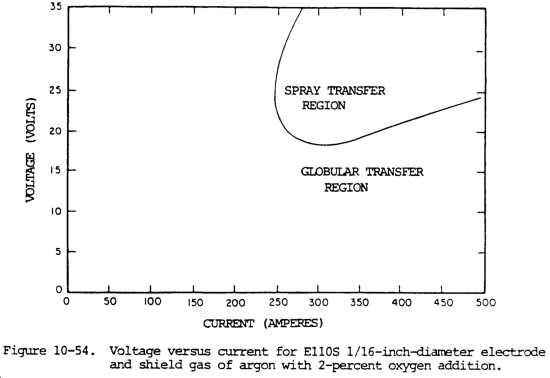
f. Welding Procedures.
(1) The welding procedures for MIG welding are similar to those for other arc welding processes. Adequate fixturing and clamping of the work are required with adequate accessibility for the welding gun. Fixturing must hold the work rigid to minimize distortion from welding. It should be designed for easy loading and unloading. Good connection of the work lead (ground) to the workpiece or fixturing is required. Location of the connection is important, particularly when welding ferromagnetic materials such as steel. The best direction of welding is away from the work lead connection. The position of the electrode with respect to the weld joint is important in order to obtain the desired joint penetration, fusion, and weld bead geometry. Electrode positions for automatic MIG welding are similar to those used with submerged arc welding.
(2) When complete joint penetration is required, some method of weld backing will help to control it. A backing strip, backing weld, or copper backing bar can be used. Backing strips and backing welds usually are left in place. Copper backing bars are removable.
(3) The assembly of the welding equipment should be done according to the manufacturer�s directions. All gas and water connections should be tight; there should be no leaks. Aspiration of water or air into the shielding gas will result in erractic arc operation and contamination of the weld. Porosity may also occur.
(4) The gun nozzle size and the shielding gas flow rate should be set according to the recommended welding procedure for the material and joint design to be welded. Joint designs that require long nozzle-to-work distances will need higher gas flow rates than those used with normal nozzle-to-work distances. The gas nozzle should be of adequate size to provide good gas coverage of the weld area. When welding is done in confined areas or in the root of thick weld joints, small size nozzles are used.
(5) The gun contact tube and electrode feed drive rolls are selected for the particular electrode composition and diameter, as specified by the equipment manufacturer. The contact tube will wear with usage, and must be replaced periodically if good electrical contact with electrode is to be maintained and heating of the gun is to be minimized.
(6) Electrode extension is set by the distance between the tip of the contact tube and the gas nozzle opening. The extension used is related to the type of MIG welding, short circuiting or spray type transfer. It is important to keep the electrode extension (nozzle-to-work distance) as uniform as possible during welding. Therefore, depending on the application, the contact tube may be inside, flush with, or extending beyond the gas nozzle.
(7) The electrode feed rate and welding voltage are set to the recommended values for the electrode size and material. With a constant voltage power source, the welding current will be establish by the electrode feed rate. A trial bead weld should be made to establish proper voltage (arc length) and feed rate values. Other variables, such as slope control, inductance, or both, should be adjusted to give good arc starting and smooth arc operation with minimum spatter. The optimum settings will depend on the equipment design and controls, electrode material and size, shielding gas, weld joint design, base metal composition and thickness, welding position, and welding speed.
10-13. FLUX-CORED ARC WELDING (FCAW)
a. General.
(1) Flux-cored, tubular electrode welding has evolved from the MIG welding process to improve arc action, metal transfer, weld metal properties, and weld appearance. It is an arc welding process in which the heat for welding is provided by an arc between a continuously fed tubular electrode wire and the workpiece. Shielding is obtained by a flux contained within the tubular electrode wire or by the flux and an externally supplied shielding gas. A diagram of the process is shown in figure 10-55.
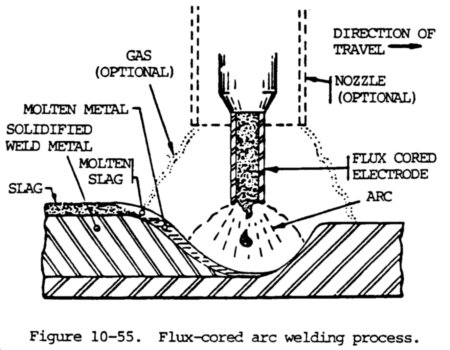
(2) Flux-cored arc welding is similar to gas metal arc welding in many ways. The flux-cored wire used for this process gives it different characteristics. Flux-cored arc welding is widely used for welding ferrous metals and is particularly good for applications in which high deposition rates are needed. At high welding currents, the arc is smooth and more manageable when compared in using large diameter gas metal arc welding electrodes with carbon dioxide. The arc and weld pool are clearly visible to the welder. A slag coating is left on the surface of the weld bead, which must be removed. Since the filler metal transfers across the arc, some spatter is created and some smoke produced.
b. Equipment.
(1) The equipment used for flux-cored arc welding is similar to that used for gas metal arc welding. The basic arc welding equipment consists of a power source, controls, wire feeder, welding gun, and welding cables. A major difference between the gas shielded electrodes and the self-shielded electrodes is that the gas shielded wires also require a gas shielding system. This may also have an effect on the type of welding gun used. Fume extractors are often used with this process. For machines and automatic welding, several items, such as seam followers and motion devices, are added to the basic equipment. Figure 10-56 shows a diagram of the equipment used for semiautomatic flux-cored arc welding.
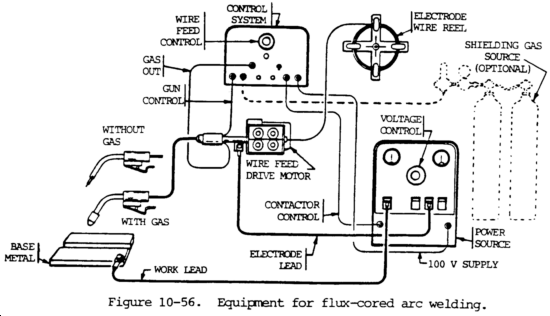
(2) The power source, or welding machine, provides the electric power of the proper voltage and amperage to maintain a welding arc. Most power sources operate on 230 or 460 volt input power, but machines that operate on 200 or 575 volt input are also available. Power sources may operate on either single phase or three-phase input with a frequency of 50 to 60 hertz. Most power sources used for flux-cored arc welding have a duty cycle of 100 percent, which indicates they can be used to weld continuously. Some machines used for this process have duty cycles of 60 percent, which means that they can be used to weld 6 of every 10 minutes. The power sources generally recommended for flux-cored arc welding are direct current constant voltage type. Both rotating (generator) and static (single or three-phase transformer-rectifiers) are used. The same power sources used with gas metal arc welding are used with flux-cored arc welding. Flux-cored arc welding generally uses higher welding currents than gas metal arc welding, which sometimes requires a larger power source. It is important to use a power source that is capable of producing the maximum current level required for an application.
(3) Flux-cored arc welding uses direct current. Direct current can be either reverse or straight polarity. Flux-cored electrode wires are designed to operate on either DCEP or DCEN. The wires designed for use with an external gas shielding system are generally designed for use with DCEP. Some self-shielding flux-cored ties are used with DCEP while others are developed for use with DCEN. Electrode positive current gives better penetration into the weld joint. Electrode negative current gives lighter penetration and is used for welding thinner metal or metals where there is poor fit-up. The weld created by DCEN is wider and shallower than the weld produced by DCEP.
(4) The generator welding machines used for this process can be powered by an electric rotor for shop use, or by an internal combustion engine for field applications. The gasoline or diesel engine-driven welding machines have either liquid or air-cooled engines. Motor-driven generators produce a very stable arc, but are noisier, more expensive, consume more power, and require more maintenance than transformer-rectifier machines.
(5) A wire feed motor provides power for driving the electrode through the cable and gun to the work. There are several different wire feeding systems available. System selection depends upon the application. Most of the wire feed systems used for flux-cored arc welding are the constant speed type, which are used with constant voltage power sources. With a variable speed wire feeder, a voltage sensing circuit is used to maintain the desired arc length by varying the wire feed speed. Variations in the arc length increase or decrease the wire feed speed. A wire feeder consists of an electrical rotor connected to a gear box containing drive rolls. The gear box and wire feed motor shown in figure 10-57 have form feed rolls in the gear box.
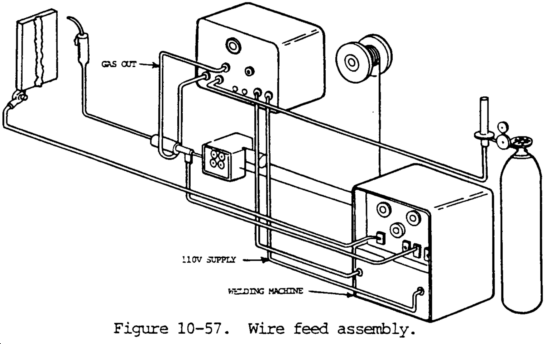
(6) Both air-cooled and water-cooled guns are used for flux-cored arc welding. Air-cooled guns are cooled primarily by the surrounding air, but a shielding gas, when used, provides additional cooling effects. A water-cooled gun has ducts to permit water to circulate around the contact tube and nozzle. Water-cooled guns permit more efficient cooling of the gun. Water-cooled guns are recommended for use with welding currents greater than 600 amperes, and are preferred for many applications using 500 amperes. Welding guns are rated at the maximum current capacity for continuous operation. Air-cooled guns are preferred for most applications less than 500 amperes, although water-cooled guns may also be used. Air-cooled guns are lighter and easier to manipulate.
(7) Shielding gas equipment and electrodes.
(a) Shielding gas equipment used for gas shielded flux-cored wires consists of a gas supply hose, a gas regulator, control valves, and supply hose to the welding gun.
(b) The shielding gases are supplied in liquid form when they are in storage tanks with vaporizers, or in a gas form in high pressure cylinders. An exception to this is carbon dioxide. When put in high pressure cylinders, it exists in both liquid and gas forms.
(c) The primary purpose of the shielding gas is to protect the arc and weld puddle from contaminating effects of the atmosphere. The nitrogen and oxygen of the atmosphere, if allowed to come in contact with the molten weld metal, cause porosity and brittleness. In flux-cored arc welding, shielding is accomplished by the decomposition of the electrode core or by a combination of this and surrounding the arc with a shielding gas supplied from an external source. A shielding gas displaces air in the arc area. Welding is accomplished under a blanket of shielding gas. Inert and active gases may both be used for flux-cored arc welding. Active gases such as carbon dioxide, argon-oxygen mixture, and argon-carbon dioxide mixtures are used for almost all applications. Carbon dioxide is the most common. The choice of the proper shielding gas for a specific application is based on the type of metal to be welded, arc characteristics and metal transfer, availability, cost of the gas, mechanical property requirements, and penetration and weld bead shape. The various shielding gases are summarized below.
1.
Carbon dioxide. Carbon dioxide is manufactured from fuel gases which are given off by the burning of natural gas, fuel oil, or coke. It is also obtained as a by-product of calcining operation in lime kilns, from the manufacturing of ammonia and from the fermentation of alcohol, which is almost 100 percent pure. Carbon dioxide is made available to the user in either cylinder or bulk containers. The cylinder is more common. With the bulk system, carbon dioxide is usually drawn off as a liquid and heated to the gas state before going to the welding torch. The bulk system is normally only used when supplying a large number of welding stations. In the cylinder, the carbon dioxide is in both a liquid and a vapor form with the liquid carbon dioxide occupying approximately two thirds of the space in the cylinder. By weight, this is approximately 90 percent of the content of the cylinder. Above the liquid, it exists as a vapor gas. As carbon dioxide is drawn from the cylinder, it is replaced with carbon dioxide that vaporizes from the liquid in the cylinder and therefore the overall pressure will be indicated by the pressure gauge. When the pressure in the cylinder has dropped to 200 psi (1379 kPa), the cylinder should be replaced with a new cylinder. A positive pressure should always be left in the cylinder in order to prevent moisture and other contaminants from backing up into the cylinder. The normal discharge rate of the CO2 cylinder is about 10 to 50 cu ft per hr (4.7 to 24 liters per min). However, a maximum discharge rate of 25 cu ft per hr (12 liters per min is recommended when welding using a single cylinder. As the vapor pressure drops from the cylinder pressure to discharge pressure through the CO2 regulator, it absorbs a great deal of heat. If flow rates are set too high, this absorption of heat can lead to freezing of the regulator and flowmeter which interrupts the shielding gas flow. When flow rate higher than 25 cu ft per hr (12 liters per min) is required, normal practice is to manifold two CO2 cylinders in parallel or to place a heater between the cylinder and gas regulator, pressure regulator, and flowmeter. Excessive flow rates can also result in drawing liquid from the cylinder. Carbon dioxide is the most widely used shielding gas for flux-cored arc welding. Most active gases cannot be used for shielding, but carbon dioxide provides several advantages for use in welding steel. These are deep penetration and low cost. Carbon dioxide promotes a globular transfer. The carbon dioxide shielding gas breaks down into components such as carbon monoxide and oxygen. Because carbon dioxide is an oxidizing gas, deoxidizing elements are added to the core of the electrode wire to remove oxygen. The oxides formed by the deoxidizing elements float to the surface of the weld and become part of the slag covering. Some of the carbon dioxide gas will break down to carbon and oxygen. If the carbon content of the weld pool is below about 0.05 percent, carbon dioxide shielding will tend to increase the carbon content of the weld metal. Carbon, which can reduce the corrosion resistance of some stainless steels, is a problem for critical corrosion application. Extra carbon can also reduce the toughness and ductility of some low alloy steels. If the carbon content in the weld metal is greater than about 0.10 percent, carbon dioxide shielding will tend to reduce the carbon content. This loss of carbon can be attributed to the formation of carbon monoxide, which can be trapped in the weld as porosity deoxidizing elements in the flux core reducing the effects of carbon monoxide formation.2. Argon-carbon dioxide mixtures. Argon and carbon dioxide are sometimes mixed for use with flux-cored arc welding. A high percentage of argon gas in the mixture tends to promote a higher deposition efficiency due to the creation of less spatter. The most commonly used gas mixture in flux-cored arc welding is a 75 percent argon-25 percent carbon dioxide mixture. The gas mixture produces a fine globular metal transfer that approaches a spray. It also reduces the amount of oxidation that occurs, compared to pure carbon dioxide. The weld deposited in an argon-carbon dioxide shield generally has higher tensile and yield strengths. Argon-carbon dioxide mixtures are often used for out-of-position welding, achieving better arc characteristics. These mixtures are often used on low alloy steels and stainless steels. Electrodes that are designed for use with CO2 may cause an excessive buildup of manganese, silicon, and other deoxidizing elements if they are used with shielding gas mixtures containing a high percentage of argon. This will have an effect on the mechanical properties of the weld.
3. Argon-oxygen mixtures. Argon-oxygen mixtures containing 1 or 2 percent oxygen are used for some applications. Argon-oxygen mixtures tend to promote a spray transfer which reduces the amount of spatter produced. A major application of these mixtures is the welding of stainless steel where carbon dioxide can cause corrosion problems.
(d) The electrodes used for flux-cored arc welding provide the filler metal to the weld puddle and shielding for the arc. Shielding is required for sane electrode types. The purpose of the shielding gas is to provide protection from the atmosphere to the arc and molten weld puddle. The chemical composition of the electrode wire and flux core, in combination with the shielding gas, will determine the weld metal composition and mechanical properties of the weld. The electrodes for flux-cored arc welding consist of a metal shield surrounding a core of fluxing and/or alloying compounds as shown in figure 10-58. The cores of carbon steel and low alloy electrodes contain primarily fluxing compounds. Some of the low alloy steel electrode cores contain high amounts of alloying compounds with a low flux content. Most low alloy steel electrodes require gas shielding. The sheath comprises approximately 75 to 90 percent of the weight of the electrode. Self-shielded electrodes contain more fluxing compounds than gas shielded electrodes. The compounds contained in the electrode perform basically the same functions as the coating of a covered electrode used in shielded metal arc welding. These functions are:
1. To form a slag coating that floats on the surface of the weld metal and protects it during solidification.
2. To provide deoxidizers and scavengers which help purify and produce solid weld-metal.
3. To provide arc stabilizers which produce a smooth welding arc and keep spatter to a minimum.
4. To add alloying elements to the weld metal which will increase the strength and improve other properties in the weld metal.
5. To provide shielding gas. Gas shielded wires require an external supply of shielding gas to supplement that produced by the core of the electrode.
(e) The classification system used for tubular wire electrodes was devised by the American Welding Society. Carbon and low alloy steels are classified on the basis of the following items:
1. Mechanical properties of the weld metal.
2. Welding position.
3. Chemical composition of the weld metal.
4. Type of welding current.
5. Whether or not a CO2 shielding gas is used.
An example of a carbon steel electrode classification is E70T-4 where:
1. The "E" indicates an electrode.
2. The second digit or "7" indicates the minimum tensile strength in units of 10,000 psi (69 MPa). Table 10-12, below, shows the mechanical property requirements for the various carbon steel electrodes.
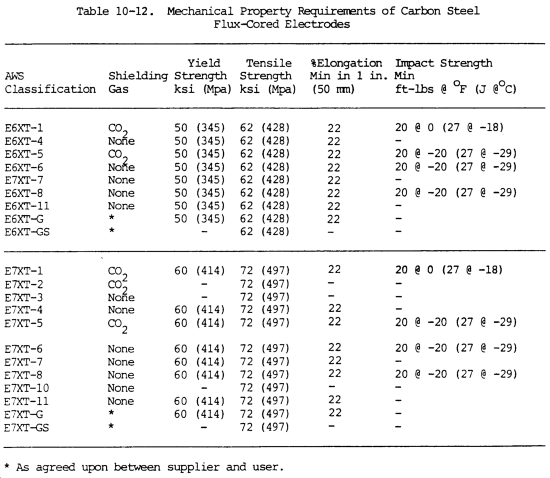
3. The third digit or "0" indicates the welding positions. A "0" indicates flat and horizontal positions and a "1" indicates all positions.
4. The "T" stands for a tubular or flux cored wire classification.
5. The suffix "4" gives the performance and usability capabilities as shown in table 10-13. When a "G" classification is used, no specific performance and usability requirements are indicated. This classification is intended for electrodes not covered by another classification. The chemical composition requirements of the deposited weld metal for carbon steel electrodes are shown in table 10-14. Single pass electrodes do not have chemical composition requirements because checking the chemistry of undiluted weld metal does not give the true results of normal single pass weld chemistry.
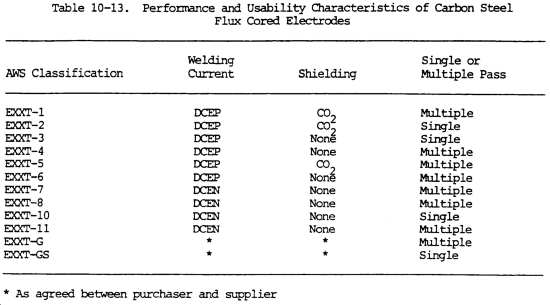

The classification of low alloy steel electrodes is similar to the classification of carbon steel electrodes. An example of a low alloy steel classification is E81T1-NI2 where:
1. The "E" indicates electrode.
2. The second digit or "8" indicates the minimum tensile in strength in units of 10,000 psi (69 MPa). In this case it is 80,000 psi (552 MPa). The mechanical property requirements for low alloy steel electrodes are shown in table 10-15. Impact strength requirements are shown in table 10-16.
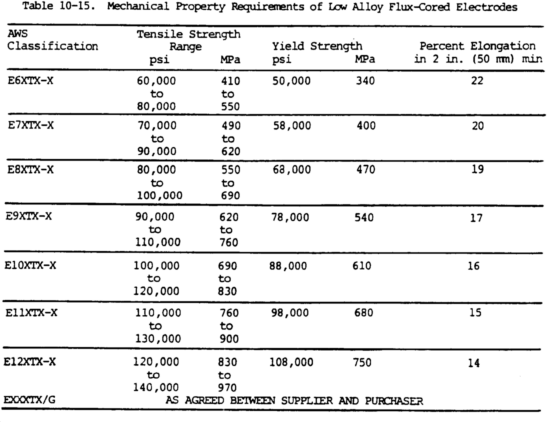
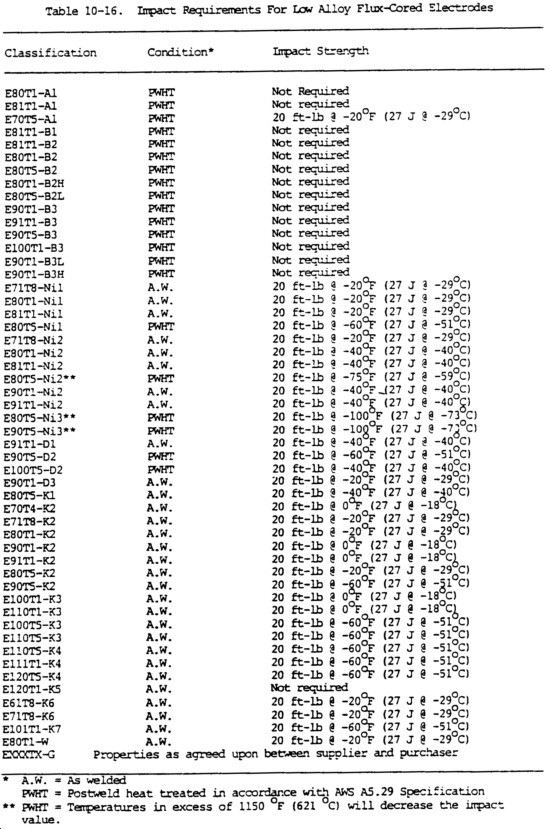
3. The third digit or "1" indicates the welding position capabilities of the electrode. A "1" indicates all positions and an "0" flat and horizontal position only.
4. The "T" indicates a tubular or flux-cored electrode used in flux cored arc welding.
5. The fifth digit or "1" describes the usability and performance characteristics of the electrode. These digits are the same as used in carbon steel electrode classification but only EXXT1-X, EXXT4-X, EXXT5-X and EXXT8-X are used with low alloy steel flux-cored electrode classifications.
6. The suffix or "Ni2" tells the chemical composition of the deposited weld metal as shown in table 10-17 below.
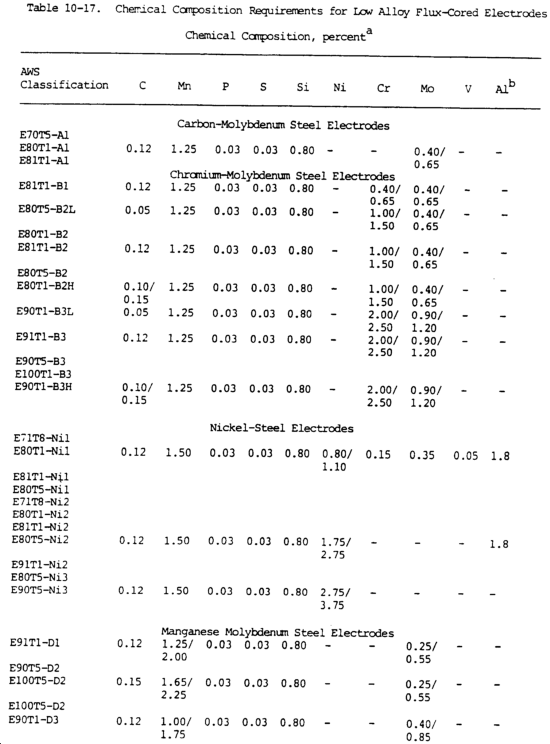
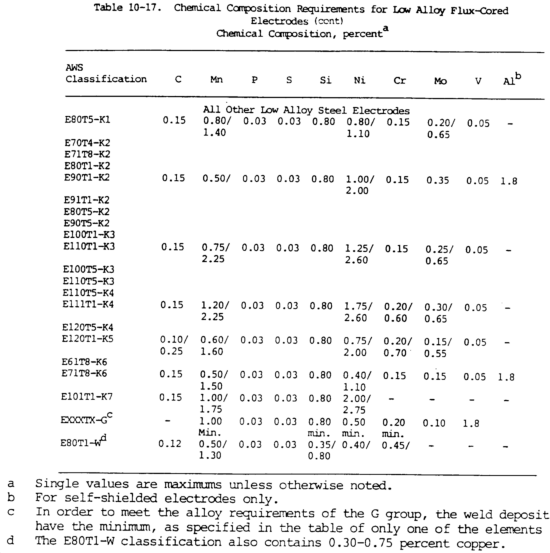
The classification system for stainless steel electrodes is based on the chemical composition of the weld metal and the type of shielding to be employed during welding. An example of a stainless steel electrode classification is E308T-1 where:
1. The "E" indicates the electrode.
2. The digits between the "E" and the "T" indicates the chemical composition of the weld as shown in table 10-18 below.
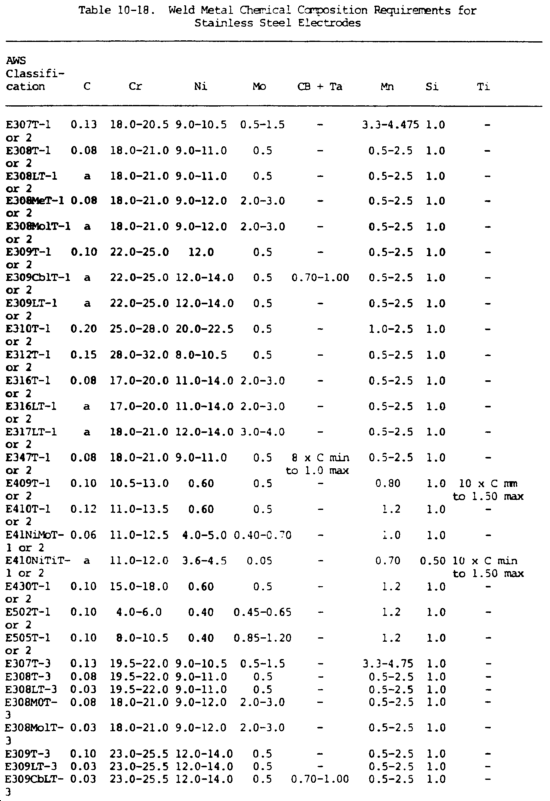
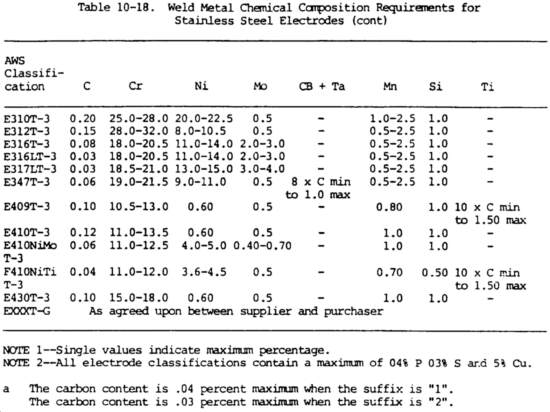
3. The "T" designates a tubular or flux cored electrode wire.
4. The suffix of "1" indicates the type of shielding to be used as shown in table 10-19 below.

(8) Welding Cables.
(a) The welding cables and connectors are used to connect the power source to the welding gun and to the work. These cables are normally made of copper. The cable consists of hundreds of wires that are enclosed in an insulated casing of natural or synthetic rubber. The cable that connects the power source to the welding gun is called the electrode lead. In semiautomatic welding, this cable is often part of the cable assembly, which also includes the shielding gas hose and the conduit that the electrode wire is fed through. For machine or automatic welding, the electrode lead is normally separate. The cable that connects the work to the power source is called the work lead. The work leads are usually connected to the work by pinchers, clamps, or a bolt.
(b) The size of the welding cables used depends on the output capacity of the welding machine, the duty cycle of the machine, and the distance between the welding machine and the work. Cable sizes range from the smallest AWG No 8 to AWG No 4/0 with amperage ratings of 75 amperes on up. Table 10-20 shows recommended cable sizes for use with different welding currents and cable lengths. A cable that is too small may become too hot during welding.

c. Advantages. The major advantages of flux-cored welding are reduced cost and higher deposition rates than either SMAW or solid wire GMAW. The cost is less for flux-cored electrodes because the alloying agents are in the flux, not in the steel filler wire as they are with solid electrodes. Flux-cored welding is ideal where bead appearance is important and no machining of the weld is required. Flux-cored welding without carbon dioxide shielding can be used for most mild steel construction applications. The resulting welds have higher strength but less ductility than those for which carbon dioxide shielding is used. There is less porosity and greater penetration of the weld with carbon dioxide shielding. The flux-cored process has increased tolerances for scale and dirt. There is less weld spatter than with solid-wire MIG welding. It has a high deposition rate, and faster travel speeds are often used. Using small diameter electrode wires, welding can be done in all positions. Some flux-cored wires do not need an external supply of shielding gas, which simplifies the equipment. The electrode wire is fed continuously so there is very little time spent on changing electrodes. A higher percentage of the filler metal is deposited when compared to shield metal arc welding. Finally, better penetration is obtained than from shielded metal arc welding.
d. Disadvantages. Most low-alloy or mild-steel electrodes of the flux-cored type are more sensitive to changes in welding conditions than are SMAW electrodes. This sensitivity, called voltage tolerance, can be decreased if a shielding gas is used, or if the slag-forming components of the core material are increased. A constant-potential power source and constant-speed electrode feeder are needed to maintain a constant arc voltage.
e. Process Principles. The flux-cored welding wire, or electrode, is a hollow tube filled with a mixture of deoxidizers, fluxing agents, metal powders, and ferro-alloys. The closure seam, which appears as a fine line, is the only visible difference between flux-cored wires and solid cold-drawn wire. Flux-cored electrode welding can be done in two ways: carbon dioxide gas can be used with the flux to provide additional shielding, or the flux core alone can provide all the shielding gas and slagging materials. The carbon dioxide gas shield produces a deeply penetrating arc and usually provides better weld than is possible without an external gas shield. Although flux-cored arc welding may be applied semiautomatically, by machine, or automatically, the process is usually applied semiautomatically. In semiautomatic welding, the wire feeder feeds the electrode wire and the power source maintains the arc length. The welder manipulates the welding gun and adjusts the welding parameters. Flux-cored arc welding is also used in machine welding where, in addition to feeding the wire and maintaining the arc length, the machinery also provides the joint travel. The welding operator continuously monitors the welding and makes adjustments in the welding parameters. Automatic welding is used in high production applications.
10-14. SUBMERGED ARC WELDING (SAW)
a. General. Submerged arc welding is a process in which the joining of metals is produced by heating with an arc or arcs between a bare metal electrode or electrodes and the work. The arc is shielded by a blanket of granular fusible material on the work. Pressure is not used. Filler metal is obtained from the electrode or from a supplementary welding rod.
b. Equipment.
(1) The equipment components required for submerged arc welding are shown by figure 10-59. Equipment consists of a welding machine or power source, the wire feeder and control system, the welding torch for automatic welding or the welding gun and cable assembly for semiautomatic welding, the flux hopper and feeding mechanism, usually a flux recovery system, and a travel mechanism for automatic welding.
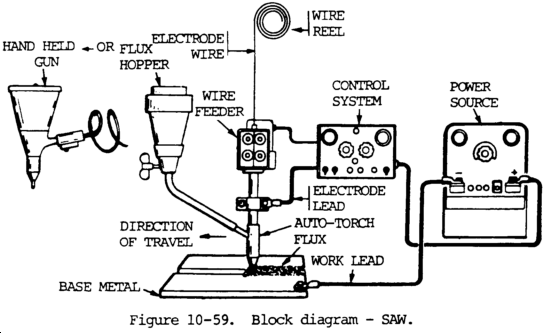
(2) The power source for submerged arc welding must be rated for a 100 percent duty cycle, since the submerged arc welding operations are continuous and the length of time for making a weld may exceed 10 minutes. If a 60 percent duty cycle power source is used, it must be derated according to the duty cycle curve for 100 percent operation.
(3) When constant current is used, either ac or dc, the voltage sensing electrode wire feeder system must be used. When constant voltage is used, the simpler fixed speed wire feeder system is used. The CV system is only used with direct current.
(4) Both generator and transformer-rectifier power sources are used, but the rectifier machines are more popular. Welding machines for submerged arc welding range in size from 300 amperes to 1500 amperes. They may be connected in parallel to provide extra power for high-current applications. Direct current power is used for semiautomatic applications, but alternating current power is used primarily with the machine or the automatic method. Multiple electrode systems require specialized types of circuits, especially when ac is employed.
(5) For semiautomatic application, a welding gun and cable assembly are used to carry the electrode and current and to provide the flux at the arc. A small flux hopper is attached to the end of the cable assembly. The electrode wire is fed through the bottom of this flux hopper through a current pickup tip to the arc. The flux is fed from the hopper to the welding area by means of gravity. The amount of flux fed depends on how high the gun is held above the work. The hopper gun may include a start switch to initiate the weld or it may utilize a "hot" electrode so that when the electrode is touched to the work, feeding will begin automatically.
(6) For automatic welding, the torch is attached to the wire feed motor and includes current pickup tips for transmitting the welding current to the electrode wire. The flux hopper is normally attached to the torch, and may have magnetically operated valves which can be opened or closed by the control system.
(7) Other pieces of equipment sometimes used may include a travel carriage, which can be a simple tractor or a complex moving specialized fixture. A flux recovery unit is normally provided to collect the unused submerged arc flux and return it to the supply hopper.
(8) Submerged arc welding system can become quite complex by incorporating additional devices such as seam followers, weavers, and work rovers.
c. Advantages and Major Uses.
(1) The major advantages of the submerged arc welding process are:
(a) high quality of the weld metal.
(b) extremely high deposition rate and speed.
(c) smooth, uniform finished weld with no spatter.
(d) little or no smoke.
(e) no arc flash, thus minimal need for protective clothing.
(f) high utilization of electrode wire.
(g) easy automation for high-operator factor.
(h) normally, no involvement of manipulative skills.
(2) The submerged arc process is widely used in heavy steel plate fabrication work. This includes the welding of structural shapes, the longitudinal seam of larger diameter pipe, the manufacture of machine components for all types of heavy industry, and the manufacture of vessels and tanks for pressure and storage use. It is widely used in the shipbuilding industry for splicing and fabricating subassemblies, and by many other industries where steels are used in medium to heavy thicknesses. It is also used for surfacing and buildup work, maintenance, and repair.
d. Limitations of the Process.
(1) A major limitation of submerged arc welding is its limitation of welding positions. The other limitation is that it is primarily used only to weld mild and low-alloy high-strength steels.
(2) The high-heat input, slow-cooling cycle can be a problem when welding quenched and tempered steels. The heat input limitation of the steel in question must be strictly adhered to when using submerged arc welding. This may require the making of multipass welds where a single pass weld would be acceptable in mild steel. In some cases, the economic advantages may be reduced to the point where flux-cored arc welding or some other process should be considered.
(3) In semiautomatic submerged arc welding, the inability to see the arc and puddle can be a disadvantage in reaching the root of a groove weld and properly filling or sizing.
e. Principles of Operation.
(1) The submerged arc welding process is shown by figure 10-60. It utilizes the heat of an arc between a continuously fed electrode and the work. The heat of the arc melts the surface of the base metal and the end of the electrode. The metal melted off the electrode is transferred through the arc to the workpiece, where it becomes the deposited weld metal. Shielding is obtained from a blanket of granular flux, which is laid directly over the weld area. The flux close to the arc melts and intermixes with the molten weld metal, helping to purify and fortify it. The flux forms a glass-like slag that is lighter in weight than the deposited weld metal and floats on the surface as a protective cover. The weld is submerged under this layer of flux and slag, hence the name submerged arc welding. The flux and slag normally cover the arc so that it is not visible. The unmelted portion of the flux can be reused. The electrode is fed into the arc automatically from a coil. The arc is maintained automatically. Travel can be manual or by machine. The arc is initiated by a fuse type start or by a reversing or retrack system.
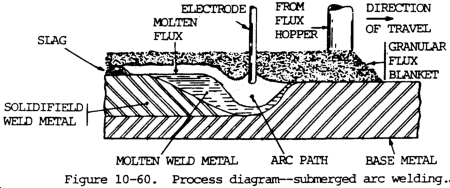
(2) Normal method of application and position capabilities. The most popular method of application is the machine method, where the operator monitors the welding operation. Second in popularity is the automatic method, where welding is a pushbutton operation. The process can be applied semiautomatically; however, this method of application is not too popular. The process cannot be applied manually because it is impossible for a welder to control an arc that is not visible. The submerged arc welding process is a limited-position welding process. The welding positions are limited because the large pool of molten metal and the slag are very fluid and will tend to run out of the joint. Welding can be done in the flat position and in the horizontal fillet position with ease. Under special controlled procedures, it is possible to weld in the horizontal position, sometimes called 3 o'clock welding. This requires special devices to hold the flux up so that the molten slag and weld metal cannot run away. The process cannot be used in the vertical or overhead position.
(3) Metals weldable and thickness range. Submerged arc welding is used to weld low- and medium-carbon steels, low-alloy high-strength steels, quenched and tempered steels, and many stainless steels. Experimentally, it has been used to weld certain copper alloys, nickel alloys, and even uranium. This information is summarized in table 10-21.
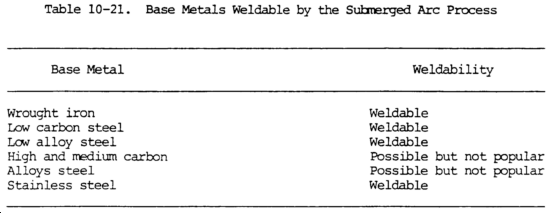
Metal thicknesses from 1/16 to 1/2 in. (1.6 to 12.7 mm) can be welded with no edge preparation. With edge preparation, welds can be made with a single pass on material from 1/4 to 1 in. (6.4 to 25.4 mm). When multipass technique is used, the maximum thickness is practically unlimited. This information is summarized in table 10-22. Horizontal fillet welds can be made up to 3/8 in. (9.5 mm) in a single pass and in the flat position, fillet welds can be made up to 1 in. (25 mm) size.
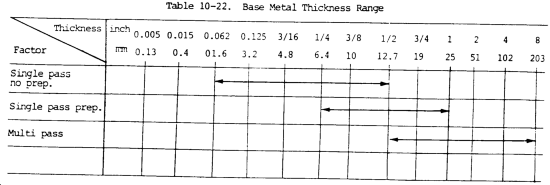
(4) Joint design. Although the submerged arc welding process can utilize the same joint design details as the shielded metal arc welding process, different joint details are suggested for maximum utilization and efficiency of submerged arc welding. For groove welds, the square groove design can be used up to 5/8 in. (16 mm) thickness. Beyond this thickness, bevels are required. Open roots are used but backing bars are necessary since the molten metal will run through the joint. When welding thicker metal, if a sufficiently large root face is used, the backing bar may be eliminate. However, to assure full penetration when welding from one side, backing bars are recommended. Where both sides are accessible, a backing weld can be made which will fuse into the original weld to provide full penetration. Recommended submerged arc joint designs are shown by figure 10-61 below.
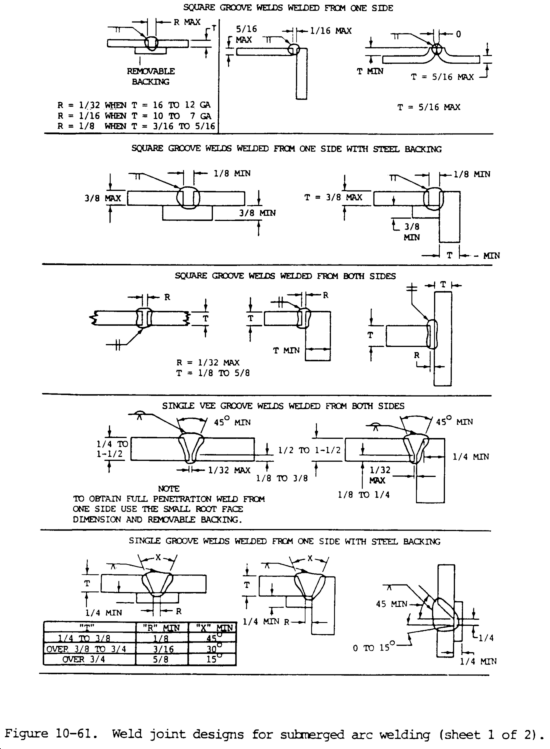
(5) Welding circuit and current.
(a) The welding circuit employed for single electrode submerged arc welding is shown by figure 10-59. This requires a wire feeder system and a power supply.
(b) The submerged arc welding process uses either direct or alternating current for welding power. Direct current is used for most applications which use a single arc. Both direct current electrode positive (DCEP) and electrode negative (DCEN) are used.
(c) The constant voltage type of direct current power is more popular for submerged arc welding with 1/8 in. (3.2 mm) and smaller diameter electrode wires.
(d) The constant current power system is normally used for welding with 5/3 2 in. (4 mm) and larger-diameter electrode wires. The control circuit for CC power is more complex since it attempts to duplicate the actions of the welder to retain a specific arc length. The wire feed system must sense the voltage across the arc and feed the electrode wire into the arc to maintain this voltage. As conditions change, the wire feed must slow down or speed up to maintain the prefixed voltage across the arc. This adds complexity to the control system. The system cannot react instantaneously. Arc starting is more complicated with the constant current system since it requires the use of a reversing system to strike the arc, retract, and then maintain the preset arc voltage.
(e) For ac welding, the constant current power is always used. When multiple electrode wire systems are used with both ac and dc arcs, the constant current power system is utilized. The constant voltage system, however, can be applied when two wires are fed into the arc supplied by a single power source. Welding current for submerged arc welding can vary from as low as 50 amperes to as high as 2000 amperes. Most submerged arc welding is done in the range of 200 to 1200 amperes.
(6) Deposition rates and weld quality.
(a) The deposition rates of the submerged arc welding process are higher than any other arc welding process. Deposition rates for single electrodes are shown by figure 10-62. There are at least four related factors that control the deposition rate of submerged arc welding: polarity, long stickout, additives in the flux, and additional electrodes. The deposition rate is the highest for direct current electrode negative (DCEN). The deposition rate for alternating current is between DCEP and DCEN. The polarity of maximum heat is the negative pole.
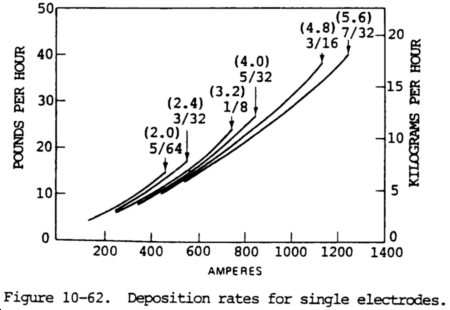
(b) The deposition rate with any welding current can be increased by extending the "stickout." This is the distance from the point where current is introduced into the electrode to the arc. When using "long stickout" the amount of penetration is reduced. The deposition rates can be increased by metal additives in the submerged arc flux. Additional electrodes can be used to increase the overall deposition rate.
(c) The quality of the weld metal deposited by the submerged arc welding process is high. The weld metal strength and ductility exceeds that of the mild steel or low-alloy base material when the correct combination of electrode wire and submerged arc flux is used. When submerged arc welds are made by machine or automatically, the human factor inherent to the manual welding processes is eliminated. The weld will be more uniform and free from inconsistencies. In general, the weld bead size per pass is much greater with submerged arc welding than with any of the other arc welding processes. The heat input is higher and cooling rates are slower. For this reason, gases are allowed more time to escape. Additionally, since the submerged arc slag is lower in density than the weld metal, it will float out to the top of the weld. Uniformity and consistency are advantages of this process when applied automatically.
(d) Several problems may occur when using the semiautomatic application method. The electrode wire may be curved when it leaves the nozzle of the welding gun. This curvature can cause the arc to be struck in a location not expected by the welder. When welding in fairly deep grooves, the curvature may cause the arc to be against one side of the weld joint rather than at the root. This will cause incomplete root fusion. Flux will be trapped at the root of the weld. Another problem with semiautomatic welding is that of completely filling the weld groove or maintaining exact size, since the weld is hidden and cannot be observed while it is being made. This requires making an extra pass. In some cases, too much weld is deposited. Variations in root opening affect the travel speed. If travel speed is uniform, the weld may be under- or overfilled in different areas. High operator skill will overcome this problem.
(e) There is another quality problem associated with extremely large single-pass weld deposits. When these large welds solidify, the impurities in the melted base metal and in the weld metal all collect at the last point to freeze, which is the centerline of the weld. If there is sufficient restraint and enough impurities are collected at this point, centerline cracking may occur. This can happen when making large single-pass flat fillet welds if the base metal plates are 45° from flat. A simple solution is to avoid placing the parts at a true 45° angle. It should be varied approximately 10° so that the root of the joint is not in line with the centerline of the fillet weld. Another solution is to make multiple passes rather than attempting to make a large weld in a single pass.
(f) Another quality problem has to do with the hardness of the deposited weld metal. Excessively hard weld deposits contribute to cracking of the weld during fabrication or during service. A maximum hardness level of 225 Brinell is recommended. The reason for the hard weld in carbon and low-alloy steels is too rapid cooling, inadequate postweld treatment, or excessive alloy pickup in the weld metal. Excessive alloy pickup is due to selecting an electrode that has too much alloy, selecting a flux that introduces too much alloy into the weld, or the use of excessively high welding voltages.
(g) In automatic and machine welding, defects may occur at the start or at the end of the weld. The best solution is to use runout tabs so that starts and stops will be on the tabs rather than on the product.
(7) Weld schedules. The submerged arc welding process applied by machine or fully automatically should be done in accordance with welding procedure schedules. Table 10-23 and figure 10-63, below, show the recommended welding schedules for submerged arc welding using a single electrode on mild and low-alloy steels. The table can be used for welding other ferrous materials, but was developed for mild steel. All of the welds made by this procedure should pass qualification, tests, assuming that the correct electrode and flux have been selected. If the schedules are varied more than 10 percent, qualification tests should be performed to determine the weld quality.
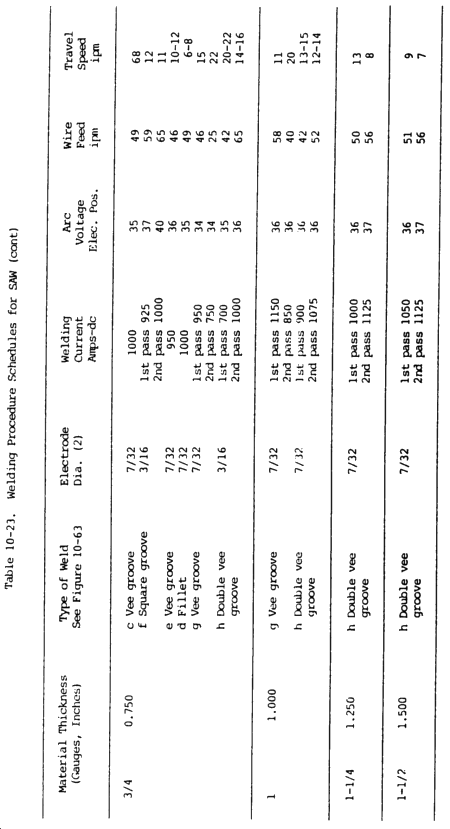
(8) Welding variables.
(a) The welding variables for submerged arc welding are similar to the other arc welding processes, with several exceptions.
(b) In submerged arc welding, the electrode type and the flux type are usually based on the mechanical properties required by the weld. The electrode and flux combination selection is based on table 10-24, below, to match the metal being welded. The electrode size is related to the weld joint size and the current recommended for the particular joint. This must also be considered in determining the number of passes or beads for a particular joint. Welds for the same joint dimension can be made in many or few passes, depending on the weld metal metallurgy desired. Multiple passes usually deposit higher-quality weld metal. Polarity is established initially and is based on whether maximum penetration or maximum deposition rate is required.
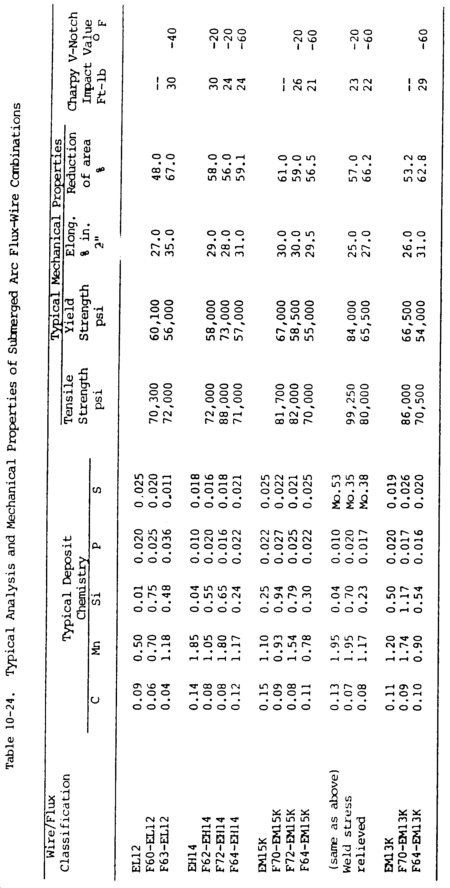
(c) The major variables that affect the weld involve heat input and include the welding current, arc voltage, and travel speed. Welding current is the most important. For single-pass welds, the current should be sufficient for the desired penetration without burn-through. The higher the current, the deeper the penetration. In multi-pass work, the current should be suitable to produce the size of the weld expected in each pass. The welding current should be selected based on the electrode size. The higher the welding current, the greater the melt-off rate (deposition rate).
(d) The arc voltage is varied within narrower limits than welding current. It has an influence on the bead width and shape. Higher voltages will cause the bead to be wider and flatter. Extremely high arc voltage should be avoided, since it can cause cracking. This is because an abnormal amount of flux is melted and excess deoxidizers may be transferred to the weld deposit, lowering its ductility. Higher arc voltage also increases the amount of flux consumed. The low arc voltage produces a stiffer arc that improves penetration, particularly in the bottom of deep grooves. If the voltage is too low, a very narrow bead will result. It will have a high crown and the slag will be difficult to remove.
(e) Travel speed influences both bead width and penetration. Faster travel speeds produce narrower beads that have less penetration. This can be an advantage for sheet metal welding where small beads and minimum penetration are required. If speeds are too fast, however, there is a tendency for undercut and porosity, since the weld freezes quicker. If the travel speed is too slow, the electrode stays in the weld puddle too long. This creates poor bead shape and may cause excessive spatter and flash through the layer of flux.
(f) The secondary variables include the angle of the electrode to the work, the angle of the work itself, the thickness of the flux layer, and the distance between the current pickup tip and the arc. This latter factor, called electrode "stickout," has a considerable effect on the weld. Normally, the distance between the contact tip and the work is 1 to 1-1/2 in. (25 to 38 mm). If the stickout is increased beyond this amount, it will cause preheating of the electrode wire, which will greatly increase the deposition rate. As stickout increases, the penetration into the base metal decreases. This factor must be given serious consideration because in some situations the penetration is required. The relationship between stickout and deposition rate is shown by figure 10-64.
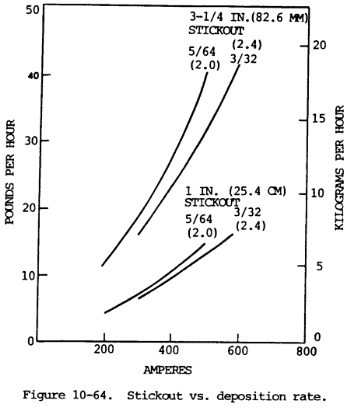
(g) The depth of the flux layer must also be considered. If it is too thin, there will be too much arcing through the flux or arc flash. This also may cause porosity. If the flux depth is too heavy, the weld may be narrow and humped. Too many small particles in the flux can cause surface pitting since the gases generated in the weld may not be allowed to escape. These are sometimes called peck marks on the bead surface.
(9) Tips for using the process.
(a) One of the major applications for submerged arc welding is on circular welds where the parts are rotated under a fixed head. These welds can be made on the inside or outside diameter. Submerged arc welding produces a large molten weld puddle and molten slag which tends to run. This dictates that on outside diameters, the electrode should be positioned ahead of the extreme top, or 12 o'clock position, so that the weld metal will begin to solidify before it starts the downside slope. This becomes more of a problem as the diameter of the part being welded gets smaller. Improper electrode position will increase the possibility of slag entrapment or a poor weld surface. The angle of the electrode should also be changed and pointed in the direction of travel of the rotating part. When the welding is done on the inside circumference, the electrode should be angled so that it is ahead of bottom center, or the 6 o'clock position. Figure 10-65 illustrates these two conditions.
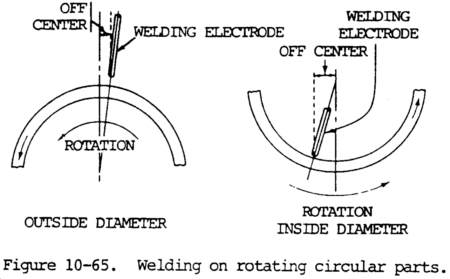
(b) Sometimes the work being welded is sloped downhill or uphill to provide different types of weld bead contours. If the work is sloped downhill, the bead will have less penetration and will be wider. If the weld is sloped uphill, the bead will have deeper penetration and will be narrower. This is based on all other factors remaining the same. This information is shown by figure 10-66.
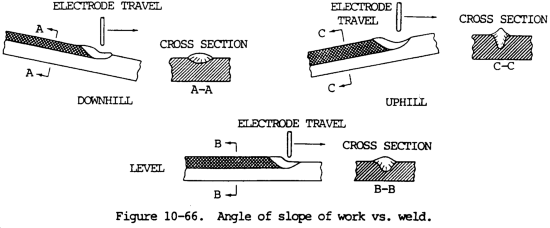
(c) The weld will be different depending on the angle of the electrode with respect to the work when the work is level. This is the travel angle, which can be a drag or push angle. It has a definite effect on the bead contour and weld metal penetration. Figure 10-67 shows the relationship.

(d) One side welding with complete root penetration can be obtained with submerged arc welding. When the weld joint is designed with a tight root opening and a fairly large root face, high current and electrode positive should be used. If the joint is designed with a root opening and a minimum root face, it is necessary to use a backing bar, since there is nothing to support the molten weld metal. The molten flux is very fluid and will run through narrow openings. If this happens, the weld metal will follow and the weld will burn through the joint. Backing bars are needed whenever there is a root opening and a minimum root face.
(e) Copper backing bars are useful when welding thin steel. Without backing bars, the weld would tend to melt through and the weld metal would fall away from the joint. The backing bar holds the weld metal in place until it solidifies. The copper backing bars may be water cooled to avoid the possibility of melting and copper pickup in the weld metal. For thicker materials, the backing may be submerged arc flux or other specialized type flux.
(10) Variations of the process.
(a) There are a large number of variations to the process that give submerged arc welding additional capabilities. Some of the more popular variations are:
1. Two-wire systems--same power source.
2. Two-wire systems--separate power source.
3. Three-wire systems--separate power source.
4. Strip electrode for surfacing.
5. Iron powder additions to the flux.
6. Long stickout welding.
7. Electrically "cold" filler wire.
(b) The multi-wire systems offer advantages since deposition rates and travel speeds can be improved by using more electrodes. Figure 10-68 shows the two methods of utilizing two electrodes, one with a single-power source and one with two power sources. When a single-power source is used, the same drive rolls are used for feeding both electrodes into the weld. When two power sources are used, individual wire feeders must be used to provide electrical insulation between the two electrodes. With two electrodes and separate power, it is possible to utilize different polarities on the two electrodes or to utilize alternating current on one and direct current on the other. The electrodes can be placed side by side. This is called transverse electrode position. They can also be placed one in front of the other in the tandem electrode position.
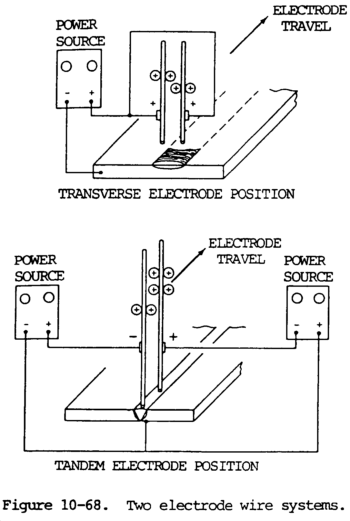
(c) The two-wire tandem electrode position with individual power sources is used where extreme penetration is required. The leading electrode is positive with the trailing electrode negative. The first electrode creates a digging action and the second electrode fills the weld joint. When two dc arcs are in close proximity, there is a tendency for arc interference between them. In some cases, the second electrode is connected to alternating current to avoid the interaction of the arc.
(d) The three-wire tandem system normally uses ac power on all three electrodes connected to three-phase power systems. These systems are used for making high-speed longitudinal seams for large-diameter pipe and for fabricated beams. Extremely high currents can be used with correspondingly high travel speeds and deposition rates.
(e) The strip welding system is used to overlay mild and alloy steels usually with stainless steel. A wide bead is produced that has a uniform and minimum penetration. This process variation is shown by figure 10-69. It is used for overlaying the inside of vessels to provide the corrosion resistance of stainless steel while utilizing the strength and economy of the low-alloy steels for the wall thickness. A strip electrode feeder is required and special flux is normally used. When the width of the strip is over 2 in. (51 mm), a magnetic arc oscillating device is used to provide for even burnoff of the strip and uniform penetration.
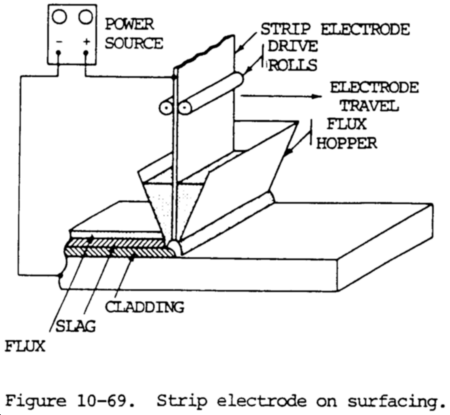
(f) Another way of increasing the deposition rate of submerged arc welding is to add iron base ingredients to the joint under the flux. The iron in this material will melt in the heat of the arc and will become part of the deposited weld metal. This increases deposition rates without decreasing weld metal properties. Metal additives can also be used for special surfacing applications. This variation can be used with single-wire or multi-wire installations. Figure 10-70 shows the increased deposition rates attainable.
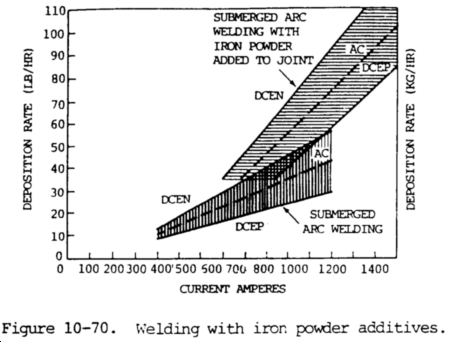
(g) Another variation is the use of an electrically "cold" filler wire fed into the arc area. The "cold" filler rod can be solid or flux-cored to add special alloys to the weld metal. By regulating the addition of the proper material, the properties of the deposited weld metal can be improved. It is possible to utilize a flux-cored wire for the electrode, or for one of the multiple electrodes to introduce special alloys into the weld metal deposit. Each of these variations requires special engineering to ensure that the proper material is added to provide the desired deposit properties.
(11) Typical applications. The submerged arc welding process is widely used in the manufacture of most heavy steel products. These include pressure vessels, boilers, tanks, nuclear reactors, chemical vessels, etc. Another use is in the fabrication of trusses and beams. It is used for welding flanges to the web. The heavy equipment industry is a major user of submerged arc welding.
f. Materials Used.
(1) Two materials are used in submerged arc welding: the welding flux and the consumable electrode wire.
(2) Submerged arc welding flux shields the arc and the molten weld metal from the harmful effects of atmospheric oxygen and nitrogen. The flux contains deoxidizers and scavengers which help to remove impurities from the molten weld metal. Flux also provides a means of introducing alloys into the weld metal. As this molten flux cools to a glassy slag, it forms a covering which protects the surface of the weld. The unmelted portion of the flux does not change its form and its properties are not affected, so it can be recovered and reused. The flux that does melt and forms the slag covering must be removed from the weld bead. This is easily done after the weld has cooled. In many cases, the slag will actually peel without requiring special effort for removal. In groove welds, the solidified slag may have to be removed by a chipping hammer.
(3) Fluxes are designed for specific applications and for specific types of weld deposits. Submerged arc fluxes come in different particle sizes. Many fluxes are not marked for size of particles because the size is designed and produced for the intended application.
(4) There is no specification for submerged arc fluxes in use in North America. A method of classifying fluxes, however, is by means of the deposited weld metal produced by various combinations of electrodes and proprietary submerged arc fluxes. This is covered by the American Welding Society Standard. Bare carbon steel electrodes and fluxes for submerged arc welding. In this way, fluxes can be designated to be used with different electrodes to provide the deposited weld metal analysis that is desired. Table 10-24 shows the flux wire combination and the mechanical properties of the deposited weld metal.
Section III. RELATED PROCESSES
10-15. PLASMA ARC CUTTING (PAC)
a. General. The plasma arc cutting process cuts metal by melting a section of metal with a constricted arc. A high velocity jet flow of hot ionized gas melts the metal and then removes the molten material to form a kerf. The basic arrangement for a plasma arc cutting torch, similar to the plasma arc welding torch, is shown in figure 10-71. Three variations of the process exist: low current plasma cutting, high current plasma cutting, and cutting with water added. Low current arc cutting, which produces high-quality cuts of thin materials, uses a maximum of 100 amperes and a much smaller torch than the high current version. Modifications of processes and equipment have been developed to permit use of oxygen in the orifice gas to allow efficient cutting of steel. All plasma torches constrict the arc by passing it through an orifice as it travels away from the electrode toward the workpiece. As the orifice gas passes through the arc, it is heated rapidly to a high temperature, expands and accelerates as it passes through the constricting orifice. The intensity and velocity of the arc plasma gas are determined by such variables as the type of orifice gas and its entrance pressure, constricting orifice shape and diameter, and the plasma energy density on the work.
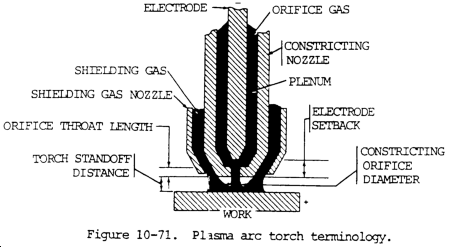
b. Equipment. Plasma arc cutting requires a torch, a control unit, a power supply, one or more cutting gases, and a supply of clean cooling water. Equipment is available for both manual and mechanized PAC.
(1) Cutting torch. A cutting torch consists of an electrode holder which centers the electrode tip with respect to the orifice in the constricting nozzle. The electrode and nozzle are water cooled to prolong their lives. Plasma gas is injected into the torch around the electrode and exits through the nozzle orifice. Nozzles with various orifice diameters are available for each type of torch. Orifice diameter depends on the cutting current; larger diameters are required at higher currents. Nozzle design depends on the type of PAC and the metal being cut. Both single and multiple port nozzles may be used for PAC. Multiple port nozzles have auxiliary gas ports arranged in a circle around the main orifice. All of the arc plasma passes through the main orifice with a high gas flew rate per unit area. These nozzles produce better quality cuts than single port nozzles at equivalent travel speeds. However, cut quality decreases with increasing travel speed. Torch designs for introducing shielding gas or water around the plasma flame are available. PAC torches are similar in appearance to gas tungsten arc welding electrode holders, both manual and machine types. Mechanized PAC torches are mounted on shape cutting machines similar to mechanized oxyfuel gas shape cutting equipment. Cutting may be controlled by photoelectric tracing, numerical control, or computer.
(2) Controls. Control consoles for PAC may contain solenoid valves to turn gases and cooling water on and off. They usually have flowmeters for the various types of cutting gases used and a water flow switch to stop the operation if cooling water flow falls below a safe limit. Controls for high-power automatic PAC may also contain programning features for upslope and downslope of current and orifice gas flow.
(3) Power sources. Power sources for PAC are specially designed units with open-circuit voltages in the range of 120 to 400 V. A power source is selected on the basis of the design of PAC torch to be used, the type and thickness of the work metal, and the cutting speed range. Their volt-ampere output characteristic must be the typical drooping type.
(a) Heavy cutting requires high open-circuit voltage (400 V) for capability of piercing material as thick as 2 in. (51 mm). Low current, manual cutting equipment uses lower open-circuit voltages (120 to 200 V). Some power sources have the connections necessary to change the open-circuit voltage as required for specific applications.
(b) The output current requirements range from about 70 to 1000 A depending on the material, its thickness, and cutting speed. The unit may also contain the pilot arc and high frequency power source circuitry.
(4) Gas selection.
(a) Cutting gas selection depends on the material being cut and the cut surface quality requirements. Most nonferrous metals are cut by using nitrogen, nitrogen-hydrogen mixtures, or argon-hydrogen mixtures. Titanium and zirconium are cut with pure argon because of their susceptibility to embrittlement by reactive gases.
(b) Carbon steels are cut by using compressed air (80 percent N2, 20 percent 02) or nitrogen for plasma gas. Nitrogen is used with the water injection method of PAC. Some systems use nitrogen for the plasma forming gas with oxygen injected into the plasma downstream of the electrode. This arrangement prolongs the life of the electrode by not exposing it to oxygen.
(c) For some nonferrous cutting with the dual flow system, nitrogen is used for the plasma gas with carbon dioxide (C02) for shielding. For better quality cuts, argon-hydrogen plasma gas and nitrogen shielding are used.
c. Principles of Operation.
(1) The basic plasma arc cutting circuitry is shown in figure 10-72. The process operates on direct current, straight polarity (dcsp), electrode negative, with a constricted transferred arc. In the transferred arc mode, an arc is struck between the electrode in the torch and the workpiece. The arc is initiated by a pilot arc between the electrode and the constricting nozzle. The nozzle is connected to ground (positive) through a current limiting resistor and a pilot arc relay contact. The pilot arc is initiated by a high frequency generator connected to the electrode and nozzle. The welding power supply then maintains this low current arc inside the torch. Ionized orifice gas from the pilot arc is blown through the constricting nozzle orifice. This forms a low resistance path to ignite the main arc between the electrode and the workpiece. When the main arc ignites, the pilot arc relay may be opened automatically to avoid unnecessary heating of the constricting nozzle.
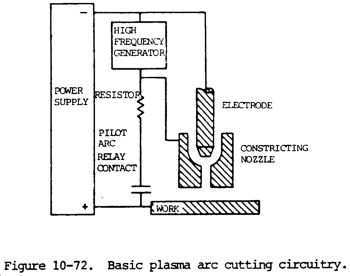
(2) Because the plasma constricting nozzle is exposed to the high plasma flare temperatures (estimated at 18,032 to 25,232°F (10,000 to 14,000°C)), the nozzle must be made of water-cooled copper. In addition, the torch should be de-signed to produce a boundary layer of gas between the plasma and the nozzle.
(3) Several process variations are used to improve the PAC quality for particular applications. They are generally applicable to materials in the 1/8 to 1-1/2 in. (3 to 38 mm) thickness range. Auxiliary shielding, in the form of gas or water, is used to improve cutting quality.
(a) Dual flow plasma cutting. Dual flow plasma cutting provides a secondary gas blanket around the arc plasma, as shown in figure 10-73. The usual orifice gas is nitrogen. The shielding gas is selected for the material to be cut. For mild steel, it may be carbon dioxide (CO2) or air; for stainless steals, CO2; and an argon-hydrogen mixture for aluminum. For mild steel, cutting speeds are slightly faster than with conventional PAC, but the cut quality is not satisfactory for many applications.
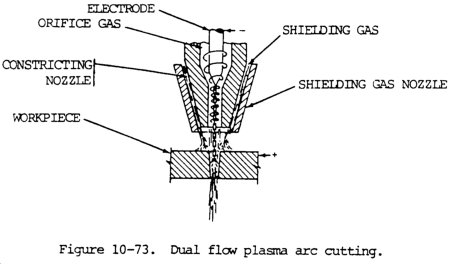
(b) Water shield plasma cutting. This technique is similar to dual flow plasma cutting. Water is used in place of the auxiliary shielding gas. Cut appearance and nozzle life are improved by the use of water in place of gas for auxiliary shielding. Cut squareness and cutting speed are not significantly improved over conventional PAC.
(c) Water injection plasma cutting. This modification of the PAC process uses a symmetrical impinging water jet near the constricting nozzle orifice to further constrict the plasma flame. The arrangement is shown in figure 10-74. The water jet also shields the plasma from mixing with the surrounding atmosphere. The end of the nozzle can be made of ceramic, which helps to prevent double arcing. The water constricted plasma produces a narrow, sharply defined cut at speeds above those of conventional PAC. Because most of the water leaves the nozzle as a liquid spray, it cools the kerf edge, producing a sharp corner. The kerf is clean. When the orifice gas and water are injected in tangent, the plasma gas swirls as it emerges from the nozzle and water jet. This can produce a high quality perpendicular face on one side of the kerf. The other side of the kerf is beveled. In shape cutting applications, the direction of travel must be selected to produce a perpendicular cut on the part and the bevel cut on the scrap.

(4) For high current cutting, the torch is mounted on a mechanical carriage. Automatic shape cutting can be done with the same equipment used for oxygen cutting, if sufficiently high travel speed is attainable. A water spray is used surrounding the plasma to reduce smoke and noise. Work tables containing water which is in contact with the underside of the metal being cut will also reduce noise and smoke.
(5) The plasma arc cutting torch can be used in all positions. It can also be used for piercing holes and for gouging. The cutting torch is of special design for cutting and is not used for welding.
(6) The metals usually cut with this process are the aluminums and stainless steels. The process can also be used for cutting carbon steels, copper alloys, and nickel alloys.
(7) Special controls are required to adjust both plasma and secondary gas flow. Torch-cooling water is required and is monitored by pressure or flow switches for torch protection. The cooling system should be self-contained, which includes a circulating pump and a heat exchanger.
(8) Plasma cutting torches will fit torch holders in automatic flame cutting machines.
(9) The amount of gases and tines generated requires the use of local exhaust for proper ventilation. Cutting should be done over a water reservoir so that the particles removed from the cut will fall in the water. This will help reduce the amount of fumes released into the air.
d. Applications. Plasma arc cutting can be used to cut any metal. Most applications are for carbon steel, aluminum, and stainless steel. It can be used for stack cutting, plate beveling, shape cutting, and piercing.
WARNING
Ear protection must be worn when working with high-powered equipment.
(1) The noise level generated by the high-powered equipment is uncomfortable. The cutter must wear ear protection. The normal protective clothing to protect the cutter from the arc must also be worn. This involves protective clothing, gloves, and helmet. The helmet should be equipped with a shade no. 9 filter glass lens.
(2) There are many applications for low-current plasma arc cutting, including the cutting of stainless and aluminum for production and maintenance. Plasma cutting can also be used for stack cutting and it is more efficient than stack cutting with the oxyacetylene torch. Low current plasma gouging can also be used for upgrading castings.
10-16. AIR CARBON ARC CUTTING (AAC)
a. General. Air carbon arc cutting is an arc cutting process in which metals to be cut are melted by the heat of a carbon arc. The molten metal is removed by a blast of air. This is a method for cutting or removing metal by melting it with an electric arc and then blowing away the molten metal with a high velocity jet of compressed air. The air jet is external to the consumable carbon-graphite electrode. It strikes the molten metal immediately behind the arc. Air carbon arc cutting and metal removal differ from plasma arc cutting in that they employ an open (unconstricted) arc, which is independent of the gas jet. The air carbon arc process is shown in figure 10-75.
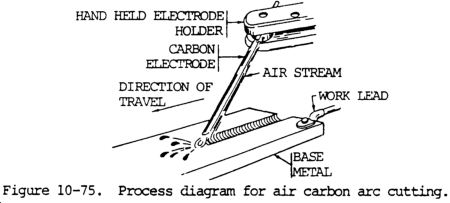
b. Equipment.
(1) The circuit diagram for air carbon arc cutting or gouging is shown by figure 10-76. Normally, conventional welding machines with constant current are used. Constant voltage can be used with this process. When using a CV power source, precautions must be taken to operate it within its rated output of current and duty cycle. Alternating current power sources having conventional drooping characteristics can also be used for special applications. AC type carbon electrodes must be used.

(2) Equipment required is shown by the block diagram. Special heavy duty high current machines have been made specifically for the air carbon arc process. This is because of extremely high currents used for the large size carbon electrodes.
(3) The electrode holder is designed for the air carbon arc process. The holder includes a small circular grip head which contains the air jets to direct compressed air along the electrode. It also has a groove for gripping the electrode. This head can be rotated to allow different angles of electrode with respect to the holder. A heavy electrical lead and an air supply hose are connected to the holder through a terminal block. A valve is included in the holder for turning the compressed air on and off. Holders are available in several sizes depending on the duty cycle of the work performed, the welding current, and size of carbon electrode used. For extra heavy duty work, water-cooled holders are used.
(4) The air pressure is not critical but should range from 80 to 100 psi (552 to 690 kPa). The volume of compressed air required ranges from as low as 5 cu ft per min (2.5 liter per min) up to 50 cu ft per min (24 liter per min) for the largest-size carbon electrodes. A one-horsepower compressor will supply sufficient air for smaller-size electrodes. It will require up to a ten-horsepower compressor when using the largest-size electrodes.
(5) The carbon graphite electrodes are made of a mixture of carbon and graphite plus a binder which is baked to produce a homogeneous structure. Electrodes come in several types.
(a) The plain uncoated electrode is less expensive, carries less current, and starts easier.
(b) The copper-coated electrode provides better electrical conductivity between it and the holder. The copper-coated electrode is better for maintaining the original diameter during operation. It lasts longer and carries higher current. Copper-coated electrodes are of two types, the dc type and the ac type. The composition ratio of the carbon and graphite is slightly different for these two types. The dc type is more common. The ac type contains special elements to stabilize the arc. It is used for direct current electrode negative when cutting cast irons. For normal use, the electrode is operated with the electrode positive. Electrodes range in diameter from 5/32 to 1 in. (4.0 to 25.4 mm). Electrodes are normally 12 in. (300 mm) long; however, 6 in. (150 mm) electrodes are available Copper-coated electrodes with tapered socket joints are available for automatic operation, and allow continuous operation. Table 10-25 shows the electrode types and the arc current range for different sizes.
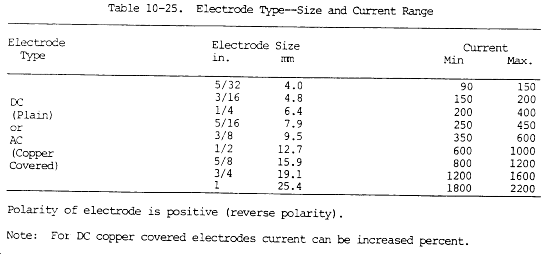
c. Advantages and Major Uses.
(1) The air carbon arc cutting process is used to cut metal, to gouge out defective metal, to remove old or inferior welds, for root gouging of full penetration welds, and to prepare grooves for welding. Air carbon arc cutting is used when slightly ragged edges are not objectionable. The area of the cut is small and, since the metal is melted and removed quickly, the surrounding area does not reach high temperatures. This reduces the tendency towards distortion and cracking.
(2) The air carbon arc cutting and gouging process is normally manually operated. The apparatus can be mounted on a travel carriage. This is considered machine cutting or gouging. Special applications have been made where cylindrical work has been placed on a lathe-like device and rotated under the air carbon arc torch. This is machine or automatic cutting, depending on operator involvement.
(3) The air carbon arc cutting process can be used in all positions. It can also be used for gouging in all positions. Use in the overhead position requires a high degree of skill.
(4) The air carbon arc process can be used for cutting or gouging most of the common metals. Metals include: aluminums, copper, iron, magnesium, and carbon and stainless steels.
(5) The process is not recommended for weld preparation for stainless steel, titanium, zirconium, and other similar metals without subsequent cleaning. This cleaning, usually by grinding, must remove all of the surface carbonized material adjacent to the cut. The process can be used to cut these materials for scrap for remelting.
d. Process Principles.
(1) The procedure schedule for making grooves in steel is shown in table 10-26 below.

(2) To make a cut or a gouging operation, the cutter strikes an arc and al-most immediately starts the air flow. The electrode is pointed in the direction of travel with a push angle approximately 45° with the axis-of the groove. The speed of travel, the electrode angle, and the electrode size and current determine the groove depth. Electrode diameter determines the groove width.
(3) The normal safety precautions similar to carbon arc welding and shielded metal arc welding apply to air carbon arc cutting and gouging. However, two other precautions must be observed. First, the air blast will cause the molten metal to travel a very long distance. Metal deflection plates should be placed in front of the gouging operation. All combustible materials should be moved away from the work area. At high-current levels, the mass of molten metal removed is quite large and will become a fire hazard if not properly contained.
(4) The second factor is the high noise level. At high currents with high air pressure a very loud noise occurs. Ear protection, ear muffs or ear plugs should be worn by the arc cutter.
(5) The process is widely used for back gouging, preparing joints, and removing defective weld metal.
10-17. RESISTANCE WELDING
a. General. Resistance welding is a group of welding processes in which coalescence is produced by the heat obtained from resistance of the work to electric current in a circuit of which the work is a part and by the application of pressure. There are at least seven important resistance-welding processes. These are flash welding, high frequency resistance welding, percussion welding, projection welding, resistance seam welding, resistance spot welding, and upset welding.
b. Principles of the Process.
(1) The resistance welding processes differ from all those previously mentioned. Filler metal is rarely used and fluxes are not employed. Three factors involved in making a resistance weld are the amount of current that passes through the work, the pressure that the electrodes transfer to the work, and the time the current flows through the work. Heat is generated by the passage of electrical current through a resistance circuit. The force applied before, during, and after the current flow forces the heated parts together so that coalescence will occur. Pressure is required throughout the entire welding cycle to assure a continuous electrical circuit through the work.
(2) This concept of resistance welding is most easily understood by relating it to resistance spot welding. Resistance spot welding, the most popular, is shown by figure 10-77. High current at a low voltage flows through the circuit and is in accordance with Ohm�s law,
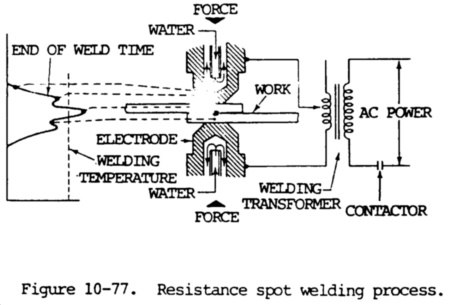
(a) I is the current in amperes, E is the voltage in volts, and R is the resistance of the material in ohms. The total energy is expressed by the formula: Energy equals I x E x T in which T is the time in seconds during which current flows in the circuit.
(b) Combining these two equations gives H (heat energy) = 12 x R x T. For practical reasons a factor which relates to heat losses should be included; therefore, the actual resistance welding formula is
H (heat energy) =I2 x R x T x K
(c) In this formula, I = current squared in amperes, R is the resistance of the work in ohms, T is the time of current flow in seconds, and K represents the heat losses through radiation and conduction.
(3) Welding heat is proportional to the square of the welding current. If the current is doubled, the heat generated is quadrupled. Welding heat is proportional to the total time of current flow, thus, if current is doubled, the time can be reduced considerably. The welding heat generated is directly proportional to the resistance and is related to the material being welded and the pressure applied. The heat losses should be held to a minimum. It is an advantage to shorten welding tire. Mechanical pressure which forces the parts together helps refine the grain structure of the weld.
(4) Heat is also generated at the contact between the welding electrodes and the work. This amount of heat generated is lower since the resistance between high conductivity electrode material and the normally employed mild steel is less than that between two pieces of mild steel. In most applications, the electrodes are water cooled to minimize the heat generated between the electrode and the work.
(5) Resistance welds are made very quickly; however, each process has its own time cycle.
(6) Resistance welding operations are automatic. The pressure is applied by mechanical, hydraulic, or pneumatic systems. Motion, when it is involved, is ap-plied mechanically. Current control is completely automatic once the welding operator initiates the weld. Resistance welding equipment utilizes programmers for controlling current, time cycles, pressure, and movement. Welding programs for resistance welding can become quite complex. In view of this, quality welds do not depend on welding operator skill but more on the proper set up and adjustment of the equipment and adherence to weld schedules.
(7) Resistance welding is used primarily in the mass production industries where long production runs and consistent conditions can be maintained. Welding is performed with operators who normally load and unload the welding machine and operate the switch for initiating the weld operation. The automotive industry is the major user of the resistance welding processes, followed by the appliance industry. Resistance welding is used by many industries manufacturing a variety of products made of thinner gauge metals. Resistance welding is also used in the steel industry for manufacturing pipe, tubing and smaller structural sections. Resistance welding has the advantage of producing a high volume of work at high speeds and does not require filler materials. Resistance welds are reproducible and high-quality welds are normal.
(8) The position of making resistance welds is not a factor, particularly in the welding of thinner material.
c. Weldable Metals.
(1) Metals that are weldable, the thicknesses that can be welded, and joint design are related to specific resistance welding processes. Most of the common metals can be welded by many of the resistance welding processes (see table 10-27). Difficulties may be encountered when welding certain metals in thicker sections. Some metals require heat treatment after welding for satisfactory mechanical properties.
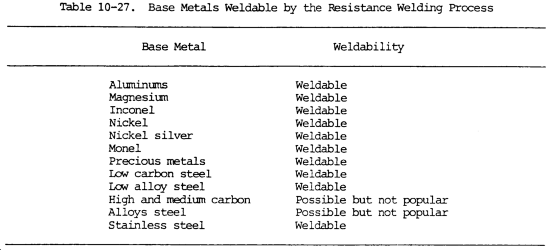
(2) Weldability is controlled by three factors: resistivity, thermal conductivity, and melting temperature.
(3) Metals with a high resistance to current flow and with a low thermal conductivity and a relatively low melting temperature would be easily weldable. Ferrous metals all fall into this category. Metals that have a lower resistivity but a higher thermal conductivity will be slightly more difficult to weld. This includes the light metals, aluminum and magnesium. The precious metals comprise the third group. These are difficult to weld because of very high thermal conductivity. The fourth group is the refractory metals, which have extremely high melting points and are more difficult to weld.
(4) These three properties can be combined into a formula which will provide an indication of the ease of welding a metal. This formula is:

In this formula, W equals weldability, R is resistivity, and F is the melting temperature of the metal in degrees C, and Kt is the relative thermal conductivity with copper equal to 1.00. If weldability (W) is below 0.25, it is a poor rating. If W is between 0.25 and 0.75, weldability becomes fair. Between 0.75 and 2.0, weldability is good. Above 2.0 weldability is excellent. In this formula, mild steel would have a weldability rating of over 10. Aluminum has a weldability factor of from 1 to 2 depending on the alloy and these are considered having a good weldability rating. Copper and certain brasses have a low weldability factor and are known to be very difficult to weld.
10-18. FLASH WELDING (FW)
a. General.
(1) Flash welding is a resistance welding process which produces coalescence simultaneously over the entire area of abutting surfaces by the heat obtained from resistance to electric current between the two surfaces, and by the application of pressure after heating is substantially completed. Flashing and upsetting are accompanied by expulsion of metal from the joint. This is shown by figure 10-78. During the welding operation, there is an intense flashing arc and heating of the metal on the surfaces abutting each other. After a predetermined time, the two pieces are forced together and joining occurs at the interface. Current flow is possible because of the light contact between the two parts being flash welded. Heat is generated by the flashing and is localized in the area between the two parts. The surfaces are brought to the melting point and expelled through the abutting area. As soon as this material is flashed away, another small arc is formed which continues until the entire abutting surfaces are at the melting temperature. Pressure is then applied. The arcs are extinguished and upsetting occurs.
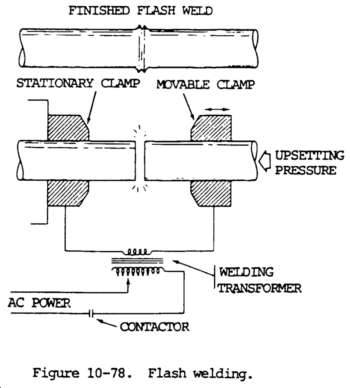
(2) Flash welding can be used on most metals. No special preparation is required except that heavy scale, rust, and grease must be removed. The joints must be cut square to provide an even flash across the entire surface. The material to be welded is clamped in the jaws of the flash welding machine with a high clamping pressure. The upset pressure for steel exceeds 10,000 psi (68, 950 kPa). For high-strength materials, these pressures may be doubled. For tubing or hollow members, the pressures are reduced. As the weld area is more compact, upset pressures are increased. If insufficient upset pressure is used, a porous low strength weld will result. Excess upset pressure will result in expelling too much weld metal and upsetting cold metal. The weld may not be uniform across the entire cross section, and fatigue and impact strength will be reduced. The speed of upset, or the time between the end of flashing period and the end of the upset period, should be extremely short to minimize oxidation of the molten surfaces. In the flash welding operation, a certain amount of material is flashed or burned away. The distance between the jaws after welding compared to the distance before welding is known as the burnoff. It can be from 1/8 in. (3.2 mm) for thin material up to several inches for heavy material. Welding currents are high and are related to the following: 50 kva per square in. cross section at 8 seconds. It is desirable to use the lowest flashing voltage at a desired flashing speed. The lowest voltage is normally 2 to 5 volts per square in. of cross section of the weld.
(3) The upsetting force is usually accomplished by means of mechanical cam action. The design of the cam is related to the size of the parts being welded. Flash welding is completely automatic and is an excellent process for mass-produced parts. It requires a machine of large capacity designed specifically for the parts to be welded. Flash welds produce a fin around the periphery of the weld which is normally removed.
10-19. FRICTION WELDING (FRW)
a. General.
(1) Friction welding is a solid state welding process which produces coalescence of materials by the heat obtained from mechanically-induced sliding motion between rubbing surfaces. The work parts are held together under pressure. This process usually involves the rotating of one part against another to generate frictional heat at the junction. When a suitable high temperature has keen reached, rotational notion ceases. Additional pressure is applied and coalescence occurs.
(2) There are two variations of the friction welding process. They are described below.
(a)
In the original process, one part is held stationary and the other part is rotated by a motor which maintains an essentially constant rotational speed. The two parts are brought in contact under pressure for a specified period of time with a specific pressure. Rotating power is disengaged from the rotating piece and the pressure is increased. When the rotating piece stops, the weld is completed. This process can be accurately controlled when speed, pressure, and time are closely regulated.(b) The other variation is inertia welding. A flywheel is revolved by a motor until a preset speed is reached. It, in turn, rotates one of the pieces to be welded. The motor is disengaged from the flywheel and the other part to be welded is brought in contact under pressure with the rotating piece. During the predetermined time during which the rotational speed of the part is reduced, the flywheel is brought to an immediate stop. Additional pressure is provided to complete the weld.
(c) Both methods utilize frictional heat and produce welds of similar quality. Slightly better control is claimed with the original process. The two methods are similar, offer the same welding advantages, and are shown by figure 10-79.
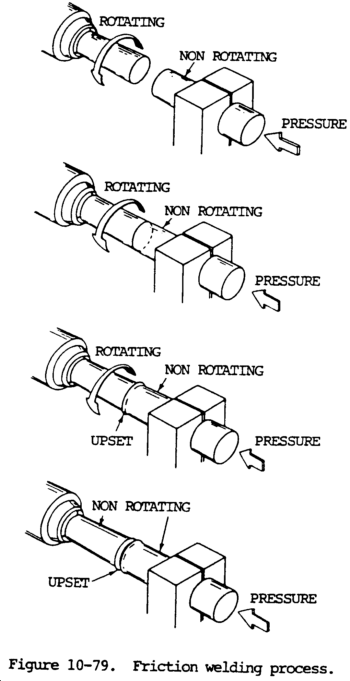
b. Advantages.
(1) Friction welding can produce high quality welds in a short cycle time.
(2) No filler metal is required and flux is not used.
(3) The process is capable of welding most of the common metals. It can also be used to join many combinations of dissimilar metals. Friction welding requires relatively expensive apparatus similar to a machine tool.
c. Process Principles.
(1) There are three important factors involved in making a friction weld:
(a) The rotational speed which is related to the material to be welded and the diameter of the weld at the interface.
(b) The pressure between the two parts to be welded. Pressure changes during the weld sequence. At the start, pressure is very low, but is increased to create the frictional heat. When the rotation is stopped, pressure is rapidly increased so forging takes place immediately before or after rotation is stopped.
(c) The welding time is related to the shape and the type of metal and the surface area. It is normally a matter of a few seconds. The actual operation of the machine is automatic. It is controlled by a sequence controller, which can be set according to the weld schedule established for the parts to be joined.
(2) Normally for friction welding, one of the parts to be welded is round in cross section. This is not an absolute necessity. Visual inspection of weld quality can be based on the flash, which occurs around the outside perimeter of the weld. This flash will usually extend beyond the outside diameter of the parts and will curl around back toward the part but will have the joint extending beyond the outside diameter of the part.
(a) If the flash sticks out relatively straight from the joint, it indicates that the welding time was was too short, the pressure was too low, or the speed too high. These joints may crack.
(b) If the flash curls too far back on the outside diameter, it indicates that the time was too long and the pressure was too high.
(c) Between these extremes is the correct flash shape. The flash is normally removed after welding.
10-20. ELECTRON BEAM WELDING
a. General.
(1) Electron beam welding (EBW) is a welding process which produces coalescence of metals with heat from a concentrated beam of high velocity electrons striking the surfaces to be joined. Heat is generated in the workpiece as it is bombarded by a dense stream of high-velocity electrons. Virtually all of the kinetic energy, or the energy of motion, of the electrons is transformed into heat upon impact.
(2) Two basic designs of this process are: the low-voltage electron beam system, which uses accelerating voltages in 30,000-volt (30 kv) to 60,000-volt (60 kv) range, and the high voltage system with accelerating voltages in the 100,000-volt (100 kv) range. The higher voltage system emits more X-rays than the lower voltage system. In an X-ray tube, the beam of electrons is focused on a tar-get of either tungsten or molybdenum which gives off X-rays. The target becomes extremely hot and must be water cooled. In welding, the target is the base metal which absorbs the heat to bring it to the molten stage. In electron beam welding, X-rays may be produced if the electrical potential is sufficiently high. In both systems, the electron gun and the workpiece are housed in a vacuum chamber. Figure 10-80 shows the principles of the electron beam welding process.
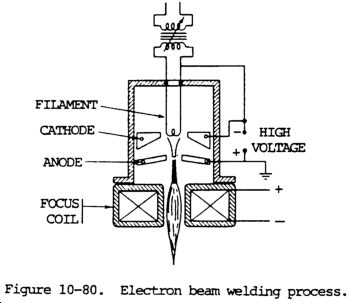
b. Equipment.
(1) There are three basic components in an electron beam welding machine. These are the electron beam gun, the power supply with controls, and a vacuum work chamber with work-handling equipment.
(2) The electron beam gun emits electrons, accelerates the beam of electrons, and focuses it on the workpiece. The electron beam gun is similar to that used in a television picture tube. The electrons are emitted by a heated cathode or filament and accelerated by an anode which is a positively-charged plate with a hole through which the electron beam passes. Magnetic focusing coils located beyond the anode focus and deflect the electron beam.
(3) In the electron beam welding machine, the electron beam is focused on the workpiece at the point of welding. The power supply furnishes both the filament current and the accelerating voltage. Both can be changed to provide different power input to the weld.
(4) The vacuum work chamber must be an absolutely airtight container. It is evacuated by means of mechanical pumps and diffusion pumps to reduce the pressure to a high vacuum. Work-handling equipment is required to move the workpiece under the electron beam and to manipulate it as required to make the weld. The travel mechanisms must be designed for vacuum installations since normal greases, lubricants, and certain insulating varnishes in electric rotors may volatilize in a vacuum. Heretically sealed motors and sealed gearboxes must be used. In some cases, the rotor and gearboxes are located outside the vacuum chamber with shafts operating through sealed bearings.
c. Advantages. One of the major advantages of electron beam welding is its tremendous penetration. This occurs when the highly accelerated electron hits the base metal. It will penetrate slightly below the surface and at that point release the bulk of its kinetic energy which turns to heat energy. The addition of the heat brings about a substantial temperature increase at the point of impact. The succession of electrons striking the same place causes melting and then evaporation of the base metal. This creates metal vapors but the electron beam travels through the vapor much easier than solid metal. This causes the beam to penetrate deeper into the base metal. The width of the penetration pattern is extremely narrow. The depth-to-width can exceed a ratio of 20 to 1. As the power density is increased, penetration is increased. Since the electron beam has tremendous penetrating characteristics, with the lower heat input, the heat affected zone is much smaller than that of any arc welding process. In addition, because of the almost parallel sides of the weld nugget, distortion is very greatly minimized. The cooling rate is much higher and for many metals this is advantageous; however, for high carbon steel this is a disadvantage and cracking may occur.
d. Process Principles.
(1) Recent advances in equipment allow the work chamber to operate at a medium vacuum or pressure. In this system, the vacuum in the work chamber is not as high. It is sometimes called a "soft" vacuum This vacuum range allowed the same contamination that would be obtained in atmosphere of 99.995 percent argon. Mechanical pumps can produce vacuums to the medium pressure level.
(2) Electron beam welding was initially done in a vacuum because the electron beam is easily deflected by air. The electrons in the beam collide with the molecules of the air and lose velocity and direction so that welding can not be performed.
(3) In a high vacuum system, the electron beam can be located as far as 30.0 in. (762.0 mm) away from the workpiece. In the medium vacuum, the working distance is reduced to 12.0 in. (304.8 mm). The thickness that can be welded in a high vacuum is up to 6.0 in. (152.4 mm) thick while in the medium vacuum the thickness that can be welded is reduced to 2.0 in. (50.8 mm). This is based on the same electron gun and power in both cases. With the medium vacuum, pump down time is reduced. The vacuum can be obtained by using mechanical pumps only. In the medium vacuum mode, the electron gun is in its own separate chamber separate from the work chamber by a small orifice through which the electron beam travels. A diffusion vacuum pump is run continuously, connected to the chamber containing the electron gun, so that it will operate efficiently.
(4) The most recent development is the nonvacuum electron beam welding system. In this system, the work area is maintained at atmospheric pressure during welding. The electron beam gun is housed in a high vacuum chamber. There are several intermediate chambers between the gun and the atmospheric work area. Each of these intermediate stages is reduced in pressure by means of vacuum pumps. The electron beam passes from one chamber to another through a small orifice large enough for the electron beam but too small for a large volume of air. By means of these differential pressure chambers, a high vacuum is maintained in the electron beam gun chamber. The nonvacuum system can thus be used for the largest weldments, however the workpiece must be positional with 1-1/2 in. (38 mm) of the beam exit nozzle. The maximum thickness that can be welded currently is approximately 2 in. (51 mm). The nonvacuum system utilizes the high-voltage power supply.
(5) The heat input of electron beam welding is controlled by four variables:
(a) Number of electrons per second hitting the workpiece or beam current.
(b) Electron speed at the moment of impact, the accelerating potential.
(c) Diameter of the beam at or within the workpiece, the beam spot size.
(d) Speed of travel or the welding speed.
(6) The first two variables in (5), beam current and accelerating potential, are used in establishing welding parameters. The third factor, the beam spot size, is related to the focus of the beam, and the fourth factor is also part of the procedure. The electron beam current ranges from 250 to 1000 milliamperes, the beam currents can be as low as 25 milliamperes. The accelerating voltage is within the two ranges mentioned previously. Travel speeds can be extremely high and relate to the thickness of the base metal. The other parameter that must be controlled is the gun-to-work distance.
(7) The beam spot size can be varied by the location of the fecal point with respect to the surface of the part. Penetration can be increased by placing the fecal point below the surface of the base metal. As it is increased in depth below the surface, deeper penetration will result. When the beam is focused at the surface, there will be more reinforcement on the surface. When the beam is focused above the surface, there will be excessive reinforcement and the width of the weld will be greater.
(8) Penetration is also dependent on the beam current. As beam current is increased, penetration is increased. The other variable, travel speed, also affects penetration. As travel speed is increased, penetration is reduced.
(9) The heat input produced by electron beam welds is relatively small compared to the arc welding processes. The power in an electron beam weld compared with a gas metal arc weld would be in the same relative amount. The gas metal arc weld would require higher power to produce the same depth of penetration. The energy in joules per inch for the electron beam weld may be only 1/10 as great as the gas metal arc weld. The electron beam weld is equivalent to the SMAW weld with less power because of the penetration obtainable by electron beam welding. The power density is in the range of 100 to 10,000 kw/in2.
(10) The weld joint details for electron beam welding must be selected with care. In high vacuum chamber welding, special techniques must be used to properly align the electron beam with the joint. Welds are extremely narrow. Preparation for welding must be extremely accurate. The width of a weld in 1/2 in. (12.7 mm) thick stainless steel would only be 0.04 in. (1.00 mm). Small misalignment would cause the electron beam to completely miss the weld joint. Special optical systems are used which allow the operator to align the work with the electron beam. The electron beam is not visible in the vacuum. Welding joint details normally used with gas tungsten arc welding can be used with electron beam welding. The depth to width ratio allows for special lap type joints. Where joint fitup is not precise, ordinary lap joints are used and the weld is an arc seam type of weld. Normally, filler metal is not used in electron beam welding; however, when welding mild steel highly deoxidized filler metal is sometimes used. This helps deoxidize the molten metal and produce dense welds.
(11) In the case of the medium vacuum system, much larger work chambers can be used. Newer systems are available where the chamber is sealed around the part to be welded. In this case, it has to be designed specifically for the job at hand. The latest uses a sliding seal and a movable electron beam gun. In other versions of the medium vacuum system, parts can be brought into and taken out of the vacuum work chamber by means of interlocks so that the process can be made more or less continuous. The automotive industry is using this system for welding gear clusters and other small assemblies of completely machined parts. This can be done since the distortion is minimal.
(12) The non-vacuum system is finding acceptance for other applications. One of the most productive applications is the welding of automotive catalytic converters around the entire periphery of the converter.
(13) The electron beam process is becoming increasingly popular where the cost of equipment can be justified over the production of many parts. It is also used to a very great degree in the automatic energy industry for remote welding and for welding the refractory metals. Electron beam welding is not a cure-all; there are still the possibilities of defects of welds in this process as with any other. The major problem is the welding of plain carbon steel which tends to become porous when welded in a vacuum. The melting of the metal releases gases originally in the metal and results in a porous weld. If deoxidizers cannot be used, the process is not suitable.
e. Weldable Metals.
Almost all metals can be welded with the electron beam welding process. The metals that are most often welded are the super alloys, the refractory metals, the reactive metals, and the stainless steels. Many combinations of dissimilar metals can also be welded.
10-21. LASER BEAM WELDING (LBW)
a. General.
(1) Laser beam welding (LBW) is a welding process which produces coalescence of materials with the heat obtained from the application of a concentrate coherent light beam impinging upon the surfaces to be joined.
(2) The focused laser beam has the highest energy concentration of any known source of energy. The laser beam is a source of electromagnetic energy or light that can be pro jetted without diverging and can be concentrated to a precise spot. The beam is coherent and of a single frequency.
(3) Gases can emit coherent radiation when contained in an optical resonant cavity. Gas lasers can be operated continuously but originally only at low levels of power. Later developments allowed the gases in the laser to be cooled so that it could be operated continuously at higher power outputs. The gas lasers are pumped by high radio frequency generators which raise the gas atoms to sufficiently high energy level to cause lasing. Currently, 2000-watt carbon dioxide laser systems are in use. Higher powered systems are also being used for experimental and developmental work. A 6-kw laser is being used for automotive welding applications and a 10-kw laser has been built for research purposes. There are other types of lasers; however, the continuous carbon dioxide laser now available with 100 watts to 10 kw of power seems the most promising for metalworking applications.
(4) The coherent light emitted by the laser can be focused and reflected in the same way as a light beam. The focused spot size is controlled by a choice of lenses and the distance from it to the base metal. The spot can be made as small as 0.003 in. (0.076 mm) to large areas 10 times as big. A sharply focused spot is used for welding and for cutting. The large spot is used for heat treating.
(5) The laser offers a source of concentrated energy for welding; however, there are only a few lasers in actual production use today. The high-powered laser is extremely expensive. Laser welding technology is still in its infancy so there will be improvements and the cost of equipment will be reduced. Recent use of fiber optic techniques to carry the laser beam to the point of welding may greatly expand the use of lasers in metal-working.
b. Welding with Lasers.
(1) The laser can be compared to solar light beam for welding. It can be used in air. The laser beam can be focused and directed by special optical lenses and mirrors. It can operate at considerable distance from the workpiece.
(2) When using the laser beam for welding, the electromagnetic radiation impinges on the surface of the base metal with such a concentration of energy that the temperature of the surface is melted vapor and melts the metal below. One of the original questions concerning the use of the laser was the possibility of reflectivity of the metal so that the beam would be reflected rather than heat the base metal. It was found, however, that once the metal is raised to its melting temperature, the surface conditions have little or no effect.
(3) The distance from the optical cavity to the base metal has little effect on the laser. The laser beam is coherent and it diverges very little. It can be focused to the proper spot size at the work with the same amount of energy available, whether it is close or far away.
(4) With laser welding, the molten meta1 takes on a radial configuration similar to convectional arc welding. However, when the power density rises above a certain threshold level, keyholing occurs, as with plasma arc welding. Keyholing provides for extremely deep penetration. This provides for a high depth-to-width ratio. Keyholing also minimizes the problem of beam reflection from the shiny molten metal surface since the keyhole behaves like a black body and absorbs the majority of the energy. In some applications, inert gas is used to shield the molten metal from the atmosphere. The metal vapor that occurs may cause a breakdown of the shielding gas and creates a plasma in the region of high-beam intensity just above the metal surface. The plasma absorbs energy from the laser beam and can actually block the beam and reduce melting. Use of an inert gas jet directed along the metal surface eliminates the plasma buildup and shields the surface from the atmosphere.
(5) The welding characteristics of the laser and of the electron beam are similar. The concentration of energy by both beams is similar with the laser having a power density in the order of 106 watts per square centimeter. The power density of the electron beam is only slightly greater. This is compared to a current density of only 104 watts per square centimeter for arc welding.
(6) Laser beam welding has a tremendous temperature differential between the molten metal and the base metal immediately adjacent to the weld. Heating and cooling rates are much higher in laser beam welding than in arc welding, and the heat-affected zones are much smaller. Rapid cooling rates can create problems such as cracking in high carbon steels.
(7) Experimental work with the laser beam welding process indicates that the normal factors control the weld. Maximum penetration occurs when the beam is focused slightly below the surface. Penetration is less when the beam is focused on the surface or deep within the surface. As power is increased the depth of penetration is increased.
c. Weldable Metals. The laser beam has been used to weld carbon steels, high strength 1ow alloy steels, aluminum, stainless steel, and titanium. Laser welds made in these materials are similar in quality to welds made in the same materials by electron beam process. Experimental work using filler metal is being used to weld metals that tend to show porosity when welded with either EB or LB welding. Materials 1/2 in. (12.7 mm) thick are being welded at a speed of 10.0 in. (254.0 mm) per minute.
